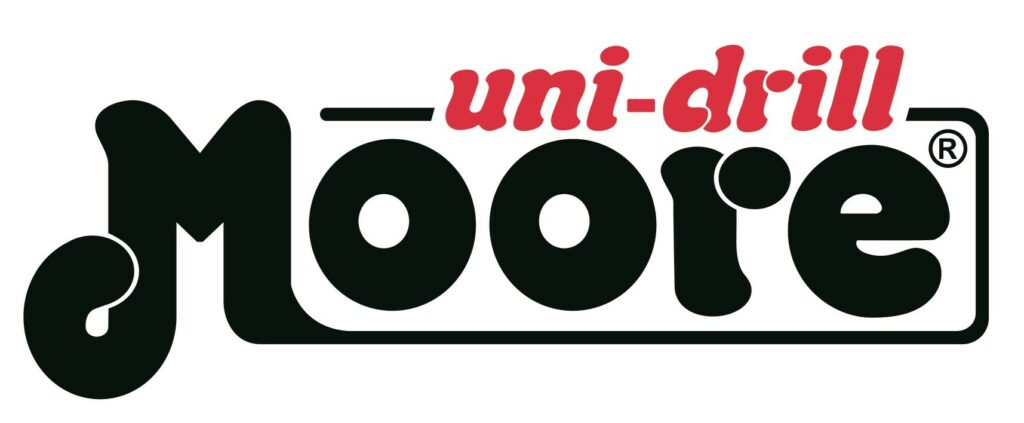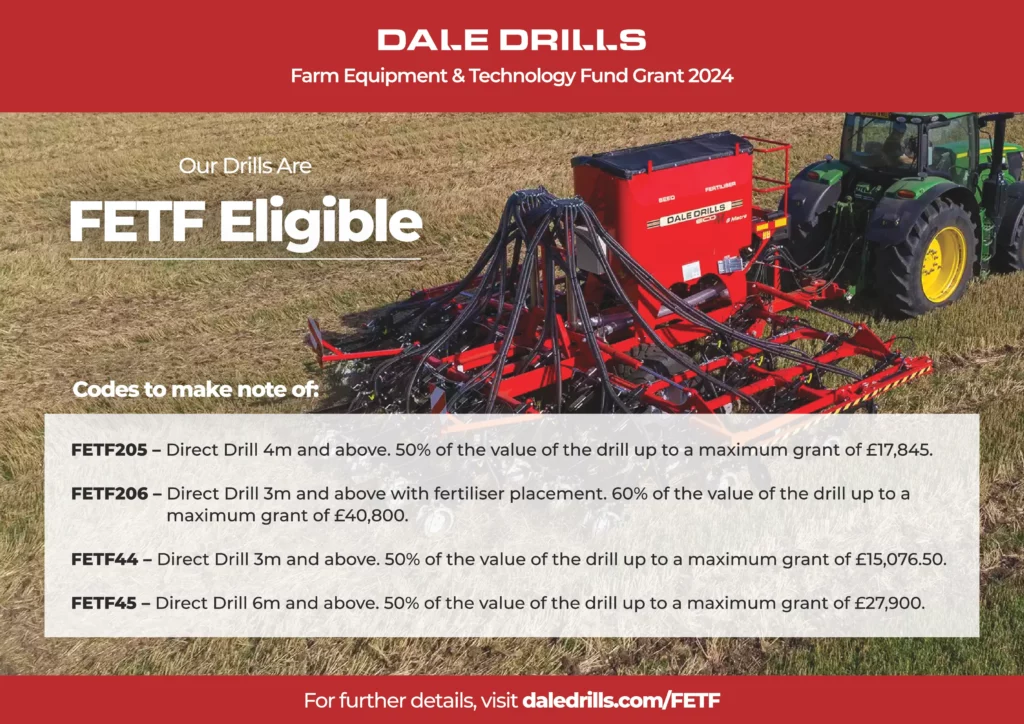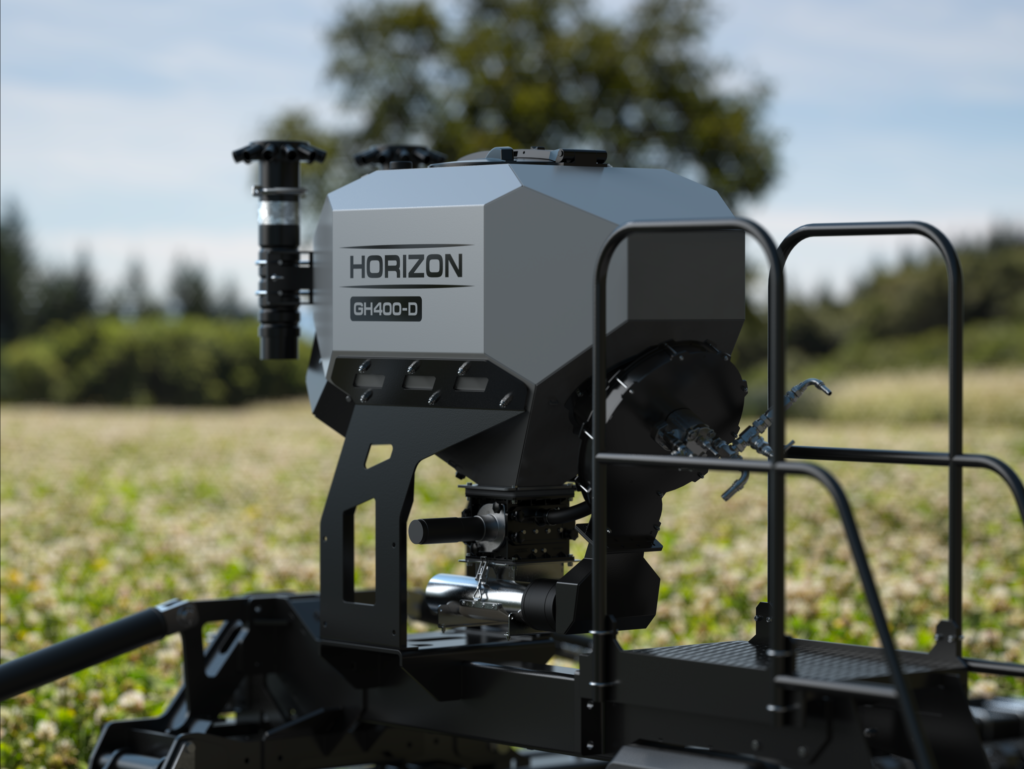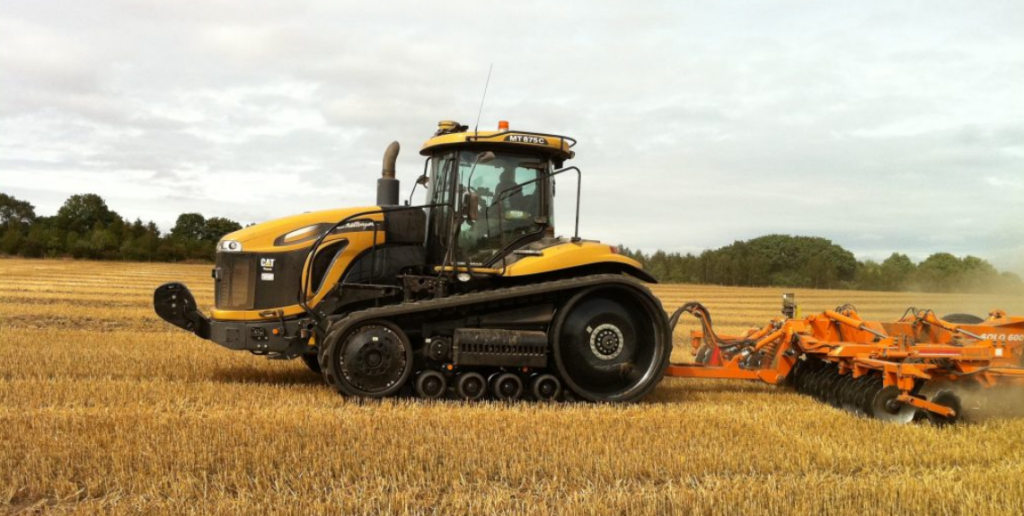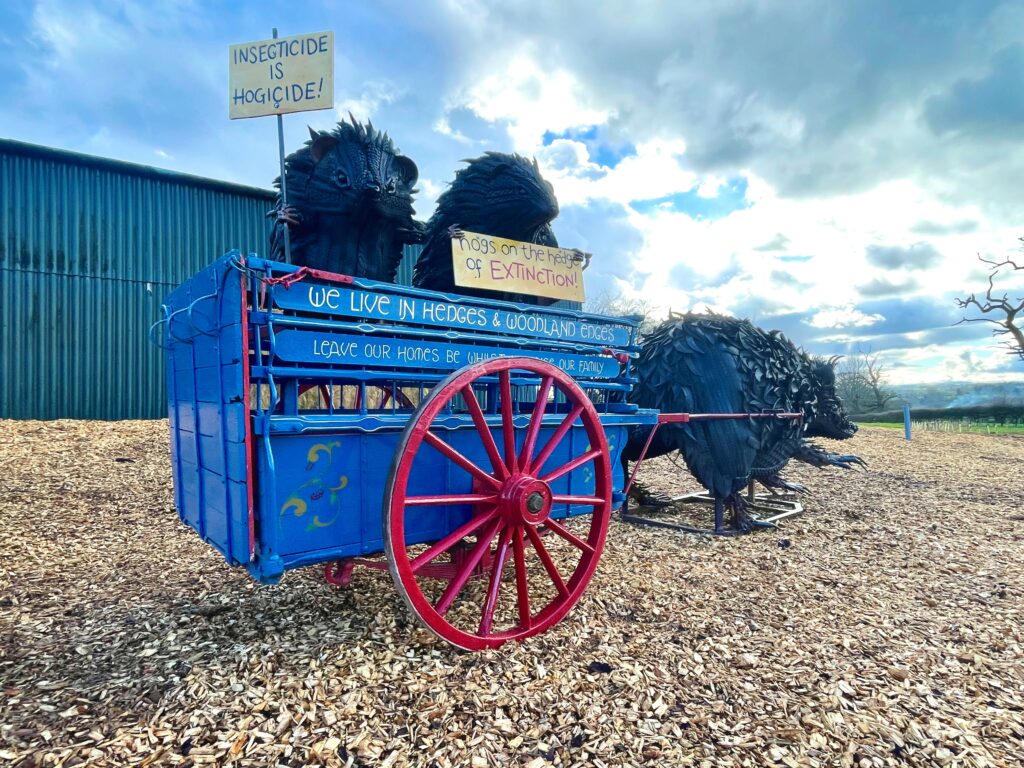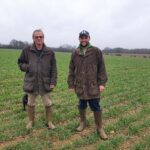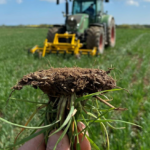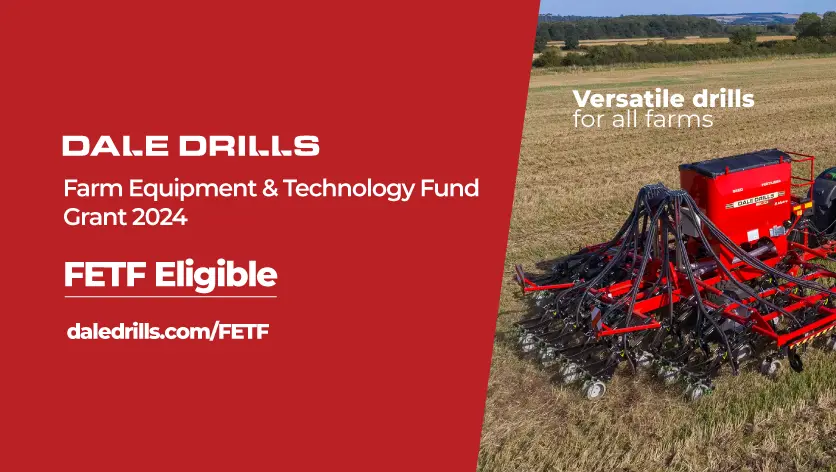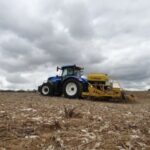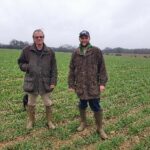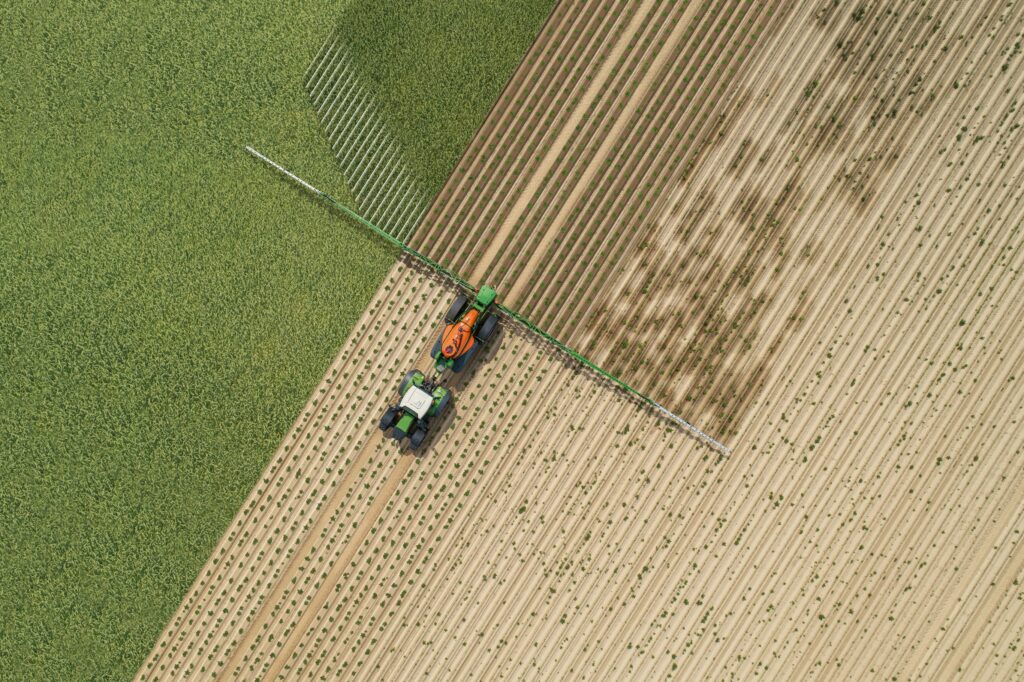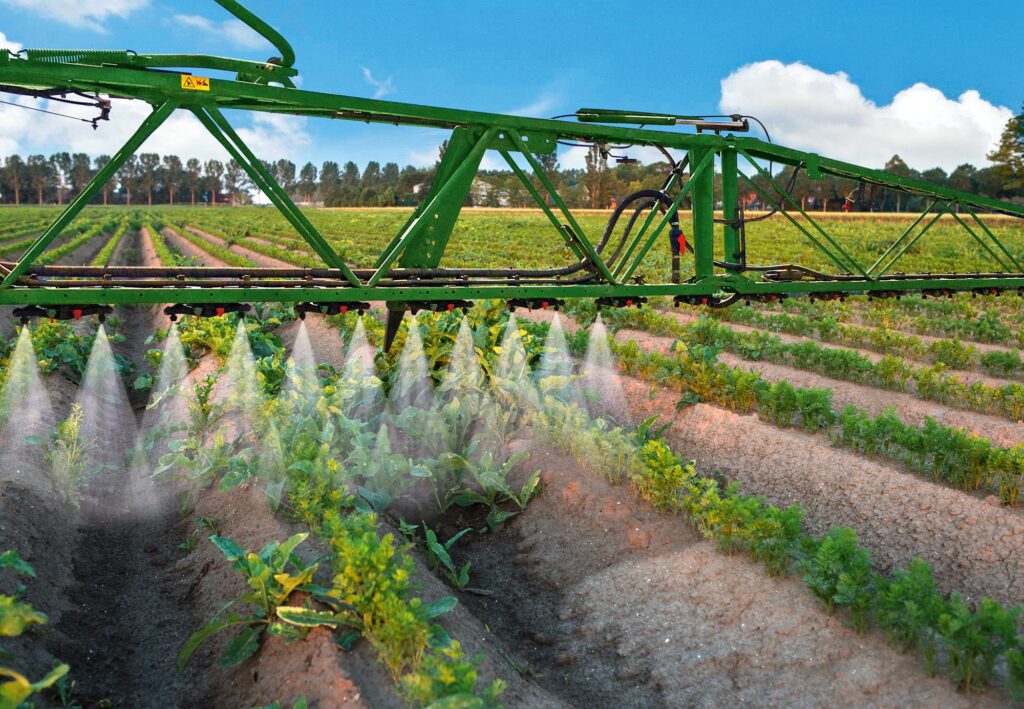If you would like a printed copy of any of our back issues, then they can be purchased on Farm Marketplace. You can also download the PDFs or read online from links below.
-
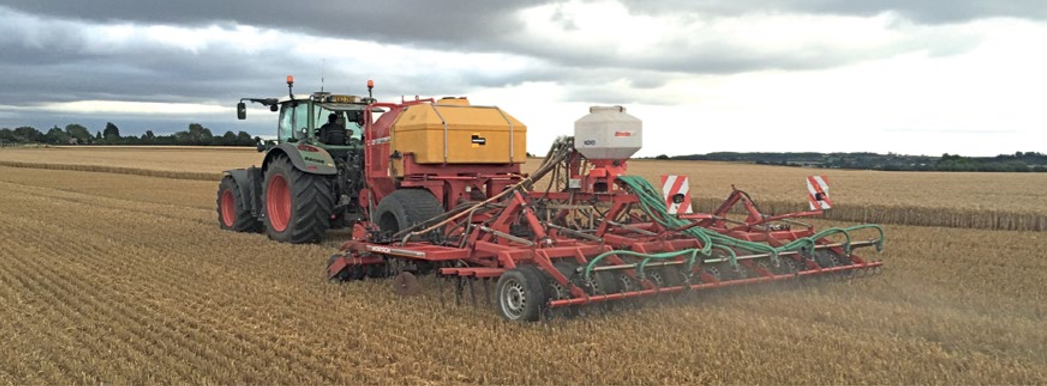
How To Start Drilling For £8K
Clive Bailye’s seed drill of choice is his 6m John Deere 750A , which has been used exclusively for 3-4 seasons. Last year, with an increased acreage, the founder and publisher of this Direct Driller magazine thought a second seed drill was necessary. Having just the one machine was a risk and in a difficult season would mean drilling was delayed. He looked around and found a good condition Horsch CO6 tine drill advertised in Germany.
Words and pictures by Mike Donovan
After delivery he rebuilt the coulters to a narrow profile so as to reduce soil disturbance. He says the tine drill is very useful driling after straw crops such as osr and also through the straw on second crop cereals.
Buying the drill from a German farmer was not particularly complicated, and provided him with a higher spec machine than Horsh sell in the UK. The seed dart tyres are much wider, and the machine is fitted with blockage monitors as well as full width front packers and also a liquid fert application system.
A sheaf of photos were taken, and Clive then asked for some of specific parts to show wear. The deal was done at under £5,000 which Clive says is the market value of these machines which are too large for small farmers to buy. Original owners like to buy new and sell when the machine is still in good condition.
Narrow tines with wear tiles
@Clive knew he wanted to make changes, substituting the Horsch tines and coulters for something far narrower, and has ended up getting his own design of tine made, which has a wear tile made from Ferobide, far harder than tungsten. The drill is on the farm primarily for osr and 2nd crop cereals drilled into chopped straw and the 25cm spacing is okay for these crops.
Comments on Clive’s on-line forum, TFF, said the drill many not be so good with beans, as the slot is a mere 12mm wide. And in barley the spacing may well be too wide as it needs to be thick. Clive points out that the seed pipe can actually be a bit wider than 12mm as it is in the shadow of the point. It would be good to have the option of using it for beans.

Above left: The cheap CO6 is being calibrated ready for its first outing

Above right: The adapted Horsch is being filled by the home built drill logistics trailer with seed and liquid starter fert.
Getting around the German instructions
The Horsch came, of course, with a control box and instructions in German. More on-line discussion revealed that English instructions were available on the Horsch website, and another explained that Horsch was sourcing some of these parts from Agton in Canada anyway. Zealman from New Zealand explained that the button marked with callipers should be held down for around 5 seconds. The menu is where you adjust the tramline sequence, valve layout and row numbers.
Ball hitch is a continental standard and provides a positive connection between tractor and drill

The Stocks Wizard has a rotor modified for Avadex which otherwise leaks everywhere
A Stocks Wizard is on the back of the drill and used for Avadex. Here again the knowledge of actual farmers is helpful. Alistair Nelson warned that the rotor and the surrounding shroud need to be changed, and he got good advice “from Rick at Stocks”. Clive has the same setup on the 750A and says that the Avadex leaks everywhere unless the modification is made. The drill was acquired and modified in 2016 and the results have been excellent.
The machine went through the residue without many problems and having the second drill has meant more timely planting. Clive has shown that moving into No-Till is not the expensive exercise so many farmers think it might be. The total cost, after modifications which included replacing all tines and coulters, was under £8,000.
Author Mike Donovan writes: we have featured a number of home made direct drills in @Practical Farm Ideas, and are always interested in seeing more. Please contact mike editor@farmideas.co.uk or 07778877514.
-
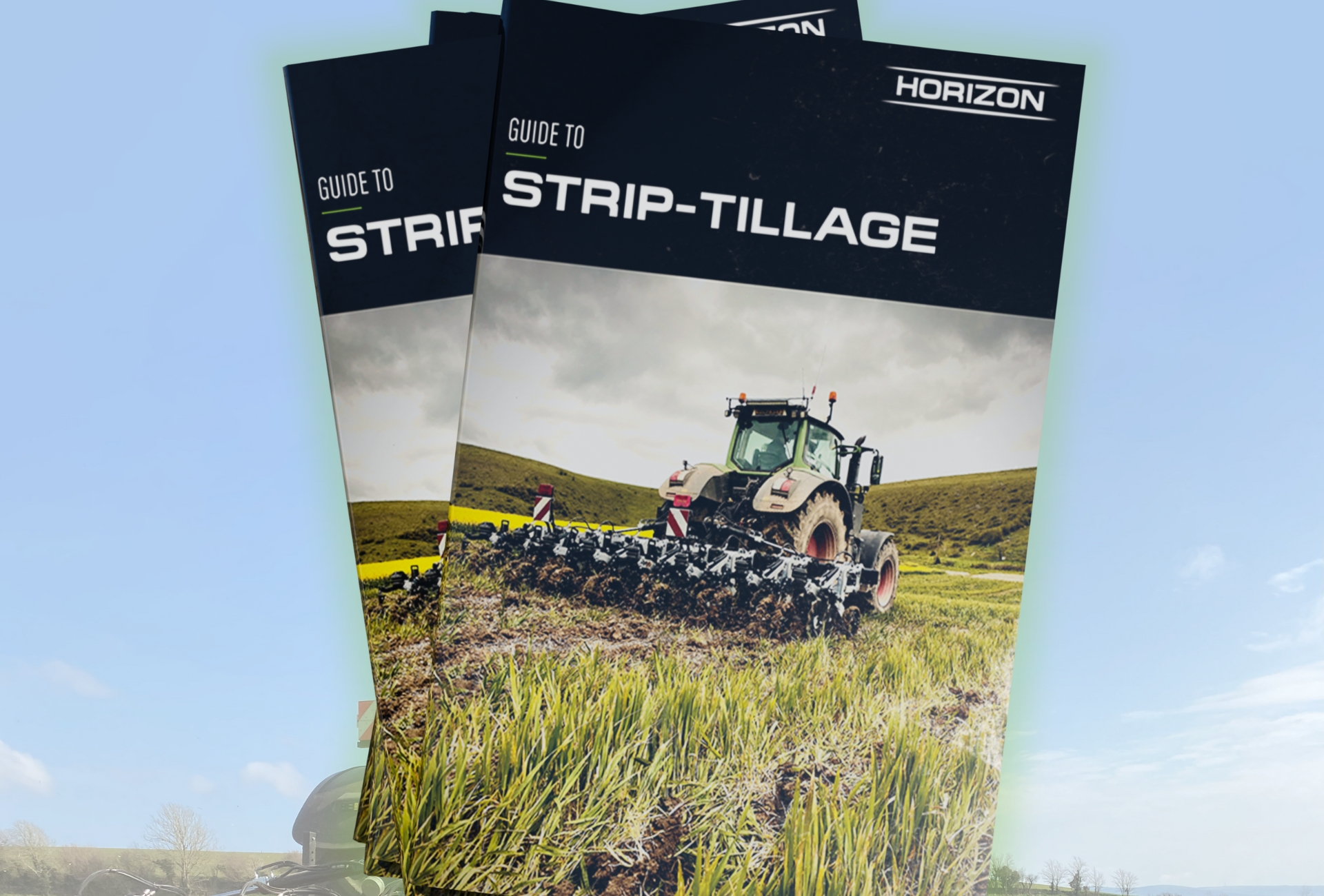
Strip Tillage – A viable option for UK row crop growers who want to reduce soil movement
Written by Horizon Agriculture. See Horizon in the Drill Arena for Direct Driller at Cereals 11th & 12th June, Bygrave Woods, Newnham Farm, Herts
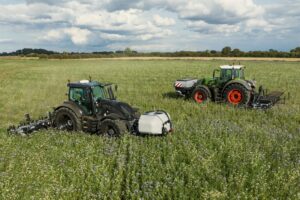
With over 15 years’ experience successfully applying strip-tillage practices across the world, we decided to put together a guide summarising the applications, benefits, challenges, and effects of strip-tilling. To learn more, visit the SPX Strip Till product page, or take a look at the guide directly by clicking here.
As part of our mission to design innovative products that promote soil regeneration whilst also helping our customers to improve their productivity, yield and profitability, we recognise that many farmers will require a transitional period when moving towards a no-till system. We hope to empower farmers to adopt more sustainable practices by sharing our knowledge and experience.
Below is a brief summary of strip-tillage and the benefits it has for farmers looking to transition to a no-till system from fully cultivated soils. For more specific and technical information, including detailed explanations on the effects on the soil, different applications and methods etc, make sure to check out our strip-till guide.
What is strip tillage?
Strip-tillage combines the benefits of conventional tillage with the conservation-friendly advantages of no-till farming. The low disturbance, targeted tillage approach consists of only cultivating a narrow band of soil in which the crop is to be planted, leaving lanes of uncultivated soil and residue on either side. This process reduces risks of erosion, improves soil structure and enhances soil health, and is perfect for farmers looking to transition from conventional tillage to a much more sustainable no-till approach.
Summary of Strip-Till Advantages Over Conventional Tillage
- Fuel Savings – reduced primary and secondary tillage passes.
- Fertiliser Savings – Banding fertiliser to only cover the required areas can reduce rates by 30%.
- Reduce Soil Erosion – Most of the soil remains covered with crop residue throughout the year.
- Alleviate Soil Compaction
- Weed Control – Cover crop residues can suppress weeds between the strips.
- Maintain Levels of Soil Organic Matter – Less soil movement and therefore less mineralisation occurring.
- Improved Water Retention – Fewer cultivation passes results in the soil surface between the strips being covered with crop residue.
- Yields Similar to Conventional Cultivation
- Improved Travelability in Wet Harvest Conditions
-

Come and see Moore Unidrill Ltd at Cereals 2024
Come and see the very latest Moore Unidrills at Cereals and see how far we have come in 50 years. Same name, same system, same vision – Perfecting direct drilling since 1974.

Trailed Moore Unidrill with hopper extension. – Courtesy of ST Agri – Norway distributor. Catch up on the rest of the latest News and Updates
Dale Drills: Update on the Farm Equipment & Technology Fund 2024 (FETF)
With the approaching deadline of the first round of applications for the Farming Equipment &…INTRODUCING THE GH400 MODULAR GRANULAR HOPPER
Horizon Agricultural Machinery is excited to announce our new small granular hopper, the GH400! Available…Issue 27 – Contents
Inside this issue: Introduction – Issue 27 – Following the money To be or not…
Introduction – Issue 27 – Following the money
It looks like arable movers, shakers and advisors seem to be moving away from yield,…
To be or not to be
Never fear, I’m not venturing into Shakespeare here. Not only are my writing skills lacking,…
Farmer Focus – Ben Taylor-Davies
January 2024 Neurodiversity and oubaitori, 2 words that presented themselves to me towards the end…
-
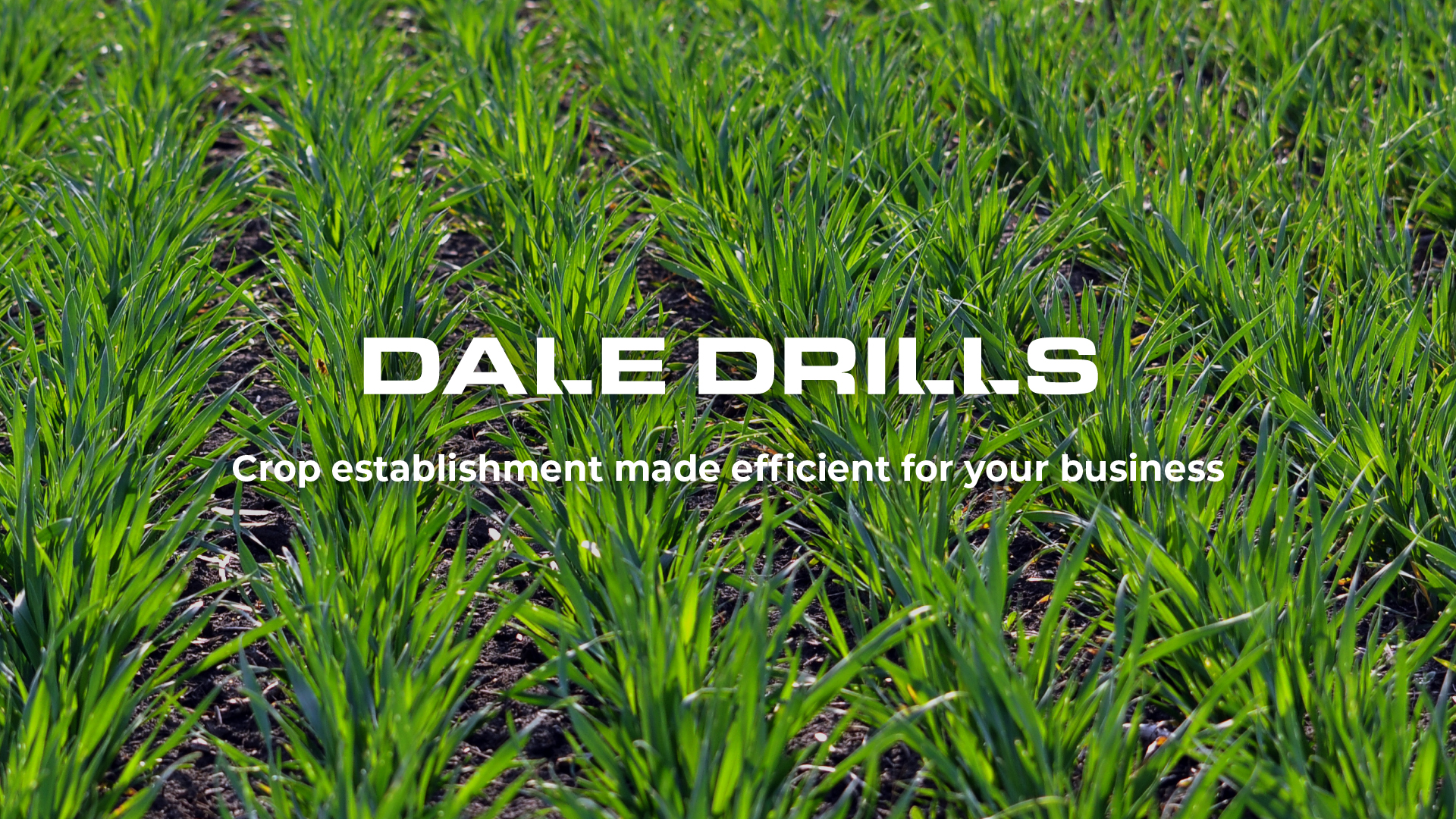
Dale Drills: Crop establishment made efficient for your business
Written by Dale Drills . See Dale Drills in the Drill Arena for Direct Driller at Cereals 11th & 12th June, Bygrave Woods, Newnham Farm, Herts.
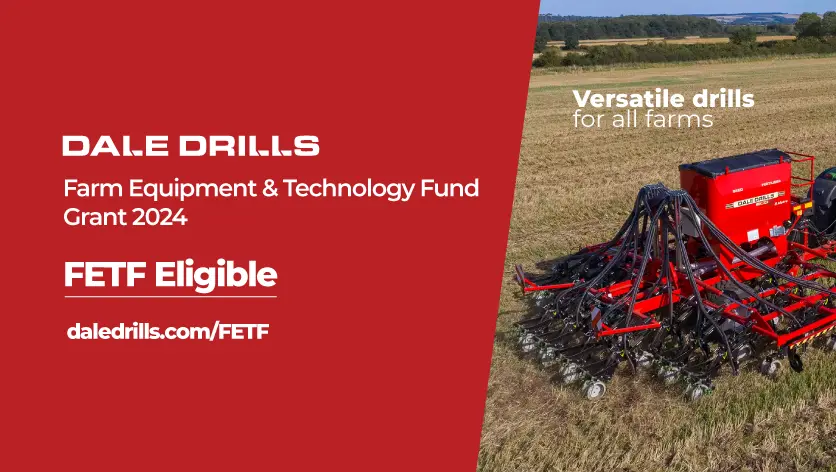
Dale Drills confirms that its range of No Till Seed Drills once again qualifies for inclusion in this funding program.
All pertinent contact details and an overview of their applicable product range can be accessed through their website, Dale Drills
Applications close 17th April 2024
Dale Drills’ range of Eco Drills presents farmers with an opportunity to efficiently establish crops while promoting healthier, more robust soils that foster higher yielding crops. But how do our drills achieve this?
The Eco Drill range employs low-disturbance tines, minimising the horsepower requirement to just 20hp/m (allowing a 150hp tractor to comfortably pull a 6m Eco M). This reduced power demand enables the use of wider working width drills (ranging from 3m to 13m) on relatively modest sized tractors, increasing output to save time and reducing fuel consumption. The lighter weight and smaller size of the tractor, coupled with the broader working width of the machine, minimise machinery pressure on the soil and decrease the compacted area, thereby ensuring optimal conditions for crop establishment.
Featuring a 12mm wide tungsten carbide tipped tine coulter, the Eco Drill offers straightforward, low-maintenance drilling in all conditions. Fabricated in Britain, these tungsten carbide tines provide exceptional durability, significantly reducing metal wear costs to approximately £1 per acre, and minimising downtime during the drilling season. The forward-facing design of the Dale point ensures an ideal seed zone, facilitating adequate seed-soil contact and preventing smearing, even in heavier or wetter soils.
The drilling assemblies, capable of independent movement, are mounted via a parallel linkage to the chassis, ensuring accurate contour following. This feature guarantees optimum seeding depth across the drill’s width, promoting uniform crop emergence and reducing the need for additional cultivation passes to level seedbeds, thereby saving time and money.
An adjustable hydraulic pressure system to the drilling units allows users to tailor the drill for various conditions, ensuring compatibility with different seedbed types, from firm direct seedbeds to looser minimum till and conventional plough-based seedbeds. This versatility ensures accurate seed placement no matter what condition the seedbed is in, optimising yield and increasing farm profitability.
Standard row width adjustment ranges from 12.5cm to 25cm (5” – 10”), with an optional 50cm (20”) kit available for users seeking the flexibility to plant crops at optimal spacing for maximum yield.
For 23 years, Dale Drills have supplied drills capable of sowing seed and fertiliser. The hoppers, painted with vehicle and machinery enamel, are effectively protected against potential corrosion from fertiliser. Specialist metering devices ensure longevity and precise fertiliser delivery. Depending on specifications, the Eco Drill can deliver fertiliser to one side, underneath, or mixed with the seed on 5”, 10”, or 20” row spacings.
Notably, the company has observed users employing multiple crop species through the Seed & Fertiliser system, either for companion cropping or sowing cover crop mixes with varying seed sizes. This inherent versatility enables users to adapt to evolving farming policies without the need for additional equipment expenditure, thereby minimizing costs.
Our Eco and MTD drill range all qualify for the FETF grant. For those considering the acquisition of one of our drills and are interested in leveraging the FETF, contact us today to explore how Dale Drills can be a strategic partner in your journey towards efficient and environmentally conscious farming.
-

Claydon – good for your pocket & good for the environment
Written by Claydon Drills . See Claydon in the Drill Arena for Direct Driller at Cereals 11th & 12th June, Bygrave Woods, Newnham Farm, Herts.
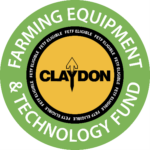
If you miss the application window for an FETF grant, you can still buy a Claydon and save £000s in your first year, just in fuel costs alone.
Hear more from Our customers – Claydon Drill Seed
Farmers using Claydon Opti-Till tell us they are saving tens of thousands of pounds every year on establishing their crops. But it’s the environment that also benefits.
Reducing insecticides
“After a year or two we started to notice important benefits and those have continued to become both more apparent and more significant. The 2019 season, for example, was the first in which we did not have to use any insecticides on wheat or spring barley as there were so many beneficial insects which took care of any pests.” A Axelsson, Sweden
Reducing fungicides
“Air infiltration is much better between the seeded rows and within the crop. This means we have been able to lower our dose of first fungicides by 50%. The farm also uses less phosphate – 30 vs 50u. With the Claydon system we are also able to inter-row hoe.”Reducing soil erosion
“It’s also about the benefits to the farm and the wider environment of protecting soils from erosion. We have some light, drought-prone land towards the coast that, under conventional tillage is prone to soil being washed away in heavy rain. With the uncultivated strips it leaves between the drilling rows, the Claydon system helps minimise this problem, while also retaining moisture in dry conditions.”Reducing soil blow
“It does an excellent job of retaining moisture and because much of the land is left uncultivated the stubble and root structures are retained, this helps to prevent soil blows which are common in Norfolk where light soils are over-worked.”Reducing chemicals
“The Claydon Straw Harrow is a key part of the system in managing stubbles between harvest and establishing the next crop. It spreads any residues remaining from the previous crop, creates a fine tilth which encourages weeds and volunteers to grow and helps to control weeds and slugs mechanically rather than with chemicals.”Improved water infiltration
“One other benefit which I am pleased to see is that our worm population has increased significantly because of the reduced soil disturbance with direct seeding. The channels which they create really help to move water from the surface and distribute it throughout the soil profile, which eliminates surface ponding.”Spring demo opportunity
Freshen up soil and remove tightness for your seeds this growing season. Contact your local dealer for a demo: https://claydondrill.com/dealers-distributors/
For more information about how Claydon drilling can help you establish your crops in a challenging climate, whilst maintaining yields and reducing costs, pls visit claydondrill.com or contact your nearest Claydon dealer.

-
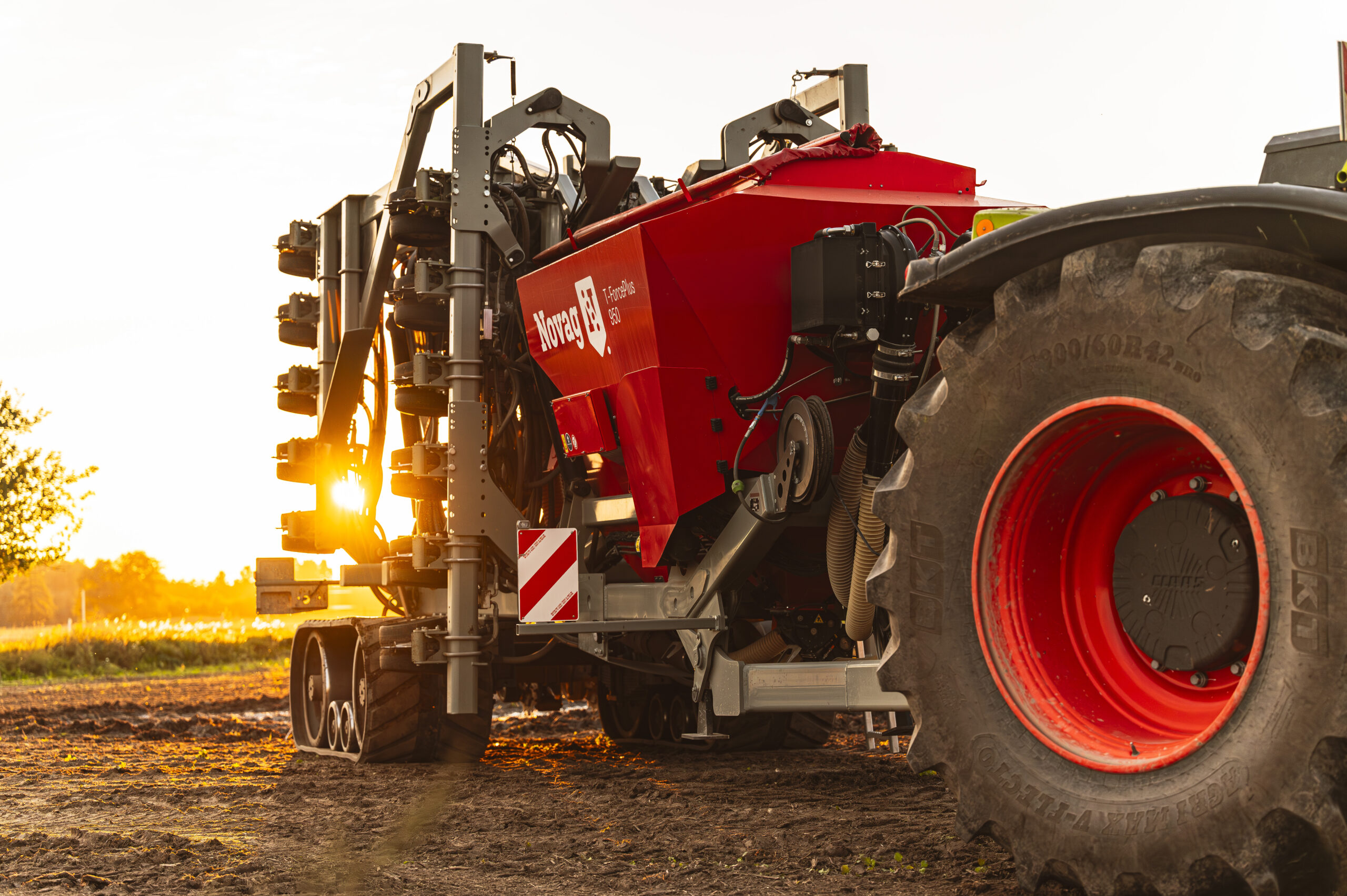
The Gentle Giant: Novag T-ForcePlus 950
Article written by Novag SAS
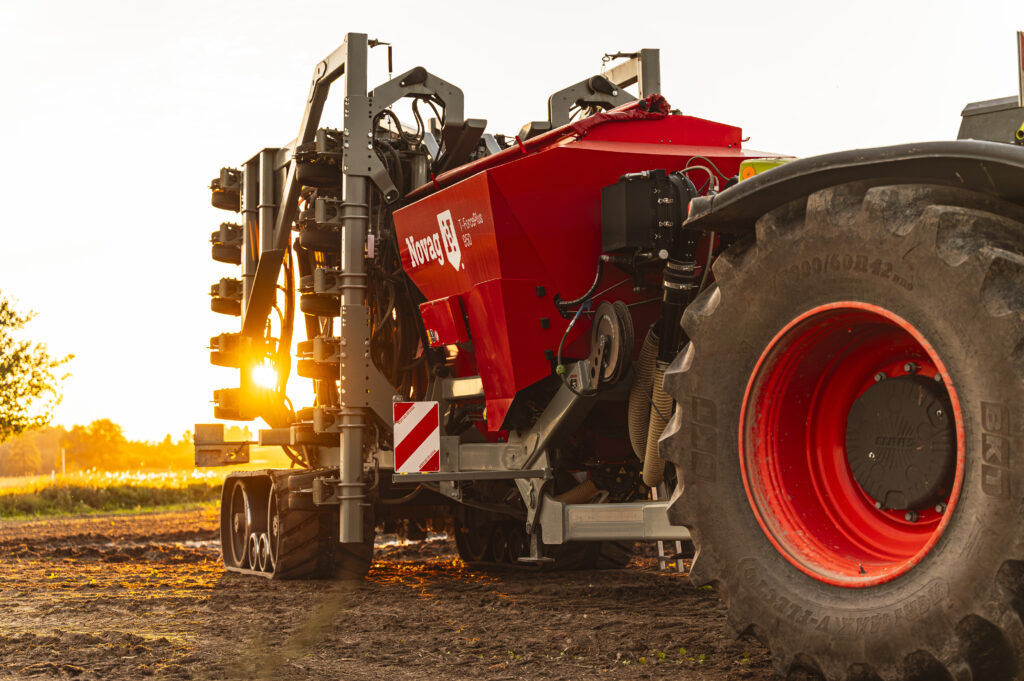
With the new T-ForcePlus 950, Novag has succeeded in solving the conflict of objectives between high productivity, minimum ground pressure and high coulter pressure for no-till. The result is a powerful flagship that is gentle on the ground thanks to its tracked undercarriage and can also be flexibly ballasted depending on the soil type.
With up to 48 coulters (18.75cm row spacing) and working speeds of up to 12km/h, the 9m machine achieves outputs of almost 10ha/h.
New dimensions
For the new Novag T-ForcePlus 950, the frame has been reinforced and is now double foldable. This gives the 9m machine transport dimensions of 3m width and 3.95m height. When folded out, two additional wheels support the frame in the outer area and distribute the weight evenly across the entire working width. This, in combination with a new tracked undercarriage concept, ensures smooth running on the surface and precision at depth.
The seed/fertiliser tank has been enlarged, redesigned and positioned further forward than on the smaller models. This improves tractor traction and makes the tank more accessible for calibration and filling. The standard tank holds 7,700l and can be divided into 3,650l/4,050l or 5,000l/2,700l as required thanks to a flexible centre wall. Optionally, two additional tanks of 350l each are available for further seeds and granules. The additional volume can be added to the rear main tank if required.
The Novag T-ForcePlus 950 is 9.5m long and weighs 18t when empty with a row spacing of 25cm or 36 coulters. Each coulter requires an average of 10hp traction power. The smallest possible row spacing with 48 coulters is 18.75cm, so that the new Novag T-ForcePlus 950 requires a pulling force of 360hp or more.
Flexible use
For a no-till machine of these dimensions, the Novag T-ForcePlus 950 is relatively compact thanks to the intelligent frame concept. As a result, it performs very well even in prepared soils, such as those found on many farms that are still in the process of conversion. If, on the other hand, you are working consistently in a no-till system, the soil is firm and requires high coulter pressures. In this case, the Novag T-ForcePlus 950 can be ballasted up to 6,400kg if required.
New tracked undercarriage
When fully ballasted, it can reach a total weight of up to 26t with 48 coulters and a full tank. In order to distribute this load as gently as possible to the soil, the new no-till machine has been given a robust track with a very flat stud profile and a contact area of 2 x 1.3m², which does not damage the soil even during turning manoeuvres thanks to a special suspension system. The innovative suspension concept reacts flexibly to the load by changing the tension of the treads. “For European markets, we will also offer the caterpillar undercarriage with a brake system in the future,” Ramzi Frikha emphasises.
Reinforced seed metering
Despite the large working width and high working speed, the tracks and support wheels guide the seed bar evenly and smoothly over the ground. For precise seed placement, especially of heavy seeds such as beans or peas, a powerful seed metering and distribution system is required at the same time. Air flow, distribution and piping systems have been adapted accordingly. The Novag T-ForcePlus 950 has a double fan system with telescopic distributor heads that improve the seed flow.
Unique coulter system
At the heart of the new 9m model, as with all other Novag direct seed drills, is the unique Novag T-SlotPlus coulter system with IntelliForcePlus automatic coulter pressure control. It ensures precise seed placement in the soil without moving it significantly. 90% of the soil cover remains undisturbed during sowing. The specially shaped sowing coulter cuts an inverted “T” into the soil. A notched disc cuts the outcrop or stubble and opens the soil. Two separate sowing boots are located on the cutting disc to clear the seed furrow. They each have an outlet through which either seed or fertiliser can be placed at the optimum distance from each other. The T-shape of the sowing boot and the slanted press wheels guarantee an optimally closed seed slot. This means that the deposited seed is always in contact with the ground, even in dry conditions. The sowing depth can be individually adjusted from 1 to 10cm on all implements and the sowing coulters are prepared ex works for liquid applications (fertiliser, compost extract, enzymes, etc.).
Simple operation
Thanks to the high coulter pressure of up to 500kg per seed coulter, the Novag T-SlotPlus coulter system always guarantees optimum seed placement even in difficult no-till conditions with heavy biomass growth and hard soil. Likewise, the IntelliForcePlus automatic coulter pressure control always delivers top working results, even for inexperienced operators. Additionally, all Novag direct seed drills are now Isobus-prepared at the customer’s request, so that machine functions such as application maps for site-specific sowing can be conveniently controlled via the tractor terminal.
Reducing machine and labour costs
Six years of development work have gone into the Agritechnica model. “We are now also offering our 8m model, the Novag T-ForcePlus 850, on this new platform and are already working on a 10m machine, a Novag T-ForcePlus 950X. In this way, we are also giving larger arable farms access to the ecological and economic benefits of no-till. All our customers, regardless of farm size, benefit from significantly lower machinery and labour costs, whilst simultaneously saving water and improving their soil quality,” reveals Ramzi Frikha.
-

Maschio Gaspardo experience at your service!
Article written by Maschio Gaspardo
The MASCHIO GASPARDO in-line direct seed drills are the product of recognized experience and accumulated knowhow to which whole generations of both engineers and farmers have contributed over almost two centuries in the business. Today, MASCHIO GASPARDO offers a comprehensive range of direct seed drills to cater to the demands of farmers and contractors, with an array of highly adaptable products with plenty of configuration options that place seeding quality, environmental sustainability and return on investment above all else.
MASCHIO GASPARDO’S BACKGROUND IN DIRECT DRILLING
In 1989, MASCHIO GASPARDO produced DIRETTA, the first in-line seeder for drilling seed into untilled soil. Today, nearly 35 years on from that first model, MASCHIO GASPARDO continues to perfect its creations, introducing innovations that have allowed our direct drilling machines to set a benchmark for farmers and contractors.
The direct drilling range features models with mechanical or pneumatic distribution, and both fixed and folding frame versions.
MASCHIO GASPARDO SEEDING UNIT
The MASCHIO GASPARDO seeding unit, designed and manufactured entirely by GASPARDO delivers reliable, quality direct drilling, regardless of seed type and actual conditions in the field, even where there is a lot of trash material to contend with. The considerable down pressure (up to 250 kg) allows it to easily cut a seeding line even through tough soil. Seeding depth remains constant thanks to the independent furrow-opening and furrow-closing movements. MASCHIO GASPARDO direct seed drills offer an extensive range of adjustments, to better adapt to soil conditions and the farmer’s own preferences.
- Unit height spring: adjust soil cutting depths
- Clothing wheel pressure adjustment spring
- Seed press wheel arm operated independently
- Interchangeable depth gauge wheel
- Disc coulter of 475mm
- Interchangeable wear resistant cast iron shoe
- Closing wheel with soil scraper
WHY THE GIGANTE PRESSURE?
Pneumatic seed drill with pressurised hopper – The GIGANTE is MASCHIO GASPARDO’s flagship model in the direct drilling range with pneumatic seed and fertiliser distribution, available in both fixed and folding frame versions. The innovative pressurisation system optimizes distribution efficiency from the hopper to the seed furrow. With the hopper’s lowered centre of gravity, GIGANTE PRESSURE’s manoeuvrability is second to none, even when faced with steep slopes.
- Liftable seed-covering harrow
- Short distribution tubes
- External mixing head
- Hermetically sealed pressurised hopper
- Low centre of gravity
- Wide liftable wheels
- Optimal distance between rows
- Electrically driven seed + fertiliser metering units
- Steering drawbar up to +/- 90°
- ISOBUS communication
ISOBUS DIGITAL SEEDING
The metering units’ electric-drive system makes GIGANTE PRESSURE a fully digital control solution. The tractor’s ISOBUS terminal handles seed calibration and work parameter control. In addition, it allows you to access the Precision Farming.
Advanced ISOBUS monitoring functions (read+precision farming):
- TERRA 7 functions
- Prescription map import
- Geo-referenced seeding data export
- Automatic seeding shut-off
- Variable input rate
- Backlit 8″ graphic display
CENTRALIZED GREASING
A feature unique to GIGANTE PRESSURE is the centralised greasing point, conveniently located on the side of the machine, to which the rotating pins of each unit are connected.
This optional kit lets you reduce the additional time taken to perform routine maintenance on the seeding units.
-
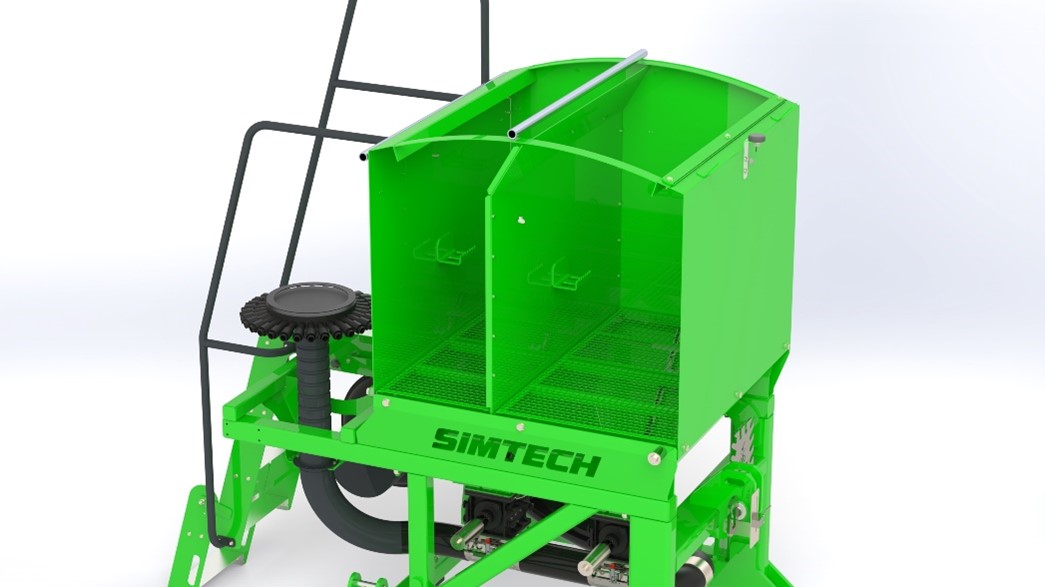
Split Hoppers Available for 2024
Article written by Fentech Agri
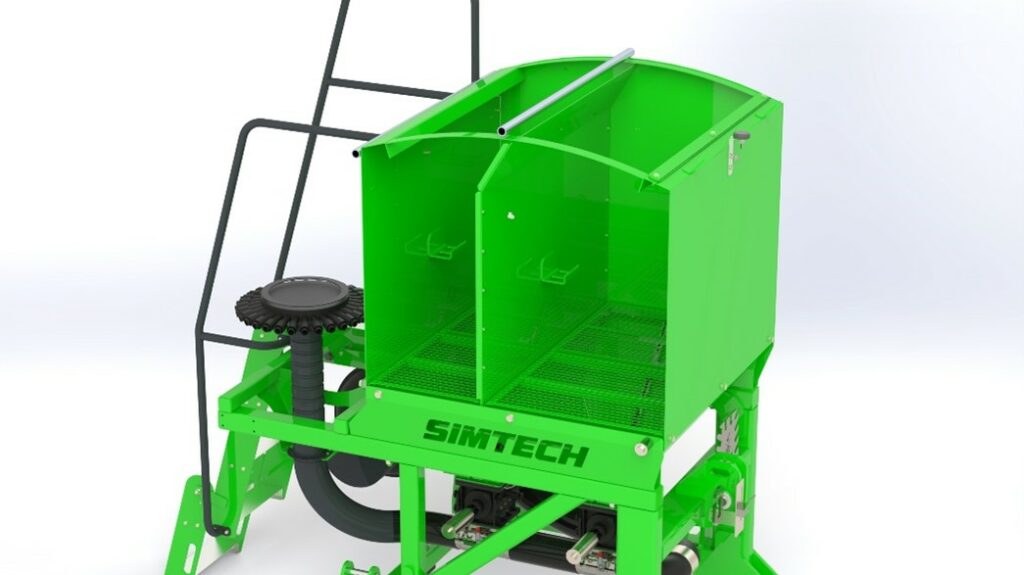
Fentech Agri has been working on offering split hoppers over the complete pneumatic range of Simtech seed drills. The requirement for mixing different seeds for companion and cover cropping have become more prevalent as well as being able to offer an integrated fertiliser option for application with the seed.
Fentech agri are pleased to announce a collaboration with Regenovation, a Horizon Agriculture sister company, integrating their proven and well designed metering unit into Simtech products. The Horizon meter allows better packaging calibration and setting. Simtech mounted drills are relatively compact so this was seen as an essential requirement for running multiple meters.https://www.fentech.co/
Machines will still run a single distribution head as standard, mixing the seed down a single hose, however, the option for inter cropping on every other row is possible with dual distribution heads.
Couple the meters with another well proven and well tested control system from MC Electronics proves a reliable, simple system to accompany the reliability and simplicity of a Simtech drill.
All products will be fully supported by our technicians with engineering support from the respective suppliers should it be required.
The new combination will be integrated onto our folding rear hopper machines, splitting the 1700L hopper with a 60:40 ratio. A simple to remove baffle plate allows a single product to be used through both meters if preferred. We are also exploring the use of this arrangement onto front mounted hoppers to accompany our hopperless drill frames, giving ultimate flexibility in terms of drill configuration. With the front tank models, the option to combine a third small applicator hopper mounted to the main hopper and feeding directly into the air flow is also possible.
All new combinations will be available to order now for delivery within the 2024 FETF grant window. Contact our technical team now to discuss your seeding requirements.
-
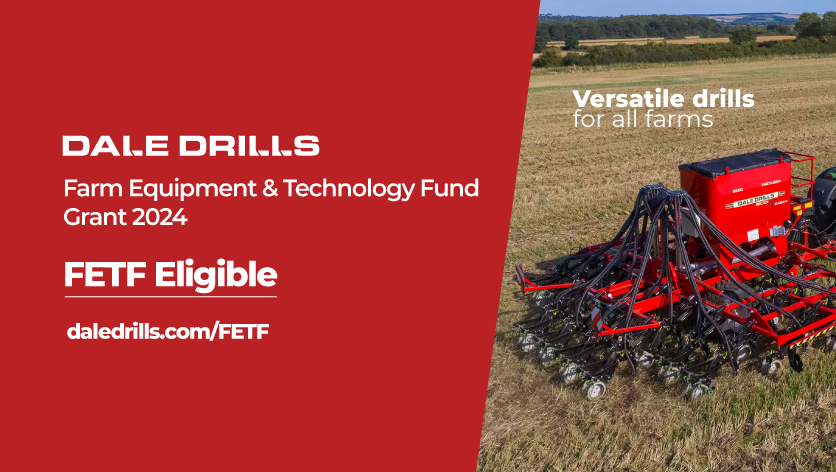
Dale Drills – Farming Equipment and Technology Fund (FEFT) 2024
Article written by Dale Drills
In a recent update, DEFRA has disclosed the imminent opening of a new phase for the Farming Equipment and Technology Fund (FETF) grant applications. This funding initiative serves as a valuable resource for farmers looking to invest in cutting-edge equipment and technology, with the aim of enhancing productivity and promoting environmental sustainability.
Dale Drills is delighted to confirm that its range of No Till Seed Drills once again qualifies for inclusion in this funding program. In the previous cycle, numerous customers, both new and existing, successfully secured FETF grants to support their investment in a new machine from our ECO and MTD seed drill range.
For those considering the acquisition of one of our drills and are interested in leveraging the FETF, we encourage you to reach out to our sales team promptly. Given the high demand, our build schedules tend to fill up rapidly. Therefore, it is advisable for anyone intending to apply for the FETF with the intention of acquiring a Dale Drill to make initial contact as soon as possible. All pertinent contact details and an overview of our applicable product range can be accessed through our website, https://daledrills.com/.
Dale Drills remains committed to assisting farmers in optimising their operations through innovative equipment, and the FETF presents a valuable opportunity for those seeking to integrate our seed drills into their farming practices. Don’t miss the chance to enhance your productivity and contribute to a more sustainable agricultural landscape. Contact us today to explore how Dale Drills can be a strategic partner in your journey towards efficient and environmentally conscious farming.
-
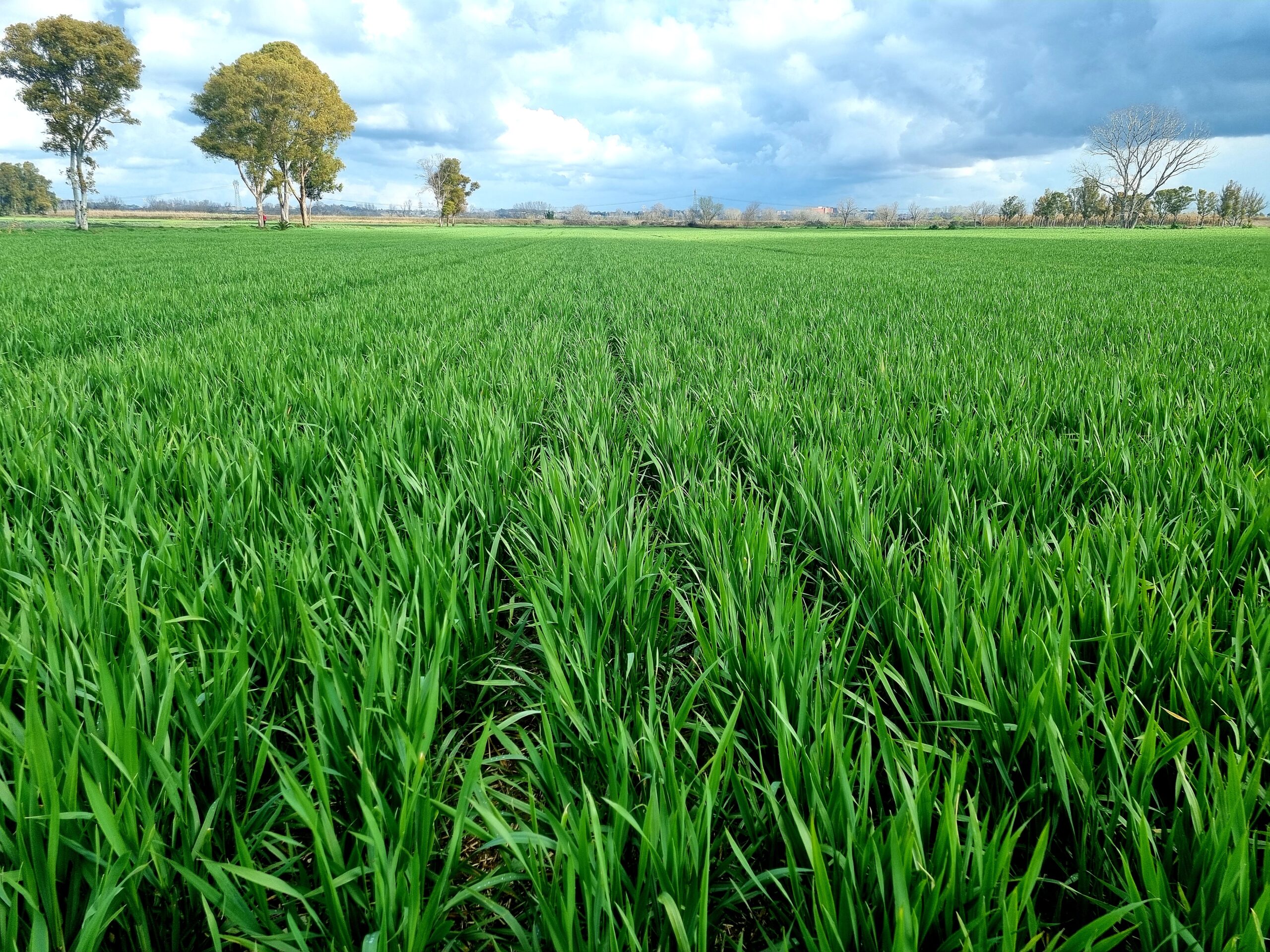
Claydon Drills – Reduce your costs and improve your yields
Article written by Claydon Drills
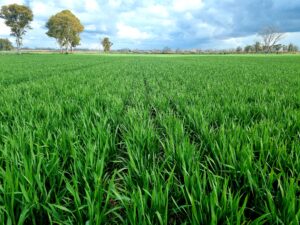
Drilling direct and eliminating unnecessary cultivations can save you thousands in establishment costs every year, and the Claydon Opti-Till® system does just that. Compared to conventional establishment it saves approximately 60% on costs with a time saving of around 80%.
What sort of savings have Claydon customers experienced in their first year?
“Fuel is one of the big areas for saving with Opti-Till®. With the plough-based system our 15,000-litre tank had to be filled five times a season, now the tanker visits twice, which is 60% less. With fuel prices where they are that represents a major saving.” S Middleton, East Yorkshire
“In the first year that drill saved us 30,000 litres of fuel compared with our previous system . . . but there were numerous other immediate benefits in terms of timeliness, time saving, better crops and much lower costs.” T Saunders, Northants
It’s not just diesel, there are other ways to save…
“Establishing crops now needs so little power that I sold one of my two 550-gallon fuel tanks because it was no longer needed.”“One of the key benefits of OptiTill® is that it allows us to farm more land with less labour and machinery. Recently, we cut costs even more by reducing the number of tractors from three to two.”And there are no yield penalties with Claydon direct drilling
Whether farming heavy clays in Lincolnshire or dry, light erosion-prone soils of East Germany, customer experience shows that Claydon-drilled crops have no yield penalty – yields generally improve.
“Field trials have proven that the Claydon system had no detriment to establishment, providing a fantastic rooting zone required by the crop and yields were well above the pea groups set target yields.”“Half of the spring cropped area was established using the previous approach and half with the Claydon. When both were harvested the Claydon-drilled area produced 0.5t/ha more yield. The largest yield increases have been in the spring crops due to the Opti-Till® System conserving moisture at planting, especially with the dry springs that we seem to get now.”
P Wilson, Wiltshire“The drill has transformed how we farm and even after a relatively short time of using it the headlands of all our fields look as good and perform as well as the main areas, which has significantly improved average yields and grain quality.”And a little bit of science…

Skyway spring barley was direct drilled by 7 different drill manufacturers as part of the Agrii drill trials in Kent in 2023, comparing different drilling systems. The Claydon Evolution was the highest yielding drill with 7.46 t/ha compared to the site average of 7.06 t/ha, a substantial increased yield of 400 kg/ha over the average. The roots of the Claydon crop were the deepest and most well-developed across all the drills.
The Claydon drill’s leading tine technology is the key to maintaining, or in many cases, improving your yields. It drills direct into stubble and doesn’t turn over the soil, just aerating it in the rooting and seeding row. This means the seed gets the best start in life – friable, free draining soil and access to moisture. Meanwhile, worms thrive and process the surface organic matter, adding to the soil’s fertility. What’s not for a seed to love?
To hear more from our customers visit: https://claydondrill.com/our-customers/
Spring demo opportunity: Freshen up soil and remove tightness for your seeds this growing season. Contact your local dealer for a demo: https://claydondrill.com/dealers-distributors/
For more information about how Claydon drilling can help you establish your crops in a challenging climate, whilst maintaining yields and reducing costs, pls visit claydondrill.com or contact your nearest Claydon dealer.

-
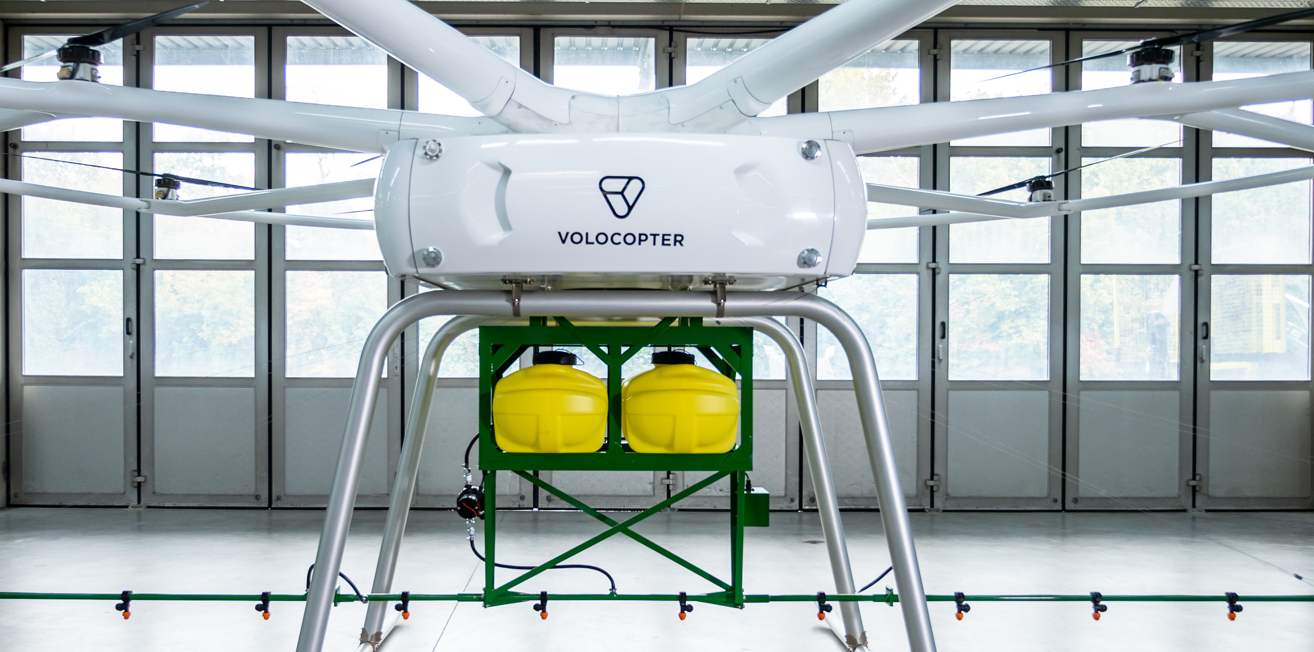
Unleashing the Potential of Agri-Tech
Written by Chris Fellows
In the realm of agriculture, a technological revolution is underway, reshaping the landscape from traditional practices to cutting-edge innovations. This transformation, encapsulated by the term “agri-tech,” is not merely about mechanised machinery or futuristic drones; it represents a multifaceted evolution that spans the entire agricultural supply chain not just changes on farms.
Agri-tech embodies a spectrum of advancements that are revolutionising production, bolstering productivity, and addressing pressing challenges within the agricultural sector. From harnessing the power of Artificial Intelligence (AI) and machine learning to embracing biotechnology and precision technology, agri-tech is propelling agriculture into a new era of efficiency, sustainability, and resilience.
At its core, agri-tech encompasses a diverse array of innovations aimed at optimising every facet of agricultural operations. Whether it’s employing robots for labour-intensive tasks, leveraging AI to enhance animal welfare, or harnessing biotechnological solutions to bolster crop resilience and nutritional content, the impact of agri-tech reverberates throughout the agricultural landscape.
- Artificial Intelligence and Machine Learning
- Biotechnology
- Precision Technology
- Smart Farming
- Vertical Farming and Indoor Agriculture
- Drones and Earth Observation Technologies
- Water Management Technologies
- Aquaculture Technologies
- Livestock Genetics and Veterinary Science
The potential of agri-tech to drive growth, sustainability, and resilience across the agricultural sector is immense. By fostering cross-sector collaboration and embracing farmers as well as farming, agri-tech innovations can unlock new opportunities for agricultural productivity, profitability, and environmental stewardship.
As we embark on this journey of technological transformation in agriculture, farmers need to stand as beacons of innovation. We need to guide the sector towards a future where agriculture is not only productive and profitable but also sustainable and resilient. Farmers and researchers need to work together, listen to each other and create solutions that really drive change not just sound good in a presentation.

-

It’s 2030 – Has food security improved?
Tom Allen-Stevens travels forward to 2030 and looks back at what progress has been made since 2024 to improve agricultural productivity.
What goes around comes around, it seems. The debate about food security and nanotechnology that we’re currently having in the first few months of 2030 has echoes of a very similar discussion that preoccupied many in the industry six years ago. What’s even more interesting is how the seeds of today’s debate were sown (quite literally) in the second issue of Tech Farmer published back in March 2024.
Cast your mind back six years to that time – swathes of the country were under water following what was then one of the wettest winters many of us had experienced, although it seems tame compared with the extremes climate change has thrown at farming since. It came on the back of the first signs of food shortages that then really came to fruition and hit the nation hard during 2025. Empty supermarket shelves started the stir of unease, and it was probably these that prompted Steve Barclay, who was then Defra Secretary of State, to suggest at the Oxford Farming Conference in January 2024 that “food security is national security”.
The call to protect our food security was one the NFU had repeatedly made to successive Conservative governments ever since the UK voted to leave the EU in 2016, as Baroness Batters to this day continues to remind the House of Lords at every opportunity she’s given. But it had fallen on deaf ears as ministers (including the hapless Liz Truss) sold out UK Farming in various bids to grasp at trade deals.
Finally, however, the message seemed to have sunk in. It was even repeated by former Prime Minister Rishi Sunak when he appeared at the NFU Conference in February 2024, and told delegates “I have your back”. Many asked then whether it was too little, too late to save an agriculture that subsequently underdelivered so seriously on the nation’s food needs during 2025. The haphazard way with which the government had thrown its £427M budget underspend on agriculture into productivity measures in the dying days of its last term in office has been the subject of too many Parliamentary Select Committees.
But there was one element of common sense that wove its way into policy at the time, and was thankfully picked up by the incoming Lib/Lab Coalition: the Agritech Delivery Fund. In particular there was the spending committed to genetics and plant breeding, that quite literally sowed the seeds of the advances we have in UK arable fields in 2030.
And that brings us back to the March 2024 edition of Tech Farmer. The issue focused on genetics, and featured on its front cover an article on the latest advances in gene-editing ready to come into the field from John Innes Centre and Rothamsted Research – the article appeared on pxx.
Surely it’s no accident that the same genetic edits found in that Cadenza wheat Professor Uauy held in his hand in 2024 are in the variety that tops, by a country mile, the AHDB Recommended List for 2030/31? An ever-increasing number of growers are now benefiting from the new premium paid by food manufacturers for the low acrylamide Group Three wheats that produce more healthy biscuits and breakfast cereals. And the world’s first commercial sward of high energy ryegrass is due to be cut this spring, with the potential to bring down methane emissions by up to 25% from the dairy cows it’s fed to.
You could argue these advances pale into insignificance compared with the LowN wheats now available to growers across the globe. Biological nitrification inhibition in wheat was largely unknown when the March 2024 edition of Tech Farmer landed (see pxx), but it’s tipped to deliver reductions in nitrate pollution alone of as much as 20% by the middle of this decade, before you even consider the productivity increases that farmers will benefit from.
Interesting too that biotech giants Wild Bioscience (pxx), CDotBio (pxx) and TraitSeq (pxx) were somewhat quaintly referred to in that issue of Tech Farmer as “agtech start-ups”. And those were the days when World FIRA (pxx) was little more than a hackathon with a few odd robots awkwardly manoeuvring around fake vineyards. Just 2500 visitors in 2024 – dwarfed by the crowds who flocked to Toulouse in Feb 2030 to see the latest jaw-dropping advances in fundamental autonomy and AI.
While these advances are awesome, the rather more sobering discussions at the 2030 event revolved around responsible use of technology. Global beef markets are still reeling from the effects of the 2029 nanotechnology scandal, that saw almost $1bn of US beef removed from supermarket shelves and incinerated. The USDA has yet to pinpoint how batches of zeranol growth hormone were contaminated with military-grade RNAi nanotechnology.
The inquiry isn’t being helped by the deep-fake videos circulating on social media that have framed everyone from Chinese terrorists to the US president herself. There is talk that this is an AI breach – a deliberate attempt by non-human intelligence to cause harm, although such a serious breach is fiercely denied by all signatories of the 2023 Bletchley Declaration.
But here in 2030, it’s raised once again the issue of food security, and at its heart is the technology garnered to increase agricultural productivity. So what do we learn from when this was last an issue six years ago?
There was much talk about food security at the 2024 NFU Conference (we didn’t have space for coverage in the March issue, but Tech Farmer did attend). Recriminations were directed at the government for failing to implement recommendations on a National Food Strategy made by Henry Dimbleby (that’s still gathering dust) while questions were asked about a Land Use Framework (that never materialised). Whether these would have staved off the National Food Crisis of 2025 remains a divisive issue.
What was interesting was the approach taken by the Foods Standards Agency on food produced from precision-bred organisms, unveiled shortly after the conference. The new regulations trod the very fine line between securing consumer confidence and enabling new genomic technologies. It set out to be “as efficient and proportionate a system” as it could be.
If 2030 agricultural productivity figures are anything to go by, the approach seems to have worked. Following Brexit, the UK dropped from the top quartile in Europe to the bottom. The most recent figures suggest the UK is back in the top quartile and the trajectory is promising. Arable crops are where the UK performs best, and that’s no surprise given the UK took the steps to ensure enabling legislation, while Europe continued to drag its heels on gene-editing.
But perhaps what shouldn’t be overlooked is the role farmer-led innovation has played in advancing crop genetics. The collaborative platform set up to do this, led by farmers and first described in March 2024 Tech Farmer (p9), now leads the world in testing novel traits – dozens of pre-commercial varieties have passed from the lab to farmers’ fields where they’ve been scrutinised and appropriate agronomy developed. It’s an open and transparent forum that generates trust in new technology. As Tom Clarke wrote in his column at the time: “when farmers collaborate they create value, and are able to capture it too” (p6).
There are considerable challenges with ensuring AI and nanotechnology can be trusted within our food system. But they have to be faced and overcome if we’re to advance as a society. The genetics revolution has shown us that proportionate regulation and the involvement of farmers bring results. So these are challenges we should be ready for.Tom Allen-Stevens farms 170ha in Oxfordshire and leads the British On-Farm Innovation Network (BOFIN).
-
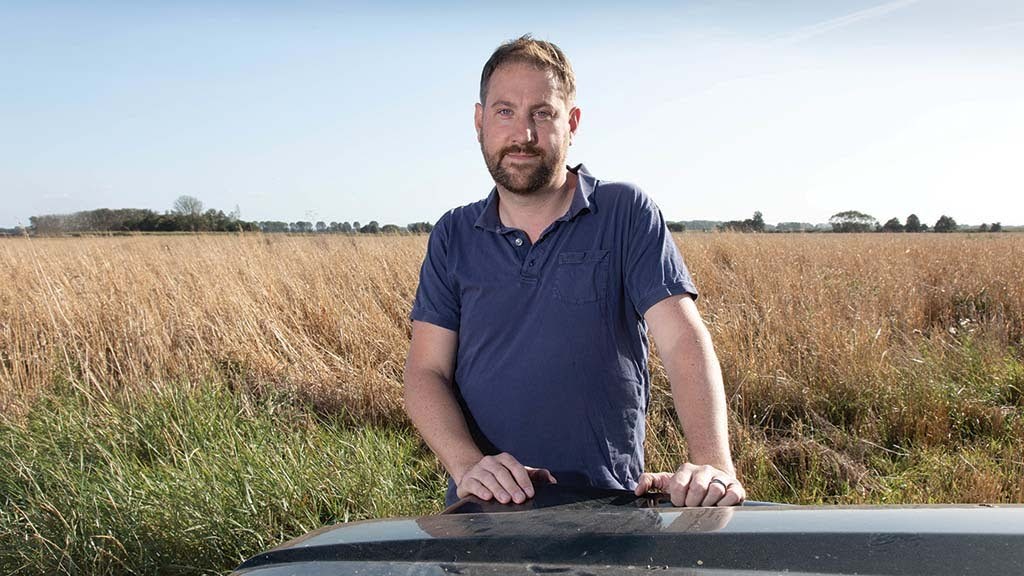
Farmer Focus – Tom Clarke
Write about the future of farming, they said. We’d like your thoughts on the innovations that will help or hinder agriculture in the next 10 years. After I penned a sort of agricultural sci-fi column a few years ago in Farmers Guardian, I’ve clearly gained a reputation.
I actually farm in a fairly low tech way, on a thousand acres (400ha) of lowland peat and silt in the Cambridgeshire fens. Nearly all my machinery is second-hand, rented or has been on our farm longer than me. Yes, we use satellite imagery and GPS to make variable rate applications and seed plans. Yes, I’ve tried releasing sacks of predatory insects instead of insecticide. And yes, I now treat my farm-saved seed with endophytic bacteria which are meant to fix nitrogen from the air. But these are all practical steps driven by financial savings, or open-minded trials which tinker at the edges.
I don’t consider myself very futuristic. If you came to look around my muddy, and increasingly ramshackle farmyard, I think you might agree.
At the same time, I farm differently than my dear old Dad did. I took over from him unexpectedly 15 years ago, when he died from cancer. I hadn’t been a farmer. I was living and working in London as a management consultant. So I came to the business knowing nothing, willing to learn, open to any idea that could prove it might work.
Innovation is more a state of mind than a new gizmo. It’s finding out what works, what doesn’t, and how to do it better.
In the last decade and a half I’ve come to know a lot of farmers – and they’ve shown me there are as many different ways to innovate as there are to cook a potato. For some it’s all about the kit – the diesel heads. For some it’s the quality of the end product, or serving the customer. For increasing numbers it’s all about the soil and “biology”. But for all of us in the years ahead, it will be more and more about remaining economically viable.

Arable farmers are in a uniquely disadvantaged economic position. There are lots of us, and we produce huge amounts of interchangeable commodity products. Because none of us produce enough to have any bargaining power, we are each price takers. When you then consider that our costs too are increasingly outside our control it’s easy to write off the whole industry as a bad job. Except, people need to eat – and the only place that comes from is agriculture. Economically, we are plankton: feeding everything, by being fed on.
Exploitation of farmers by bigger economic fish means we in turn must exploit our own resources. This is often our own labour, or the labour of our family members. It is also our natural capital – eroding what our farms can sustainably generate by maximising inputs and cultivations for short term gains.
Even so, many farmers make a negative return on their capital, selling produce below the cost of production. Even when there is a return, as a proportion of the final product it’s tiny. The campaign group Sustain calculated that the whole profit on a £1.14p sliced white loaf, is 4p. The miller and the retailer each get a quarter of this. The farmer’s reward is 100 times less than that, 0.09p – if they get anything at all.
Subsidy is what used to make this mad system tick over. It allowed farmers to sell food below cost, and meet high environmental standards, without going bust. That subsidy is now nearly all gone.
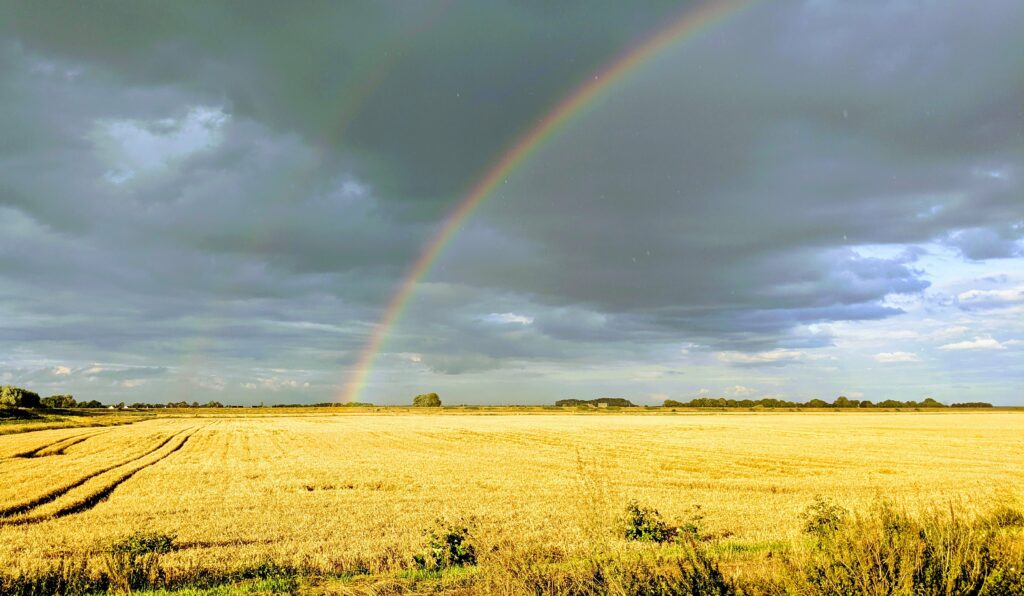
Forgive me for being blunt; the future of farming in this country won’t be secured by a new widget, genetic wizardry or planting with the phases of the moon. We need a way for farmers to capture more of the value they create. Without that, our food system has no future.
I asked attendees of this year’s Oxford Farming Conference a simple poll question: “Are UK farmers in competition with each other?” – 75% of respondents said “Yes”. Well, if we are, we shouldn’t be.
Anyone reading this smugly thinking that their regen system, profitable diversifications, or multi-thousand hectare scale will see them through are still operating in a false comfort zone. Anything you can do on your own farm won’t be enough. The farm gate is no drawbridge. To influence the world beyond – where the return we make is really set – we need to change our mindsets, leave our farms and team up. We will need to create new organisations and business models that bring farmers together and pool our resources. It’s the only way we can exert any economic power. It’s also tried and tested.
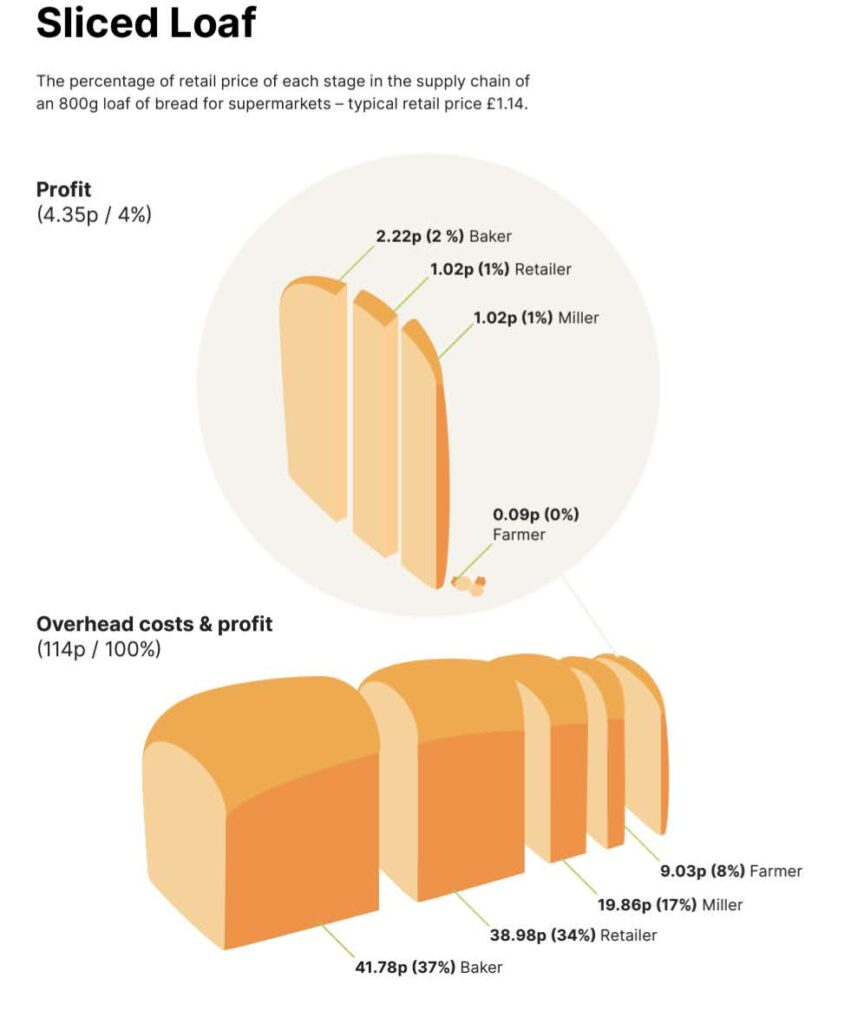
Who are you paying when you buy a Limagrain seed variety? French farmers.
Any idea who owns the largest milk companies in the world? Dairy Farmers. To be precise: Kiwi, Danish, US, Dutch and Indian dairy farmers.
Do you know the name of the EU’s biggest retail bank? Credit Agricole – a French farmers’ bank. In the Netherlands too, the mighty Rabobank was started by farmers, for farmers.
In hundreds of examples from Japan to India, Brazil to Germany; when farmers collaborate they create value, and are able to capture it too. Why not here?
Already farm clusters are quietly assembling across the country; farmers who are beginning to see collaboration as the best way to access the new environmental payments.
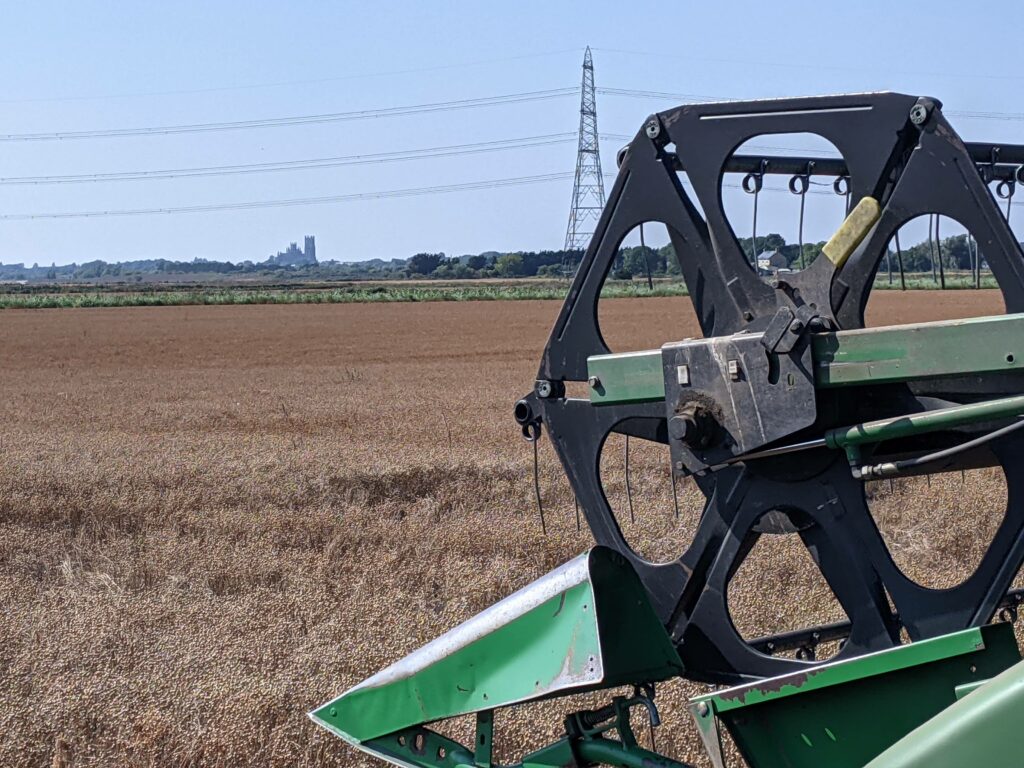
A bigger and better beacon is the NFU Sugar Board (of which I’m an elected member). It has special legal status to negotiate the annual sugar contract on behalf of all growers. This year, we really flexed those collective muscles and, because of grower unity amid a mighty stand-off with a multinational megacorporation, were able to capture more than 25% more value from rising world markets for every sugar beet grower.
We need more collective producer organisations, ready to capture value and even take ownership of the supply chain. NFU Sugar is a one-off. Its unique position will be hard to replicate: but farmers do hard things every day.
Be in no doubt, the big fish won’t hand over value easily. The recent bust up over the Greener Farms Commitment shows the widely-held expectation that farmers are supposed to just hand it all over, and be grateful for the business.
What supply chains really need now is our data; information only we can provide about our environmental footprints. We have become so used to passing up the value of our produce, I fear too many of us think we have to hand over this new value from our data too. But this is an opportunity to draw a line in the soil. Data is a lot easier to pool than wheat, cattle, or even sugar contracts, and collectively we have a monopoly on it. Can the worm turn?
With political, market and climate instability rising around the world, farmers everywhere are protesting. Most of these demos are asking for more from governments. A few are forming political parties, perhaps to become part of governments, or to wreck them. I say, the solution to economic problems is economic action.


-
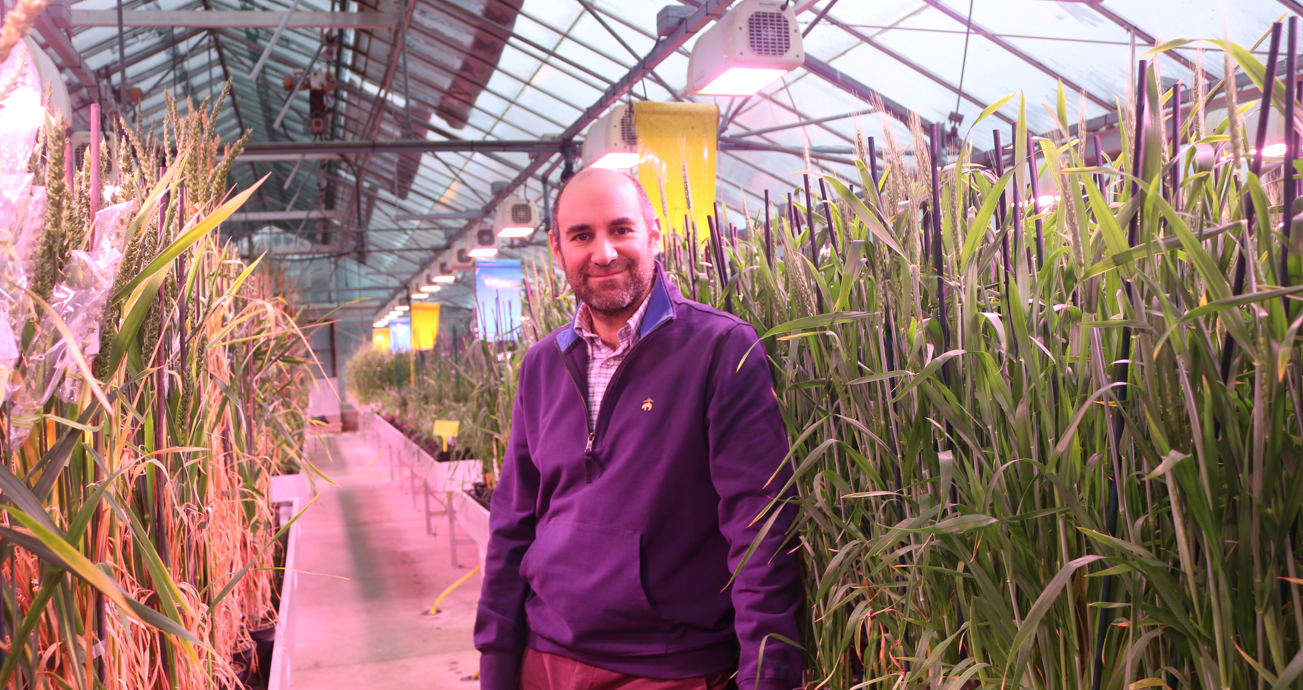
The power of diversity
A change in English law now allows certain gene-edited crops to be grown on commercial farms. Tech Farmer visits the scientists working with a new farmer-led platform that will make the first three introductions.
Rarely would you find so many misfits in the same place. Looking closely you can see spikelets within a wheat ear that seem to have spawned sub-spikelets. Misshapen ears. Short and stubby. Long ears with seemingly impossibly lengthy grains.
They seem unnatural, but they’re not, explains Professor Cristobal Uauy, group leader in wheat research at the John Innes Centre, Norwich. “This is natural variation that’s already out there in the fields. What we’re doing is trying to combine genetics and genomics with the biology of the plant – understand the genes that govern yield.”
That’s why the weird wheats are intensively wonderful to Cristobal and his team. They’re a route to understanding the genes and promoters of the MADS-box transcription factors they’re studying. These are associated with genes that govern diverse developmental processes, such as meristem specification, flowering transition, seed, root and flower development, and grain ripening.
“Yield is very complicated, just like intelligence in humans – many genes affect it,” explains Cristobal. “So we’re trying to break it down into these smaller components – what makes the grain heavier or longer or wider.”
There’s one wheat in particular we’ve come to see, and Cristobal alights on a collection of potted plants, puts one on the floor and bends its ear so that the glumes separate in an arch. You’re struck by the size of the florets. “This is Fielder, a spring wheat that scientists study a lot, so we know its genome. We’ve edited this at a very precise point so it produces these larger grains.”
The grains are in fact around 5% bigger than the unedited original, they have a higher thousand grain weight (TGW) and specific weight. So does that translate into a higher yield? “There’s a consistently higher specific weight, which is exciting for millers, but so far we haven’t seen a major yield effect,” notes Cristobal.
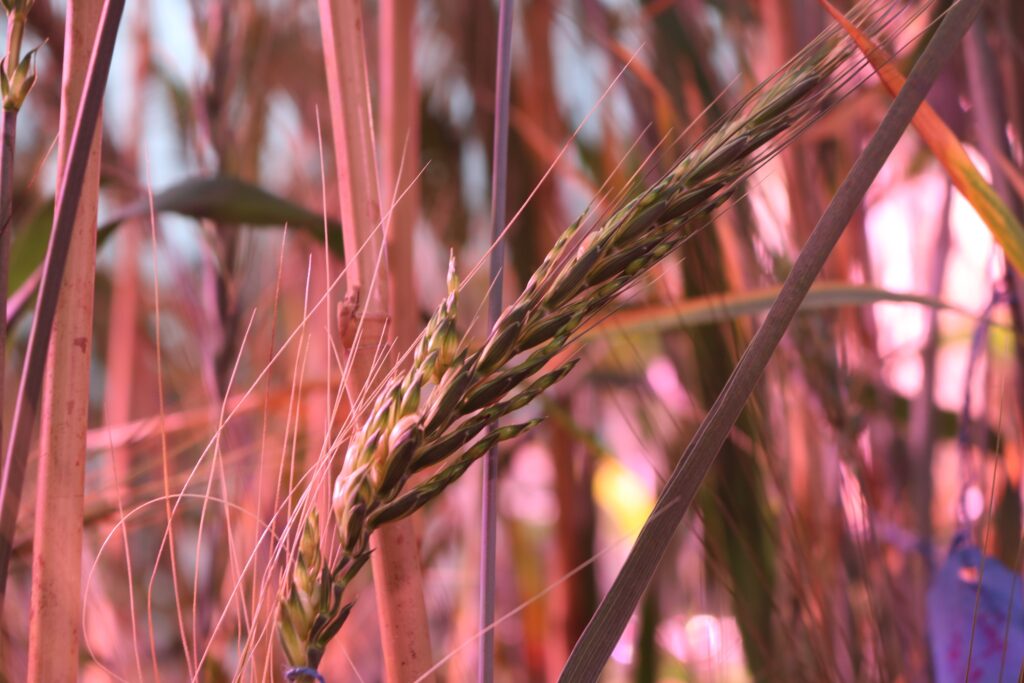
Wheats with unusual characteristics suggest they are a source of genetic diversity, so are closely studied. “The next step is to see how it works in the field. And that’s a critical step, because a plant can perform one way in a pot, but very differently in a farmer’s field. We need to know how these novel crops will behave under a commercial cropping regime, and whether its unique aspects can be enhanced through agronomy.”
This work is now set to get underway, thanks to a new farmer-led platform set up by the British On-Farm Innovation Network (BOFIN), working with industry partners (see panel on pxx). The plan is that this Fielder wheat will be one of the first three gene-edited cereals to be grown in commercial fields by farmers. “We have less than 1kg of seed at the moment, but we will multiply up enough for agronomic field trials and then for commercial crops, planned to go in the ground in spring 2026.”
Bigger, bolder grain
The discovery of this bigger, bolder grain happened over 250 years ago. “It was originally characterised in 1762 by botanist Carl Linnaeus, who documented the long grains, glumes and lemmas of a Polish wheat, Triticum polonicum. But exactly what gene controlled this has remained a mystery,” notes Cristobal.
Pivotal work was carried out by James Simmonds at John Innes Centre, who managed to create a stable cross of the wheat with Paragon. “We thought we had a pretty good idea of the gene responsible, but it wasn’t until the wheat genome was published in 2018 that we knew for sure.”
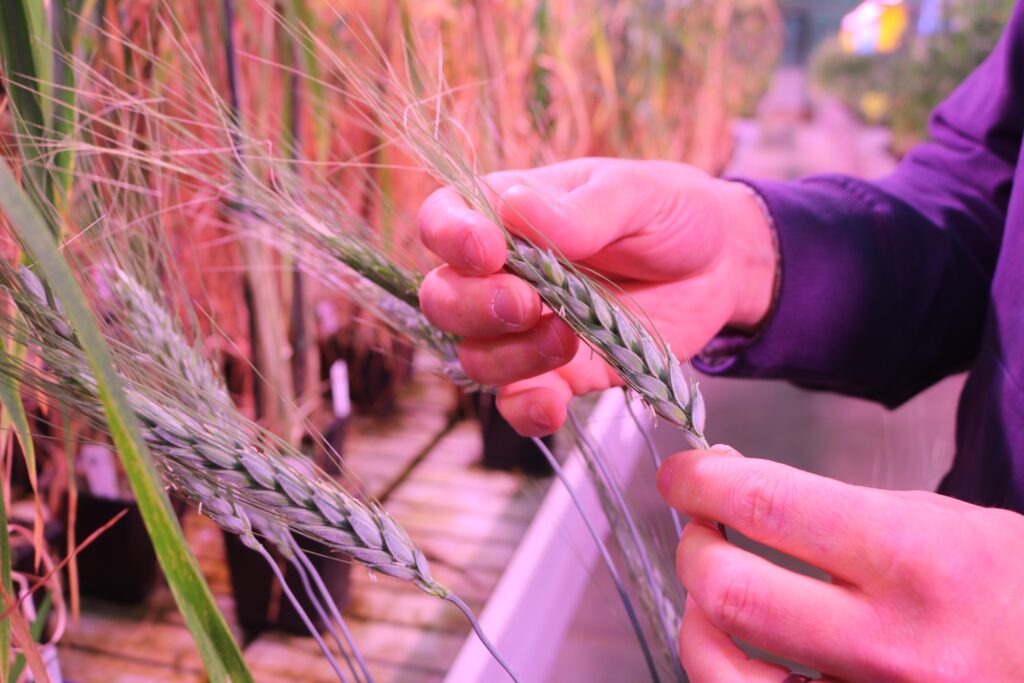
The edited Fielder wheat has notably larger glumes. Cristobal explains that wheat, a hexaploid, has three copies of its genome, making it one of the most complex of all organisms with around 16 billion letters. An international collaboration resulted in a map of the wheat genome and has accelerated understanding and the roles of specific genes.
“We’ve identified the gene responsible as VRT-A2 (Vegetative to Reproductive Transition). The genes that govern glume development are the same in all wheats, but the sequence that regulates it are different.”
What the team discovered was that VRT-A2 has the effect of “putting the brake” on glume development at a particular point in the plant’s growth. There’s a misexpression of this gene in the Polish wheat so that glume development continues unabated. Using CRISPR, the team has now replicated this effect with a sequence rearrangement in the DNA of VRT-2A, bringing the bigger, bolder grains to Fielder.
“What we want to understand now is how this VRT-A2 expression is controlled by the edit we’ve made. There are downstream genes that will be affected and we want to identify these and look to see how agronomy can influence the resulting traits.”
Nor is VRT-A2 the only gene in the MADS-box the team is studying. An international collaboration including JIC has identified SVP-A1 (Short Vegetative Phase) that has a similar effect. “The gene also appears to have an influence on glume length, so again it’s not until we bring this out into the field that we can look at how to manipulate it.”
Another promising route is GW2, a gene that regulates grain width. The team generated mutant wheat lines where the effect had been knocked out of autumn-sown variety Cadenza through TILLING (see panel later on).
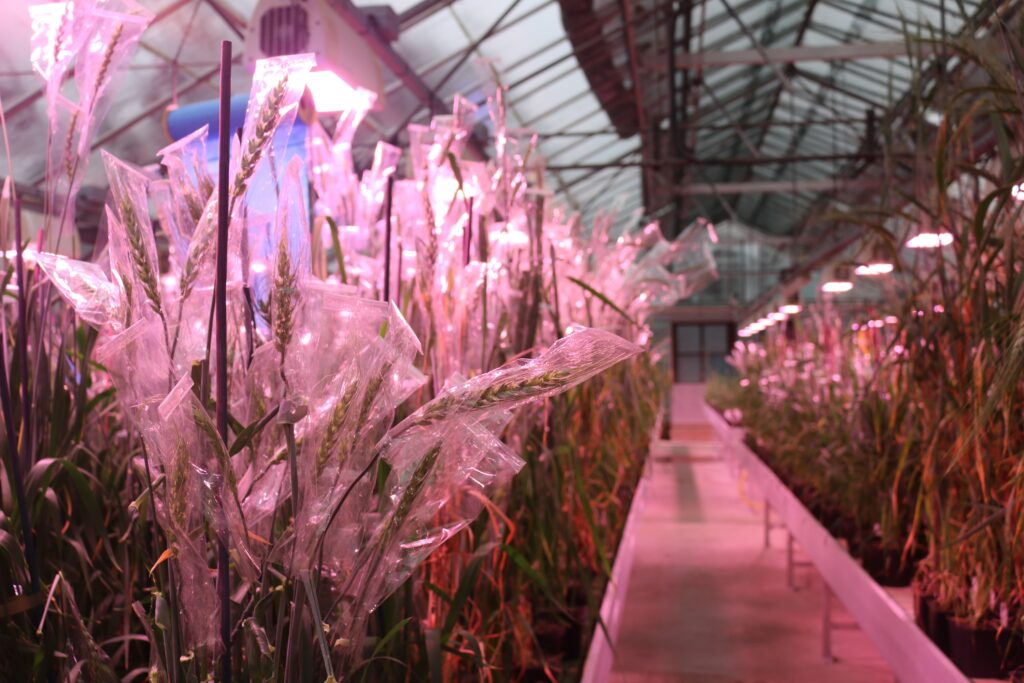
The next step is to see how the wheat works in the field – critical, because a plant can perform very differently to how it does in the lab. “We generated mutants that had the change on just one of the wheat’s three genomes, on two and also on all three. Here we achieved an increase in TGW of 6%, 12% and 21% respectively. However, again we have seen no increase in yield, and what’s more, it resulted in lower tiller numbers. But an interesting aspect is that protein content was higher – you’d expect a dilution effect, but this didn’t occur.”
Work is now underway to edit the GW2 gene in Skyfall, with a true PBO expected in about 18 months. “We have colleagues at JIC who are developing other wheat PBOs, for example with high iron or zinc content in the grain. There is also robust yellow rust resistance coming through,” notes Cristobal.
The plan is to put all of these traits through the farmer-led platform as enough PBO material comes available. “It’s fascinating for us as scientists realising what can be achieved with new genomic technologies. We want farmers to see this for themselves in their own fields and bring about a revolution in how we grow wheat. We think the improvements we can now bring forward in plants will not just help the environment, but bring greater food security for all people around the world.”
Applying PROBITY to new genomic techniques
A Platform to Rate Organisms Bred for Improved Traits and Yield (PROBITY) is a new industry-wide initiative led by BOFIN. It brings scientists, plant breeders and food processors together with farmers and agronomy research specialists to explore gene-edited crops.
The platform has been made possible by new legislation that allows precision-bred organisms (PBOs) to be grown on commercial farms in England (see panel on pxx). PROBITY aims to explore the attributes of novel crops in a transparent and open forum. Up to 25 English farmers will carry out on-farm trials and produce enough material for batch-processing or feeding trials of the first three PBOs, which are already in multiplication plots at UK research institutes.
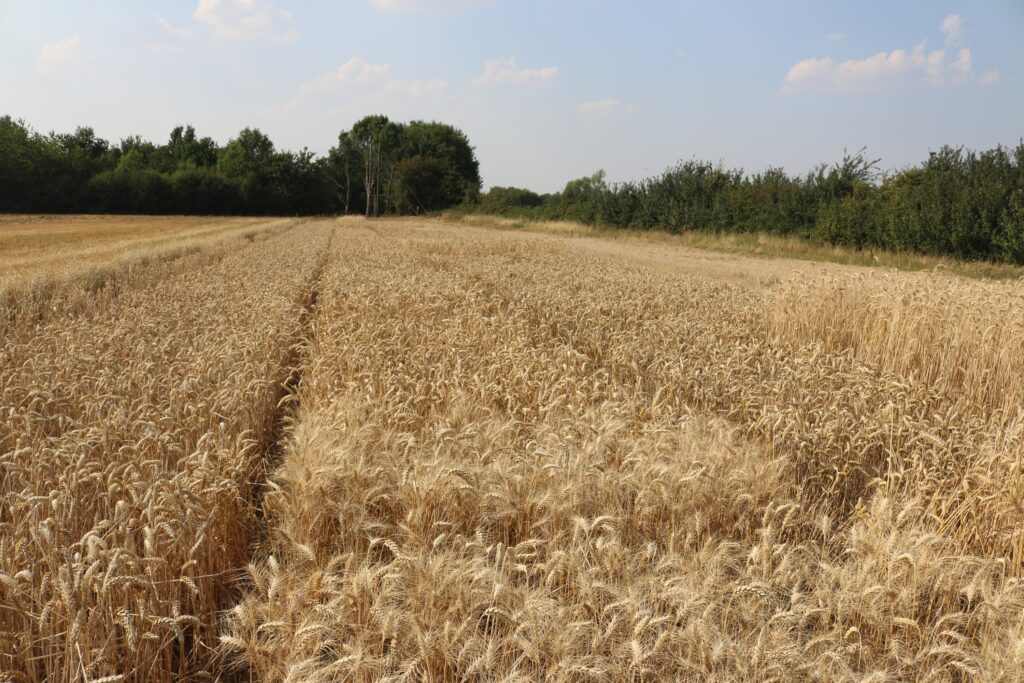
English farmers will carry out on-farm trials and produce enough material for batch-processing or feeding trials of the first three PBOs. These will feed through into agronomy trials and breeder plots in the 2024/25 cropping year, with the first crops grown on commercial farms the year after. Around 12 novel traits have already been identified and are expected to follow into the platform, creating a pipeline of new breeding technology.
The platform is designed to complement the existing route to market for conventionally bred crops, says BOFIN. PROBITY specifically aims to address traits where the value and market attraction may currently be unclear, as well as a testbed to import or export novel traits.
Importantly, BOFIN says the varieties multiplied up will be non-commercial, with the emphasis being to test a novel trait and give breeders the confidence to bring these into the latest varieties. For more information, email info@bofin.org.uk.
Jargon-buster: what does it all mean?
Mutagenesis is a change or edit in the plant genome that confers a new trait. Such mutations occur naturally every day, when a plant comes under stress, for example, or it can be induced through human intervention. A small change in the genome may switch off the activity of a particular gene which allows or inhibits a property, and it’s these phenotypical changes breeders have sought out for generations to progress their lines.
Mutagenesis differs from Transgenesis, where DNA from another species has successfully been combined into the genome of the host plant. These are universally classified as Genetically Modified Organisms (GMOs). In the UK and across the EU, the release and cultivation of GMOs is highly restricted, although they are allowed in imported food and feed for livestock from parts of the world, such as the Americas, where they are widely grown.
Cisgenesis is where DNA is artificially transferred between organisms of the same species, such as from a wild relative to an elite potato variety to confer blight resistance. In Europe at least this is still classified as GM as nucleic acid sequences must be isolated and introduced using the same technologies that are used to produce transgenic organisms.
For decades, scientists have induced mutagenesis to bring about new traits, or phenotypical variations, using chemicals or radiation. TILLING (Targeting Induced Local Lesions in Genomes) is a powerful reverse genetics method used in plant sciences which allows the identification of point mutations, introduced randomly throughout the whole genome by chemical mutagenesis.
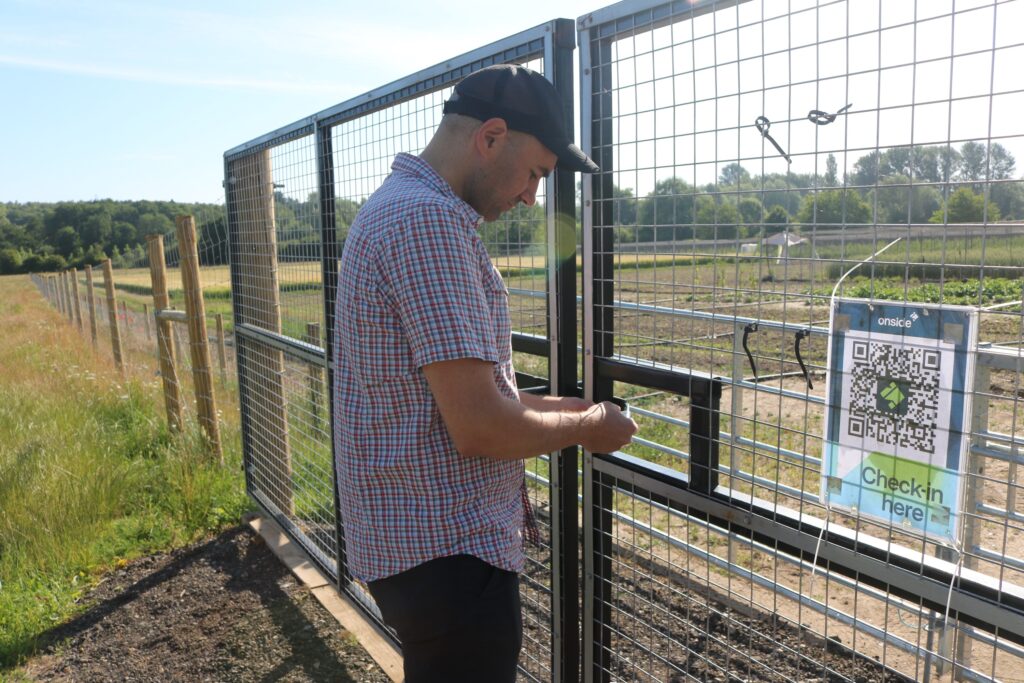
In the UK and across the EU, the release and cultivation of GMOs is highly restricted. More recently, more precise gene-editing techniques such as CRISPR-Cas9 have been introduced. CRISPRs are short RNA sequences introduced into the host plant that recognise a specific stretch of genetic code. Cas9 enzymes partner these sequences and cut the host DNA at specific locations.
The cell tries to repair the damage, and that’s when the mutation occurs. By using different enzymes and techniques, researchers can deactivate or alter – edit – specific parts of the genome, thereby conferring traits.
Legislation around New Genomic Techniques (NGTs), such as CRISPR, is changing. In England, the Genetic Technology (Precision Breeding) Bill was enacted in 2023. This allows the release and marketing of precision-bred plants, which had previously been restricted by European legislation governing GMOs.
It affects cases where NGTs have been used to edit a plant genome to bring about traits that, according to scientists, could have happened naturally. Where this is the case, these plants are now treated as Precision-Bred Organisms (PBOs) – effectively the same as conventionally bred.
The legal change applies in England only – devolved governments have yet to follow suit – and while similar legislation on NGTs has recently passed through the European Parliament, it’s yet to be adopted in EU member states.
Supply chain benefits from novel crops
Biscuits and breakfast cereals from the first gene-edited wheats grown on commercial farms in England are the plan as part of the new BOFIN farmer-led platform set to put the novel genetic technology to the test.
The wheat is the first of its type to have been put through field trials in Europe. It has a novel trait that naturally improves its performance when its products are toasted or baked, according to Professor Nigel Halford who has led the work at Rothamsted Research.
“We have edited lines of the variety Cadenza using CRISPR-Cas9 so they have less than 10% of the levels of asparagine found in commercial wheat. This is an amino acid that occurs naturally in cereals, but during cooking at high temperature, such as baking or toasting, asparagine is converted to acrylamide,” he explains.
Previous research has shown this carcinogen exceeds current Benchmark Levels in 23% of biscuits and as much as 33% of breakfast cereals. These Benchmark Levels are expected to be reduced in the EU later this year, along with the setting of maximum legal limits. “Food manufacturers currently use processing techniques and additives to bring acrylamide levels down below Benchmark Levels. They have indicated there will be high demand for a wheat that achieves this naturally.”

The edited lines of Cadenza have less than 10% of the levels of asparagine found in commercial wheat. Work at Rothamsted has focused on asparagine synthetase (ASN) genes responsible for most of the production of asparagine in the grain. “ASN2 is by far the most active, and Claire is a variety that has a natural mutation such that it lacks an ASN2 gene on one of its three genomes,” explains Nigel.
Using TILLING (see panel on pxx), the team managed to ‘knock out’ (or silence) the ASN2 genes on the other two genomes. But this older form of mutagenesis has been found in field trials to result in a yield penalty. CRISPR is a more precise technique, and the team now has lines of Cadenza with a triple knock-out of ASN2, along with some with a second gene, ASN1, similarly silenced. Initial tests have shown some of the novel lines produce undetectable levels of acrylamide when baked into bread.
It’s one of these, line 59, that will be put through the farmer testing platform, led by BOFIN. This will be grown in farmers’ fields alongside the TILLING Claire and unedited originals to confirm the attributes already demonstrated in Rothamsted field trials.
“Line 59 has less than 10% asparagine compared with unedited Cadenza, with no yield penalty. The plan is to produce as much as 100t by harvest 2026, which will be processed into biscuits and breakfast cereal from well-known brands,” notes Nigel.
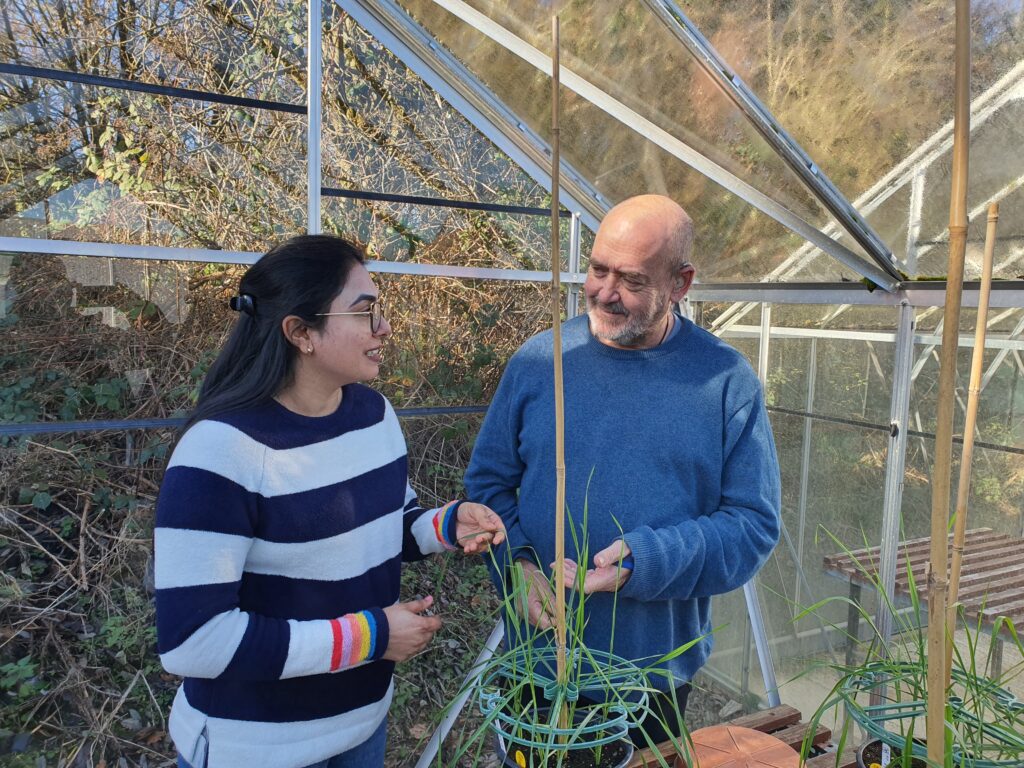
Working with farmers, Navneet Kaur and Nigel Halford plan to multiply up enough of the edited Cadenza to process into biscuits and breakfast cereals. “Once the farmers have grown this wheat in their fields, food manufacturers have seen how it performs, and consumers have actually held the product in their hands, we believe that will address any reservations there may be over the value of this advance in plant-breeding technology.”
For Nigel’s colleague, Dr Navneet Kaur, the move into commercial fields is a natural progression of the science the team has applied in the lab. “Along with work to apply edits that reduce asparagine, we’re also testing all the material to ensure there are no undesirable effects on milling quality – we’ve found none in the CRISPR-edited lines so far. We’ve also been looking at agronomic factors that affect acrylamide – sulphur is a key nutrient and a deficiency gives rise to higher asparagine levels.”
The potential for targeting other natural amino acids is also being explored. “We have some promising lines of wheat with high lysine content. As a home-grown feed wheat they have the potential to displace imported soya in livestock rations. The PROBITY platform will be ideal to test the value of this trait once we have generated true PBOs,” she notes.
Promise brings prospect of high-lipid forage
It’s long been the Holy Grail for livestock nutritionists: studies suggest higher dietary lipid concentrations in cattle fodder can improve productivity and reduce methane emissions by up to 5% for each 1% increase in lipid content.
Now there’s a new gene-edited crop with a marked increase in the lipid content of its leaves and stem. This will be grown on commercial farms in England as part of the new BOFIN farmer-led platform. The fodder will be fed to dairy cows with output and productivity closely monitored to see if expected increases in energy values of more than 0.5MJ/kg of dry matter (DM) are achieved.
The edit has been made in Golden Promise barley by Professor Peter Eastmond of Rothamsted Research. He accepts that barley is not traditionally chosen as a forage crop, but is confident the transformation can be made in ryegrass. “We chose Golden Promise because it’s easy to transform. Ryegrass is harder and does not self-pollinate, which makes things more complicated. But previously it was thought you couldn’t edit this change into a grass crop – we’ve shown that you can.”
Peter’s work started in bioenergy crops, the goal being to store more lipids in leaves to boost the energy value of the resulting biomass. “Plants can store oil in seeds, but in leaves there’s limited capacity, partly because they break down the oils,” he explains.
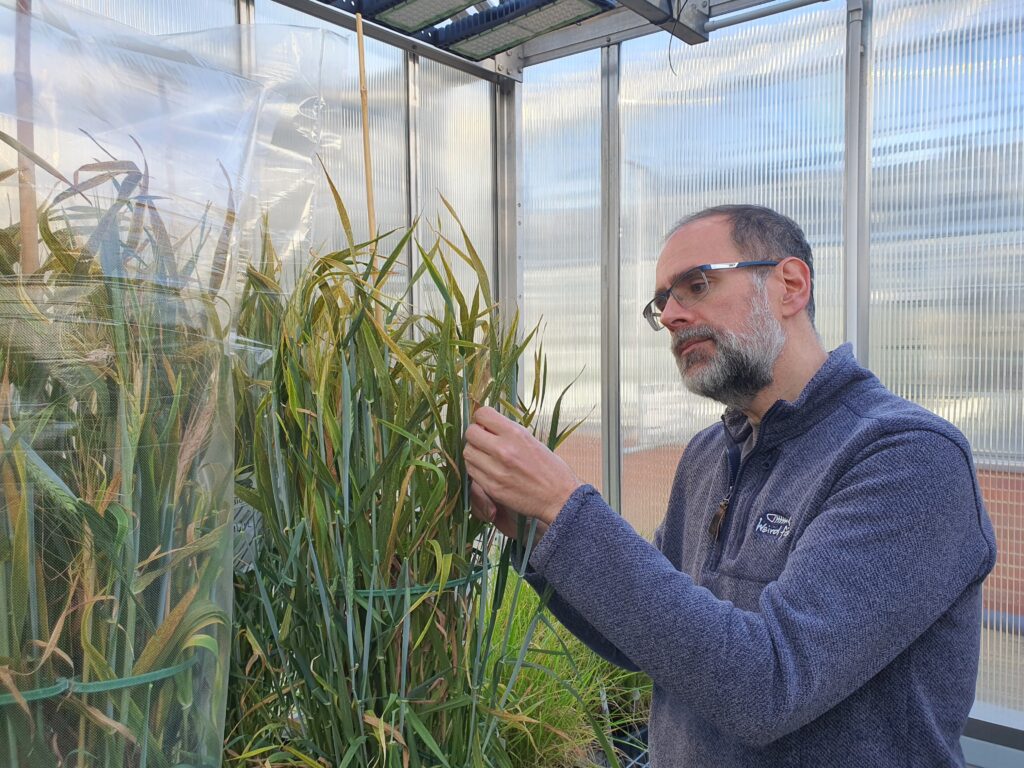
Peter Eastmond has developed a gene-edited barley with a marked increase in the lipid content of its leaves and stem. In 2006, Peter discovered and characterised a plant gene called Sugar-Dependent1 (SDP1). He found it was largely responsible for the breakdown of the storage oil triacylglycerol and that disrupting this gene leads to accumulation in leaves. A further breakthrough came when his team discovered a way to switch on a dormant gene without inserting foreign DNA and creating a GMO.
“Grasses with a lipid content of 8% of dry matter – more than three times their natural content – have been achieved, but only through inserting foreign DNA, making them GM. A gain-of-function is not something you can usually achieve with CRISPR, which is associated with turning genes off,” explains Peter.
The Rothamsted team showed that a gene can be brought under the control of a promoter from an upstream gene by using CRISPR to delete the intervening genomic sequence. They fused the promoter of a non-essential photosynthesis-related gene that’s switched on in leaves, to the Diacylglycerol Acyltransferase2 (DGAT2) gene that’s normally switched off.
“DGAT2 makes an enzyme that’s known to synthesise triacylglycerol and its overexpression can drive increased oil production.” The work, in the model plant species Arabidopsis, resulted in the oil content in the leaves increasing by around thirty-fold, when SDP1 was also disrupted – the combination of the two processes is thought to be key.
But could the same transformation be made to grass species? “It was touch-and-go because, although Golden Promise is easy to transform, grasses are very different to Arabidopsis. We made the edits during COVID, just before lockdown, which meant we couldn’t get to the lab to analyse the results,” recalls Peter.
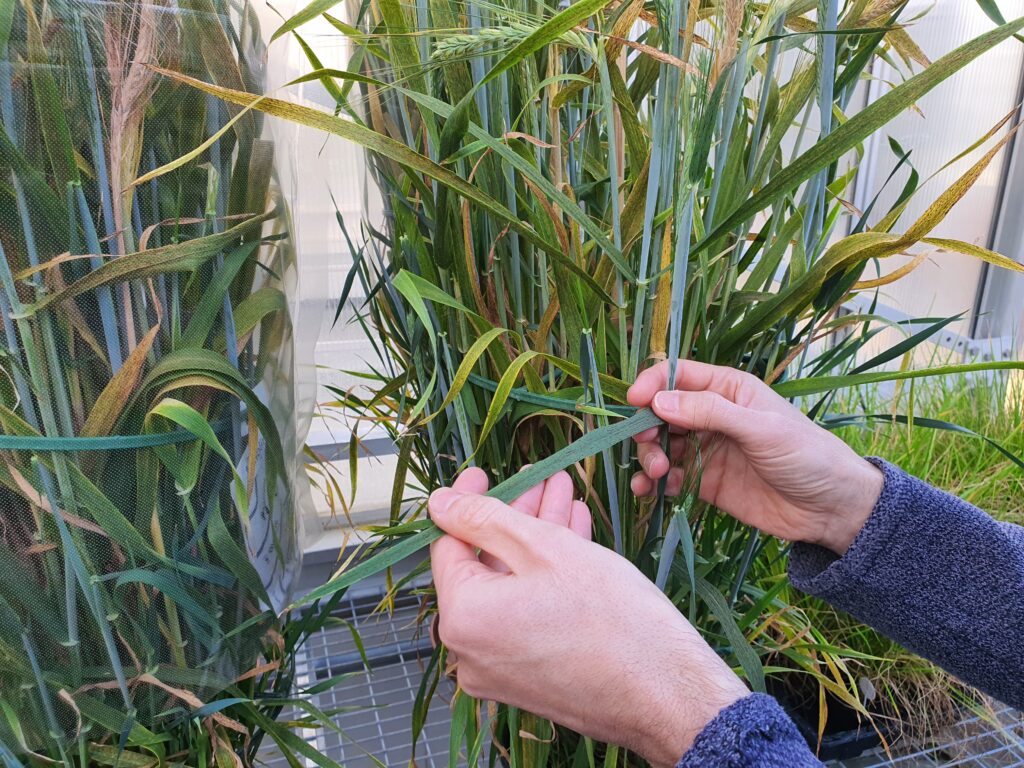
The plan is to work with specialists at Aberystwyth University to bring the same genetic breakthroughs into ryegrass. But when they returned it was good news. Barley has two copies of SDP1, and out of 160 lines they found just one with a rare, and very much prized, double knock-out. “We found this resulted in a 1% increase in lipid from 2.5% DM to 3.5%. The increase is substantial and the trait is heritable, which is a big relief. What’s more it’s a true PBO.”
The barley went through field trials in 2023 and is now being multiplied up for the PROBITY platform. The aim is to produce enough in harvest 2025 for bench testing of the fodder with full feeding trials conducted by a major dairy co-op on farms in 2026. The fodder will be harvested before the ear has set from 1ha strips grown next to unedited Golden Promise to compare its performance in the field.
Peter accepts it’s not the finished product. “Really, we need at least a 3% increase – up to 7-8% of DM would be optimal. But we know this can be achieved, because it’s been done through transgenesis. What’s more we’ve been working in this area for more than 20 years and have achieved successes that had been thought were not possible previously.”
His team will be working with specialists at Aberystwyth University to bring the trait into ryegrass. Scientists at IBERS are world-renowned for their work in developing high-output grasses. “It’ll be tough, because transformation efficiency in ryegrass is low,” notes Peter.
“But that’s why it’s so important we prove the outcome through the PROBITY platform – these sorts of advances in ryegrass breeding simply won’t happen unless breeders have the confidence it’ll be worth the effort. With the on-farm work, we take the trait through those steps and remove the barriers.”

-
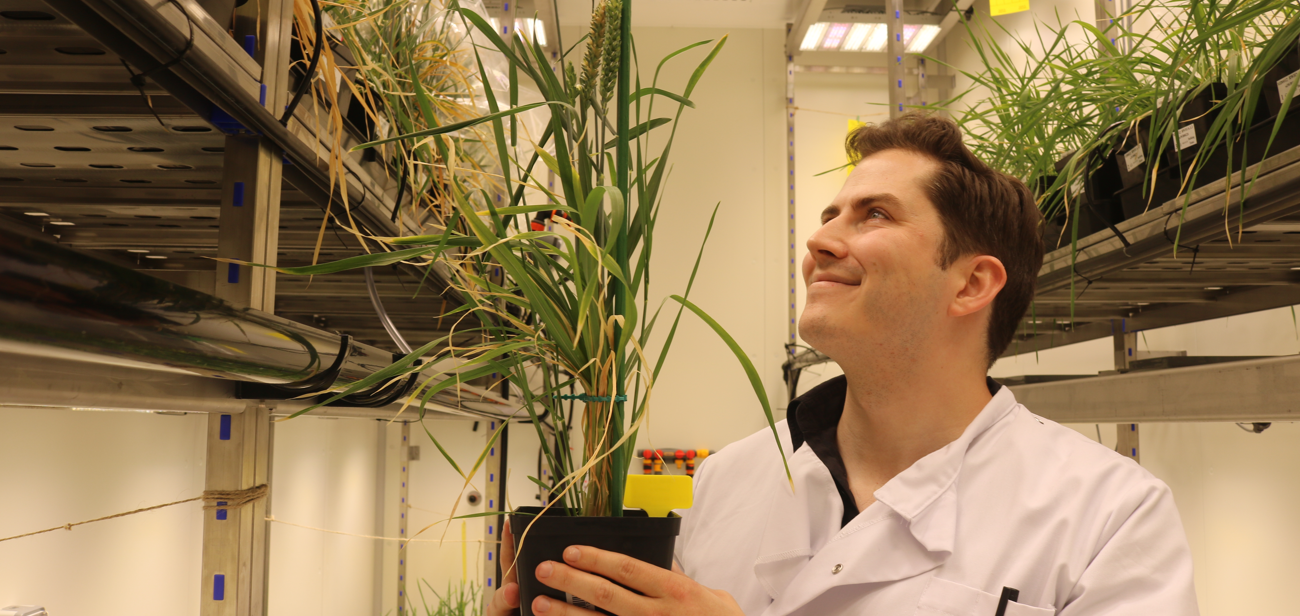
Seeds of a wild idea
Wild plants could hold the genetic key to a step change in productivity across major agricultural crops. Tech Farmer visits the labs of a new start-up that’s sifting through the genomes.
Ross Hendron looks up at the ear of the wheat plant he has just pulled down off the shelf of the growth room.
“At the moment it’s just one plant,” he says, and turns his gaze to the dozens of companion plants sitting on the shelf under the bright LEDs. “We have to pick which of these will work best, and we won’t know for sure until we have enough seed to test them in the field. But the lab tests have proved promising.”
What Ross holds in his hand could represent a step change in yield that is beyond the capability of any wheat currently under cultivation anywhere in the world. The variety is Cadenza that has been edited at precise points in its genome to improve its photosynthetic ability.
A subtle tweak can make a step change to how efficiently a plant behaves.
But just because current wheats don’t have the ability to do this themselves, that doesn’t mean it’s not in their nature. According to Ross and his team at Wild Bioscience, a spin-out biotech firm from Oxford University, it may be a case of waking up a gene already present in the wheat genome.
“Wheat’s been cultivated as a crop for about 10,000 years, but in evolutionary terms, that’s nothing,” he says. “There are many wild plants that have dealt with climate shocks that cultivated plants have never even experienced on a farm. But if you look closely at the genome, they all share a similar genetic hardware.”
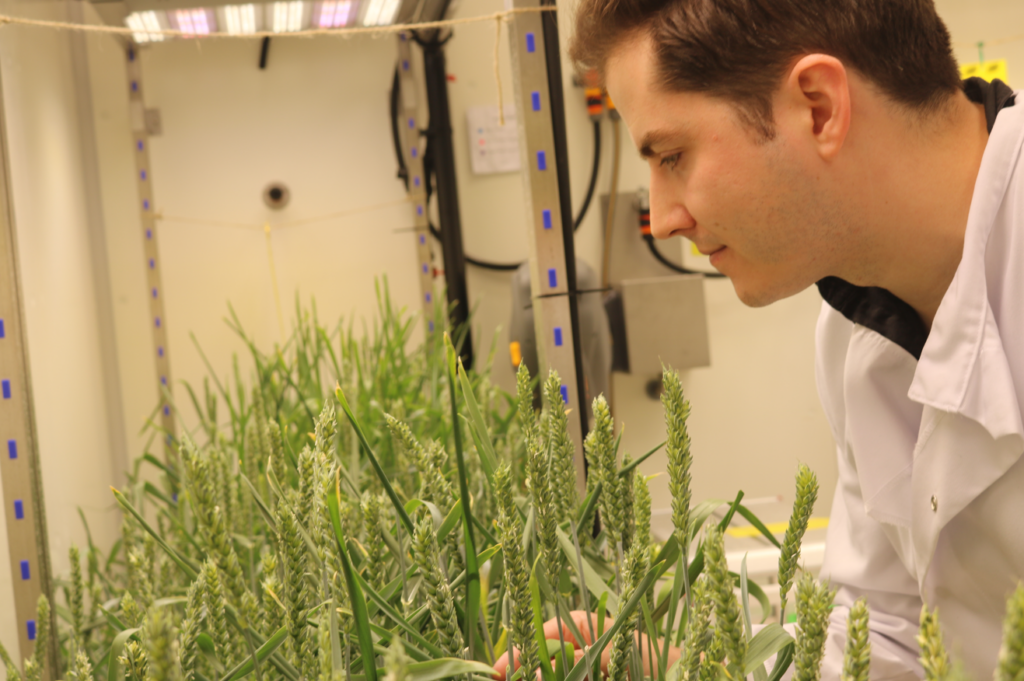
This Cadenza wheat has been edited at precise points in its genome to influence signalling molecules used to tell a cell to develop chloroplasts. This insight originated in the lab of Professor Steve Kelly, where Ross joined as a PhD student in 2016. Steve’s lab develops and uses computational approaches to understand the genetic basis for how plants work. His group uses these insights to investigate fundamental questions in the evolution of plants, such as how photosynthetic pathways have evolved, and why some plants grow faster than others.
It’s this approach that the team at Wild Bioscience have been exploring since Ross and Steve founded the business less than three years ago. £12 million of venture capital has sped it on its way, and now there are offices, growth rooms, labs and a team of 20 staff in Milton Park, just a few miles from Oxford, where the vision began.
“But it’s a challenge – the genomes of wild plants generally haven’t been mapped,” notes Ross. “Wheat has, but it’s a complex genome of 17 billion letters. However, if you look closely, there are some plants that have evolved the ability to turn on certain characteristics. Crop plants have much of the same genomic architecture, but haven’t inherited these characteristics.”
It’s these that give a cactus its ability to survive in desert conditions, for example. Find the genetic secrets to survival in these harsh environments and you have the potential to bring about a transformation, he points out. “A subtle tweak can make a step change to how efficiently a plant behaves. You then use machine learning to target that.”

Improving a crop plant’s photosynthetic ability is just one of the changes Ross Hendron and his team are developing with the material in the growth rooms of Wild Bioscience’s new facility near Oxford. Ross and Steve had been looking closely at the signalling molecules that are used to tell a cell to develop chloroplasts. While all plants use these to drive photosynthesis in certain cells, such as in the leaf and stem, many different wild plant species have evolved the ability to turn these on in specific cells – an ability wheat currently doesn’t share. “But the tweak has to be precise – get it wrong and you get chloroplasts in roots and flowers,” notes Ross.
It was during Ross’ PhD research that he and Steve first managed to put this theory into practice. “The first plant I transformed was Arabidopsis – a type of plant scientists often use because we know so much about the genome. I made many different transformations, and I guess the seminal moment for both of us was seeing them develop – there were some that just stood out in the greenhouse as significantly ahead of the rest in terms of their growth.”
Since then, the work of Wild Bioscience has focused on developing interesting genes and characteristics in widely grown broad-acre crops, chiefly soya, maize and wheat. Most of the novel prototype plants are GMOs, genetically modified with a piece of plant DNA. This has proven the technology, and there are one or two crops, notably soya, that have now progressed as far as field trials grown in South America. Tight regulations for growing GMOs in the UK and EU severely restrict putting the crops in the field here, and they would be unlikely to be commercially grown.

A window on Wild Carbon – soya plants that have been altered to sequester and store significant quantities of carbon long term, without a drop in yield performance. But the team is now working on editing the genome of farmed crops to achieve the same transformative leap, using new genomic techniques (NGT). Also called precision-bred organisms (PBO), these are plants where scientists have made a small and precise edit to its DNA that could have happened naturally. Legislation passed in 2023 has now allowed these crops to be grown in the field in England without the restrictive GMO regulations, with similar laws currently passing through the European Parliament.
That means progeny of the wheat plant that Ross carefully places back on the shelf can come into English farmers’ fields without restrictions. “It’s part of a programme we’ve branded Wild Solar, which encompasses the changes in photosynthetic efficiency,” explains Ross as he shuts the door of the growth room, leads the way to another door and opens its hatch. Peering through the glass reveals more brightly lit plants, this time soya.
Alongside Wild Solar, the company has recently introduced Wild Carbon, which uses the roots of crop plants to create what Ross describes as a “revolution” in long-term carbon sequestration. “Plants are masters of moving CO₂ around,” he enthuses, his face lit up as he looks on his soya plants through the window.
“This is mostly to do with producing sugars, and you don’t want to mess with that process as it affects yield.”
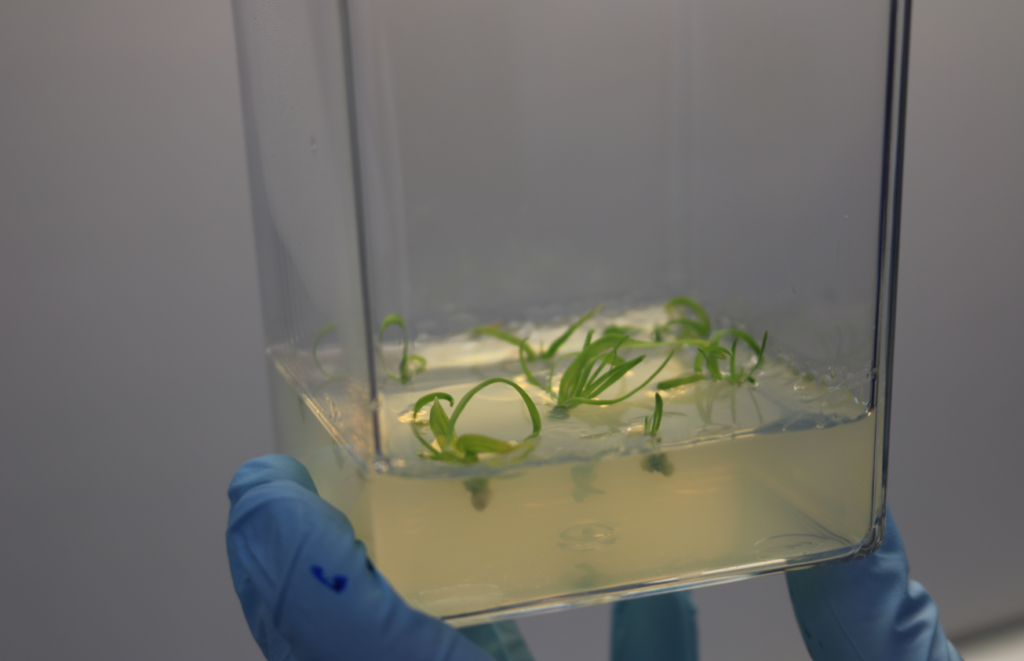
At the very start of their journey, first generation edited wheat plantlets are regenerating from embryos. Ross explains that most of the CO₂ taken up by plants is drawn into cells in the leaf and involved in photosynthesis. Wild Carbon is designed to bypass photosynthesis and store atmospheric CO₂ via the roots directly into the soil where it will stay locked up. “The potential of this technology is vast, as it could turn farmland into the world’s largest CO₂ storage facility without effecting crop yield or changing land use.”
The Wild Bioscience team believe they may have found the genes that enable this and sequences of DNA have now been transferred into some of the lines in this very room. “These GM soya plants look promising,” says Ross as he closes the hatch.
“But it doesn’t have to be GM. The gene we’ve brought in is controlled by a promoter sequence. We can edit the plant to turn on and off a different promoter sequence to act on the exact same gene that soya already has in its genome, and we believe that will have a similar effect.”
And it doesn’t have to be soya. In the early stages of exploring a genetic alteration, when trying to establish the phenotypical change that results, soya is actually harder than wheat to edit, he continues. But wheat is hexaploid, so there’s additional work needed to determine how the appropriate gene should be edited over the three copies of its genome.
“Here we’re looking at a gain-of-function, so we believe we only have to turn on one gene in one genome to get the gain. What’s exciting, though, is that this means there are many different ways we can explore how to combine the benefits of these approaches to boost both yield and carbon removal in the same plant.”
The Wild Carbon work is some way off application in the field, particularly for NGT lines. But Ross is confident the Wild Solar wheat is almost ready, and just needs to be multiplied up. “One of the big challenges we have as scientists is to replicate the same changes we see in the lab out in the field,” he notes.
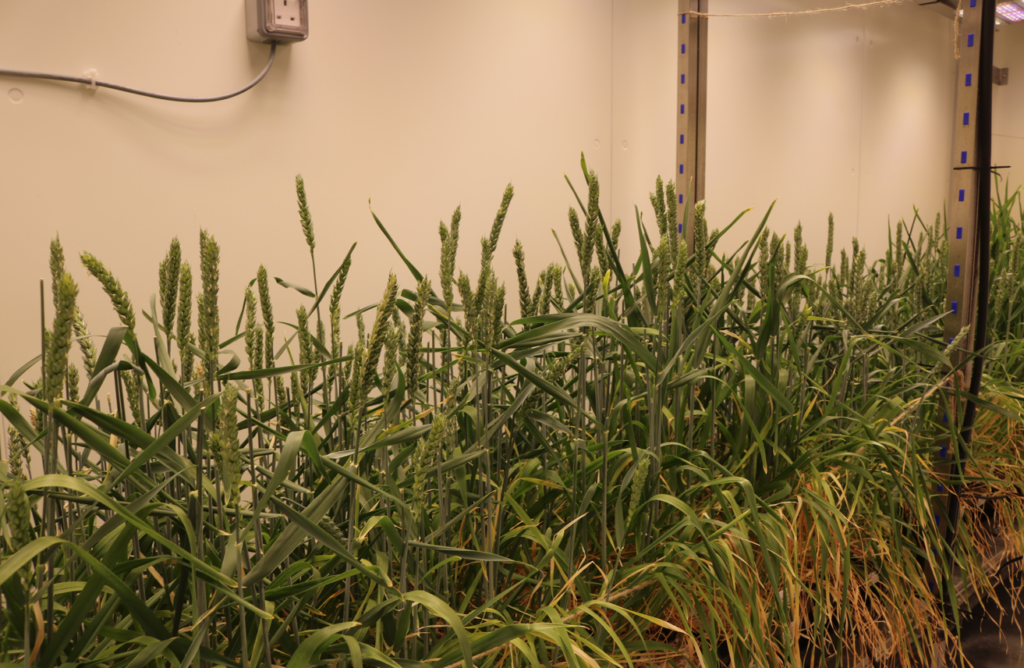
Almost ready for field trials, as soon as enough material is available, agronomy programmes will need to be shaped and soil and field conditions explored to get the best from the novel crops. “Field trials are a crucial step in seeing how these novel plants interact with the environment and the agronomy applied to them on commercial farms. We’re at the very beginning of our journey there.”
This is where farmers can help. As soon as enough material is available, agronomy programmes will need to be shaped and soil and field conditions explored to get the best from the novel crops.
Ross believes this will also address the reservation some people have for the technology. “Once these crops get out into the field and farmers can see the benefits, I hope it will demonstrate the impact precision breeding can have.
“There are many societal benefits we can deliver with these novel methods that simply cannot be achieved through traditional plant breeding. Once the products are available to farmers and consumers, I think the narrative will change and this will create more choice for farmers.”
As a scientist Ross is also keen to get feedback from farmers interested in growing NGTs. “I know there are many farmers who are excited about new technology, but what motivates those who are adept with a pipette may be different to what drives those who tend the land. I think there are passion points we share, and it’s these we can explore once these novel crops are in farmers’ fields and showing their worth,” he concludes.




-

Evolution becomes revolution with AI
Foundational artificial intelligence may still be in its infancy, but it’s already being used to help bring new varieties with better traits to farmers’ fields. Tech Farmer takes a look at some of the AI innovations that are set to speed up the breeding pipeline.
Imagine having a brain that never gets tired and retains every last piece of information it has ever learned. A brain that can see patterns in data and make complex calculations in millionths of a second.
These are just some of the capabilities artificial intelligence (AI) is already bringing to our everyday lives as groups of AI technologies form systems capable of performing tasks that traditionally have required human intelligence (known as foundational AI).
The computational power of artificial intelligence (AI) has a very natural fit with plant breeding as nature tends to follow mathematical rules. Gregor Mendel is regarded as the ‘father of genetics’ because he worked out so much about how traits are passed from one generation to the next using just maths.
From his experiments in peas, Mendel developed a mathematical formula that explained the frequency with which each trait appeared. He also observed dominant and recessive traits despite having no knowledge of DNA or genes.
Modern plant breeding still follows Mendelian processes, but the advent of molecular-based marker-assisted technologies to identify genes has sped up the process considerably compared with phenotypic screening alone. Now advances in technology, such as cloud computing and increased processing power, are moving speed breeding up another gear.
For Bayer, the journey began over a decade ago when the company began to integrate data science into its breeding programmes to help optimise the process.
“We started with a simple idea and that was to take ‘the breeder’s equation’ and work out how to apply machine learning to optimise every term in that equation”, explains Phani Chavali, who leads Bayer’s US data science team in plant breeding.
The breeder’s equation is used to predict breeding outcomes by indicating how strong the response to selection will be as a result of the additive genetic variance within a trait, and the selection applied to that variation. Phani explains that by using AI and machine learning models, Bayer has become better at predicting outcomes, essentially speeding up selection for genetic gain.
“We have developed genomic selection, which is a machine learning model that uses genotyping data to predict the performance of different genetic material. And using that information, we can advance varieties in the breeding pipeline without actually testing them in the field,” he explains.
“We also use machine learning to select new breeding crosses, and to advance the progeny from these new crosses into subsequent years.”
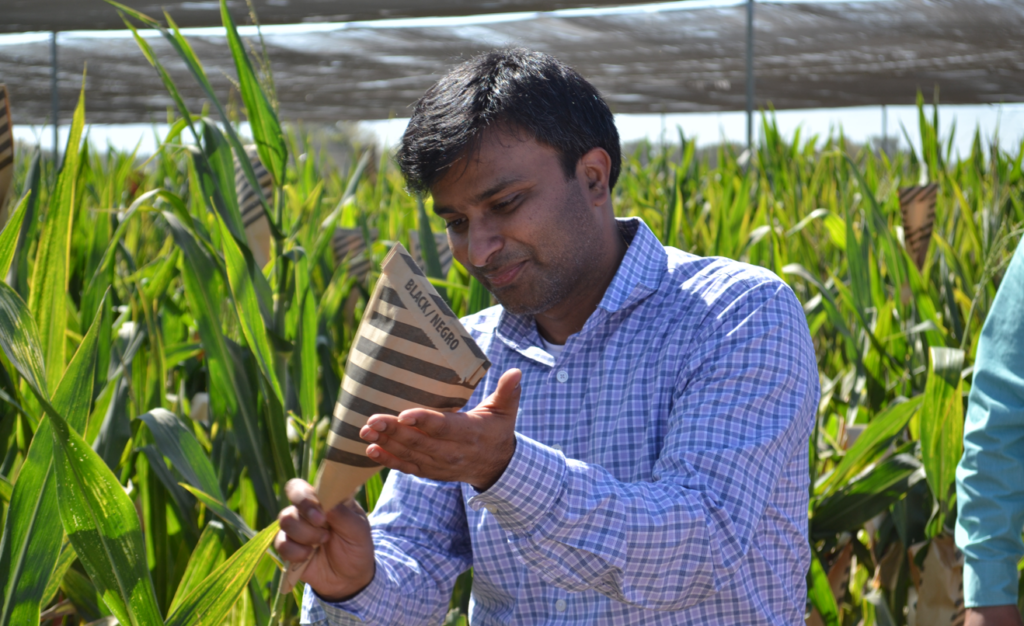
In the past few years, advances in AI capabilities have enabled Bayer to embark on a new phase in its plant breeding which aims to leave the Mendelian processes of probability behind, says Phani Chavali. This AI assistant is helping breeders select the most promising candidates and it relies on cloud-based algorithms built on a foundation of roughly 1.7 trillion calculations. These models have enabled a dramatic shift in the scale and speed of the breeding pipeline, and over the past 15 years it has saved the company from running around 8000ha of field trials.
“On average, 5.2M predictions run each day to support the breeding programme. That’s a huge number and the amount of data we collect to feed the algorithms is over one petabyte [there are 1,024TB in one petabyte],” says Phani.
Advances in AI capabilities have enabled Bayer to embark on a new phase in its plant breeding in the past few years, with the aim of leaving the Mendelian processes of probability behind.
“The idea behind this ‘precision breeding’ strategy is to make a shift from selecting the best to designing the best,” he says.
Computer vision
Another plant breeding company is combining other dimensions of AI – machine learning and computer vision – with autonomous robots.
At its US breeding facility in Illinois, KWS is using AI to collect vast amounts of phenotypic data that hasn’t been humanly possible before. Here, the TerraSentia robot can be found trundling noisily up and down the alleyways that run between the trial plots at the huge wheat variety trials site, snapping photos as it goes.
The phenotyping robot was developed by EarthSense, an agritech start-up based at the State’s university. The company’s co-founder and chief technology officer, Girish Chowdhary, describes some of the challenges they faced when creating the TerraSentia robot.
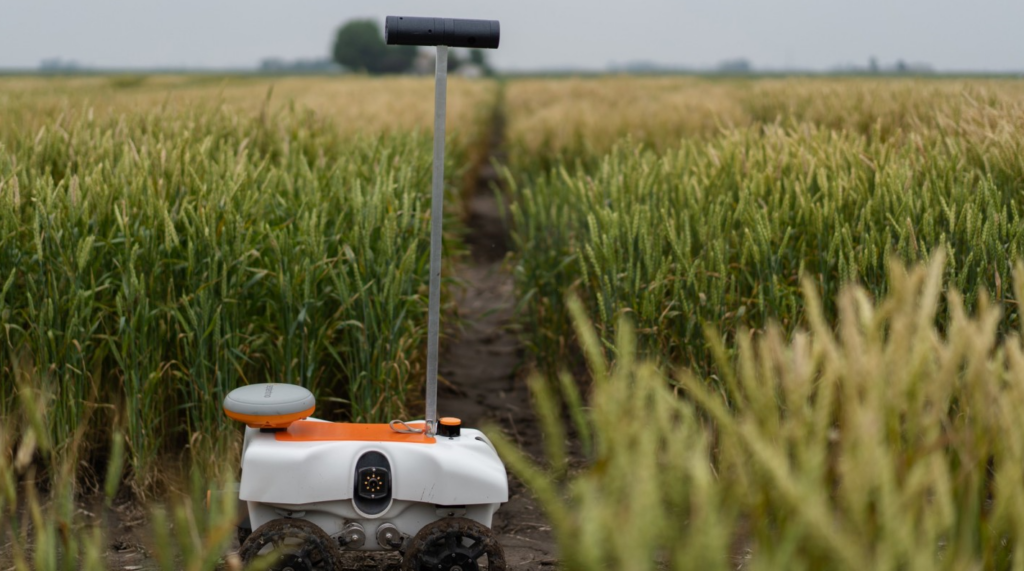
KWS is using the TerraSentia robot to collect phenotypic data at its trials site in Illinois. PHOTO provided by KWS. “It’s moving in a very noisy and uncertain environment. We’ve tried to account for that by building a ruggedised robot so it can work well and collect good data under these conditions.
“Cameras can move around because the surface the robot is working on isn’t very stable, and they can also be blown about by the wind. We’ve incorporated allowances in our machine learning algorithms to account for any variability in the data due to these issues.”
The robot routinely does the legwork that humans would do, but it’s the AI, or computer vision that’s currently learning to interpret the images the robot is capturing that could be the game-changer.
“The idea behind this ‘precision breeding’ strategy is to make a shift from selecting the best to designing the best.
Girish describes the machine learning process as creating a large set of data labelled by humans. The data is fed to machines and its software generates knowledge from experience by means of repetition, identifying patterns in the data that relate to traits, diseases, or growth stage, for example.
Its neural network is then able to create a new mathematical model, an algorithm, as it ‘learns’. Once the artificial intelligence has obtained enough knowledge from humans, it uses it to compare new images and identify phenotypic expressions. In the case of the robot, it evaluates the pictures of plants without the need for human assistance.
KWS wheat breeder Mark Christoper explains how the robotic trials are going. “The fact that the robot can operate continuously and independently means it’s able to collect data on more material than we’ve been able to in the past. This will allow us to make more informed selection decisions, especially in our younger generation breeding nursery where we have hundreds of thousands of individual rows and it’s just not feasible for humans to collect all the data.”
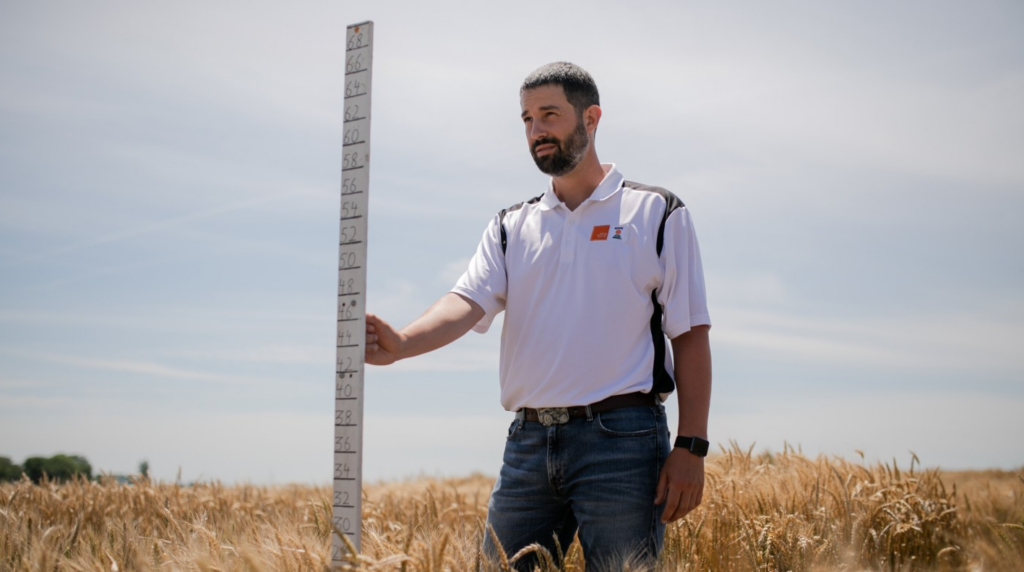
Wheat breeder Mark Christopher is measuring the height of wheat in the field, a task the TerraSentia robot is now being trained to perform. PHOTO provided by KWS. So far, the trials work has shown that the AI model is able to identify traits such as awn type and heading date using plant images from the trial field. It’s also highly accurate, with results showing that the AI detects emerged ears with 96% reliability and that it can identify whether an ear is completely awned, or not, 92% of the time.
More recently the data collected has been expanded to look at additional traits such as plant height and disease severity.
“Comparing robotics and humans, they each have their own strengths. The robot will be very good at providing very objective, high-quality data for specific traits, but the human is required for making those subjective advancement decisions. And then there are certain things that the breeder’s eye is required for,” he adds.
It’s an important point that humans are not being replaced in the breeding process, but instead AI is augmenting their decision-making, adds Mark. “Data provided by the robot will add precision to the decisions that we make, and this will help us produce better varieties.”
Predicting germination
There are other tasks where AI and machine learning could lend plant breeders a helping hand – one of those is germination testing. Recently, researchers have taught a new tool – SeedGerm – how to do it using machine-learning-driven image analysis.
The innovative machine has been developed to perform the process in a semi-automated way and is the result of a collaboration between the Earlham Institute, the John Innes Centre, Syngenta and NIAB.
Carmel O’Neill, research assistant in the Penfield Group at John Innes Centre explains that currently most seed germination is recorded manually. “Compared with this, SeedGerm presents fast, accurate, high-throughput screening and will be of major interest to crop seed production companies and research programs screening large germplasm collections.”
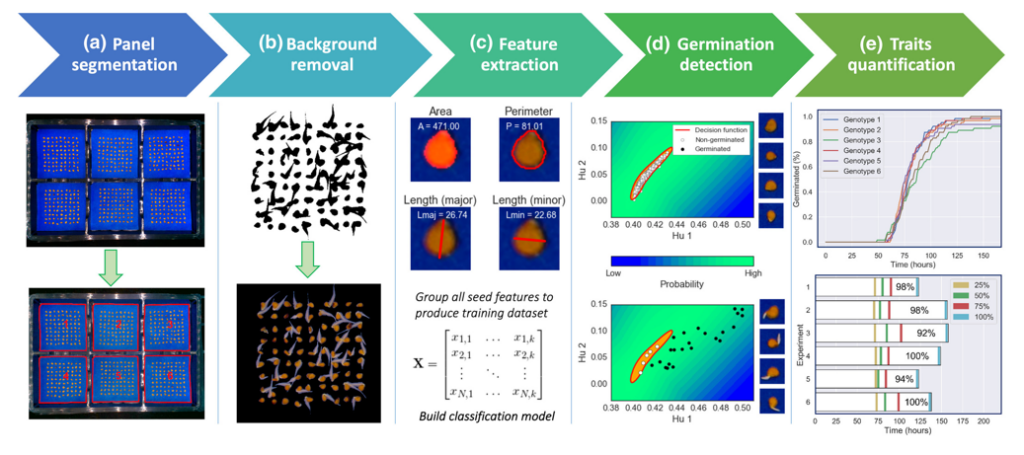
SeedGerm is a cost‐effective phenotyping platform for automated seed imaging and machine‐learning based phenotypic analysis of crop seed germination. Source: New Phytologist, Volume: 228, Issue: 2, Pages: 778-793, First published: 13 June 2020, DOI: (10.1111/nph.16736) SeedGerm uses a cabinet equipped with cameras which take photographs throughout the germination process, documenting each stage from imbibition (seeds taking up water) through to the emergence of the root, and further changes in the newly growing plant.
Supervised machine learning is used to automatically determine how germination is progressing by comparing images. Algorithms can be trained to predict how likely it is that a seed has germinated based on measurements extracted from an image that relate to the seed’s size, shape, and colour.
Seed germination experts from Syngenta have confirmed the effectiveness of SeedGerm for measuring germination rate and seedling health across five major crop species, including tomato and oilseed rape, opening the way for SeedGerm to replace manual seed scoring.
In addition, the power of SeedGerm to measure phenotypic changes over time has further novel applications in crop improvement research. Many of the characteristics that can be measured help to estimate performance in the field in terms of canopy closure, weed suppression and predicted yield.
RNA Sequencing
While AI is already bringing evolution to breeding programmes, the main focus in plant breeding is on DNA and the genes within it. But a revolution may be brewing that’s focussing on sequencing RNA and the importance of gene expression.
In simple terms, genotyping data identifies the DNA sequence and provides an indication of potential (the presence or absence of a gene that are predictive for a desirable trait), whereas RNA sequencing (RNA-seq) gives biological meaning (or what will likely happen) by quantifying how much the gene will be expressed and other coregulated genes.

AI is being harnessed at TraitSeq to produce prediction models from RNA-sequencing data. This will help breeders select for complex traits, believes Joshua Colmer. “This is significant because it highlights a limitation when only using DNA-based methods for marker-assisted breeding,” says Dr Joshua Colmer, cofounder and CEO of agritech startup TraitSeq. “Analysing DNA alone doesn’t present the full picture, especially in cases where traits are complex – meaning they’re affected by multiple genes.”
Many of the traits that plant breeders are looking for are complex in nature, such as drought tolerance or nutrient use efficiency, and consequently these characteristics are hard to breed for.
TraitSeq’s platform technology uses bespoke machine learning methods and bioinformatics tools to identify biomarkers. These are then used to train phenotypic prediction models for complex traits in crop plants. Using its proprietary RNA-seq analysis methods, the company aims to help breeders by predicting phenotypic outcomes for complex traits to help inform selection decisions and optimise breeding programmes.
TraitSeq’s IP was developed by Joshua during his PhD at the Earlham Institute, where he used machine learning to develop models that were able to successfully predict outcomes from RNA-seq data to a high level of accuracy – including the prediction of turnip mosaic virus infection, human cancer subtype classification, and the diagnosis of COVID-19 infection.
It’s this computational capability that could bring a new dimension to plant breeding. The technology has the ability to accurately predict measurable targets that relate to changes in phenotype, physiology, or metabolism under varying environmental conditions.
“We could predict the field performance of a trait based on glasshouse trials, for example. This is also an aspect that crop protection companies are interested in to help them screen potential new active ingredients – identifying those that are likely to fail in the field so that they can be removed from the innovation pipeline without running costly field trials,” explains Joshua.
The same can be done in variety trials which could significantly speed up the breeding process. “What is exciting is that where traits were previously difficult or expensive to measure in field trials, TraitSeq can be used as a predictive phenotyping tool. As sequencing prices continue to fall, it will become a more cost-effective way to phenotype those traits and implement them into a breeding program.
“The types of traits this is applicable to aren’t limited to yield, disease resistance or nutrient deficiency. It could be applicable to quality traits like protein content or water absorption for baking quality,” he adds.
Another advantage of RNA-seq technology is it reveals how genes regulate each other. “With a sufficiently large data set, you’ll be able to identify genes that regulate the expression of other genes. And by manipulating the expression of transcription factors, it might be possible to predict how that could affect other traits [such as yield] downstream.”
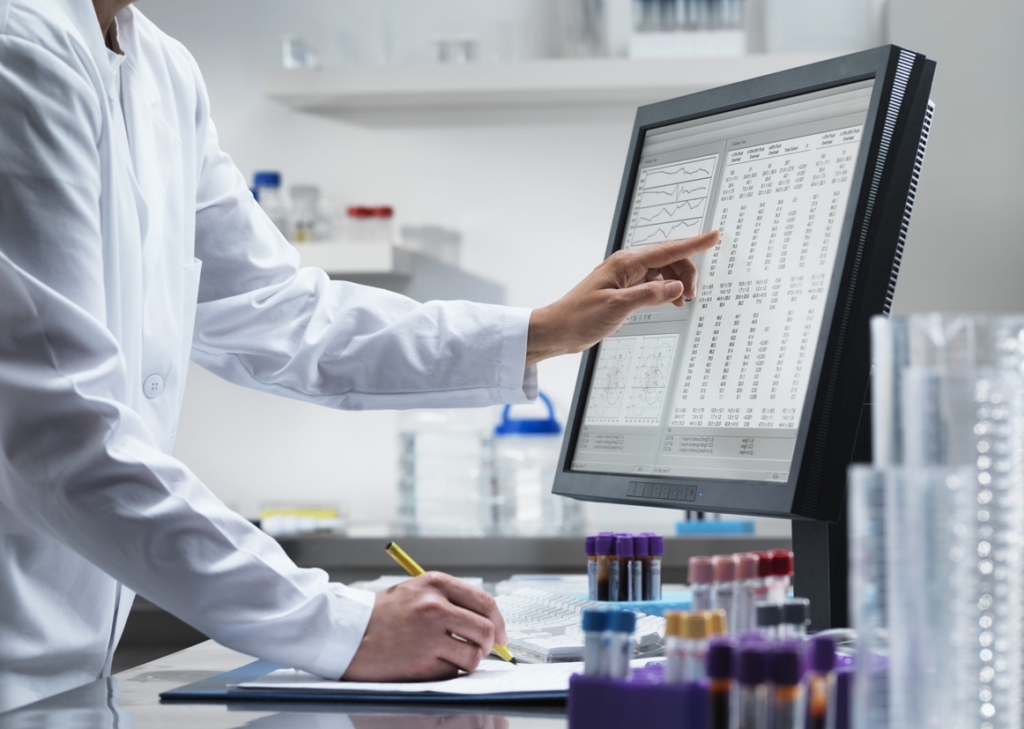
TraitSeq technology can be used as a phenotyping tool under varying environmental conditions, negating the need for costly field trials. It’s still early days for the company that has recently spun out of the Earlham Institute and received funding from UKRI’s Innovation to Commercialisation of University Research (ICURe) pilot programme. This backing, together with substantial funding from Anglia Innovation Partnership and Innovate UK, is enabling TraitSeq to work with companies on pilot projects.
The biggest hurdle to commercialisation at the moment is the current cost of RNA-seq compared with genotyping, reflects Joshua. “Breeding companies have invested significant resources into marker-assisted breeding methods and developing genotyping platforms. The assays they use cost on the scale of pence per datapoint, whereas RNA-seq is around £200 per sample. It’s a huge difference in cost so we have to demonstrate there’s a lot of added value in RNA-seq technology, particularly in its ability to enable the prediction of complex traits.”
Joshua predicts the cost of the testing will come down considerably. “It’s not unreasonable to expect RNA-seq to be £30-50 per sample in three to five years. However, we can use qPCR as another means of quantifying gene expression, which is a much cheaper method. Once our algorithms identify gene expression markers for a complex trait from RNA-seq data, we can develop a qPCR assay to test for it which brings the cost down to around £10 per sample.
“All the while we are constantly developing our computational platform for RNA-seq data analysis. So once the technology becomes cheaper and more widely adopted, we aim to be the go-to solution for companies to obtain meaningful insights from the big data they will be generating,” adds Joshua.
And there’s no doubt that big data, in all of its guises, is informing food production throughout the value chain. Yet the advancement of AI isn’t without concerns.
In a cautionary tale, The Matrix hit the big screen 25 years ago. Set in 2199, the film depicts humanity enslaved by a cyber intelligence that it had created – ‘the machines’ had taken over. The reality in 2024 is that much of AI use is pretty mundane but the potential for misuse remains. So to protect against this, UNESCO set out an ethics framework for AI systems in 2021, one of which is that human supervision is vital.
Perhaps the ingenuity of humans in creating AI capabilities will be invaluable in meeting the world’s climate and food security challenges. As long as ‘the machines’ won’t be making the actual decisions…




-

SFI funding brings precision promise
There are new payments to encourage the uptake of precision farming, and increasingly powerful platforms to implement it. Steve Butler, Agrovista precision specialist, examines some of the benefits on offer.

Precision farming has been gaining traction on UK farms for the past 20 years, aiding crop production, farm efficiency, grower knowledge and ultimately, business profitability.
One of the key contributors that has helped increase the speed of uptake over the past decade has been variable rate (VR) technology, thanks to improvements in data collection and interpretation as well as ongoing advances in application technology.
As such, VR has become a proven practical tool that is no longer an overly complex or expensive addition to farming practices.
The introduction later this year of Sustainable Farming Incentive (SFI) payments for VR applications, along with Farming Equipment and Technology Fund (FETF) grants to help with the cost of equipment, make it even more attractive.
This, and the fact that an ever-growing number of farms have access to VR machinery, is likely to encourage a further significant uplift in the number of growers using VR.
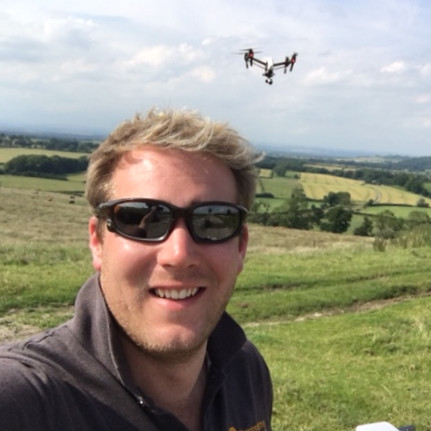
Me! SFI payments are worth £27/ha/year, where “VR application technology is used to apply nutrients on arable, horticultural land or improved permanent grassland, to match the nutrient needs of crops in different areas within land parcels”. This provides a fixed-cost benefit against the variable costs of nutrients even before growers know the extent of nutrient variation across their land.
The ability to apply key nutrients, such as nitrogen, phosphorus, potassium, manganese and lime, as well as seed, to match crop demand helps make more efficient use of targeted inputs. This can lead to higher yields and more even crops, creating further efficiencies with fungicides and herbicides, helping fields perform nearer to their true potential.
Of course, the field maps required for VR are only as good as the data used to make them. Advanced software, such as OneSoil Pro now on offer from Agrovista, processes up to seven years of existing satellite imagery to analyse individual fields.
This takes into account NDVI (vegetation index), soil brightness (soil type) and elevation. The data is then crunched, dividing the field into zones based on crop productivity potential.
Yield maps can also be uploaded to enable the software to generate a yield report for the different zones, to aid decision making further.
Control strips can also be established automatically within separate productivity zones, enabling growers to assess the effect of different input rates on crop yields over several seasons to fine-tune applications.

The system also highlights the productivity percentage change when creating VR applications of seed or fertiliser compared with standard rates for each zone. This shows how different zones are responding to various rates of inputs. providing a basis for discussion how these could be tweaked to further improve crop performance.
Variable rate nitrogen
Targeting nitrogen according to crop potential helps to minimise losses to air and water, so is more environmentally beneficial than flat-rate applications. It also helps to even up crops, typically leading to 3-5% yield increases.
OneSoil Pro VR nitrogen maps are based on NDVI satellite data updated every 2-3 days, offer a near real-time snapshot of crop growth. Users can choose 3, 5 or 7 zones and choose how much to increase or decrease the rate from the standard application for each one.
Of course paybacks are still potentially very good without SFI funding – at current values a 3% yield increase on an 8t/ha crop of wheat would be worth £40/ha uplift in return, around nine times the cost of a platform like OneSoil Pro.
Variable rate seed
Applying seed variably is not new, but the accuracy of the operation is constantly improving. Many growers have used the +/- buttons on their drill box to increase rates on heavier parts of a field or areas prone to sub-standard establishment.
This basic form of VR continues, but the amount of data we can incorporate into today’s maps creates a far more robust and simple-to-use system, which is also a step up from the soil maps that have been the mainstay of VR seeding in recent years.

VR seed applications are based on all the data sources mentioned above. As with nitrogen, growers can split fields into 3, 5 or 7 productivity zones on which to base seed rates. Increasing and, in some cases, decreasing rates in areas according to in-field potential maximises return on seed drilled. We have seen an average yield increase of 4% using this technology.
Soil sampling
Grid mapping is where precision farming started in the UK. It is a basic, yet very important technique designed to bring and maintain soil nutrient levels to a given index, utilising VR technology on the fertiliser spreader.
Splitting fields into 1ha grids takes P, K, Mg and pH management to the next level. Using this information a bespoke plan for each field can be created and inputted into the display in the tractor cab for VR application, potentially improving efficiency and reducing input costs.
Given the importance of good soil sampling, and now with SFI funding available for soil management planning, Agrovista plans to use OneSoil Pro to place soil sampling points based on productivity zones rather than a standard grid system, offering even more accuracy to target remedial measures across the field than in the past.
In summary, precision farming offers much to enhance a farming business from both a cost and environmental aspect. If you already have the equipment available but don’t make use of it fully, or have the correct equipment but possibly just need an unlock from your tractor dealer, there is no reason not to try even just one field for VR of some sort.
Adopting VR will help you farm more effectively and efficiently, whilst helping to maximise profit from every hectare.
Working together
Agrovista Precision’s team can advise on a wide range of displays and in-cab controllers to enable VR applications. We can identify what can be done with a farm’s existing equipment or if additional leads or controllers are needed, for example.
For more information, please email precisionauk@agrovista.co.uk or call our dedicated support line 0115 921 8453.


-
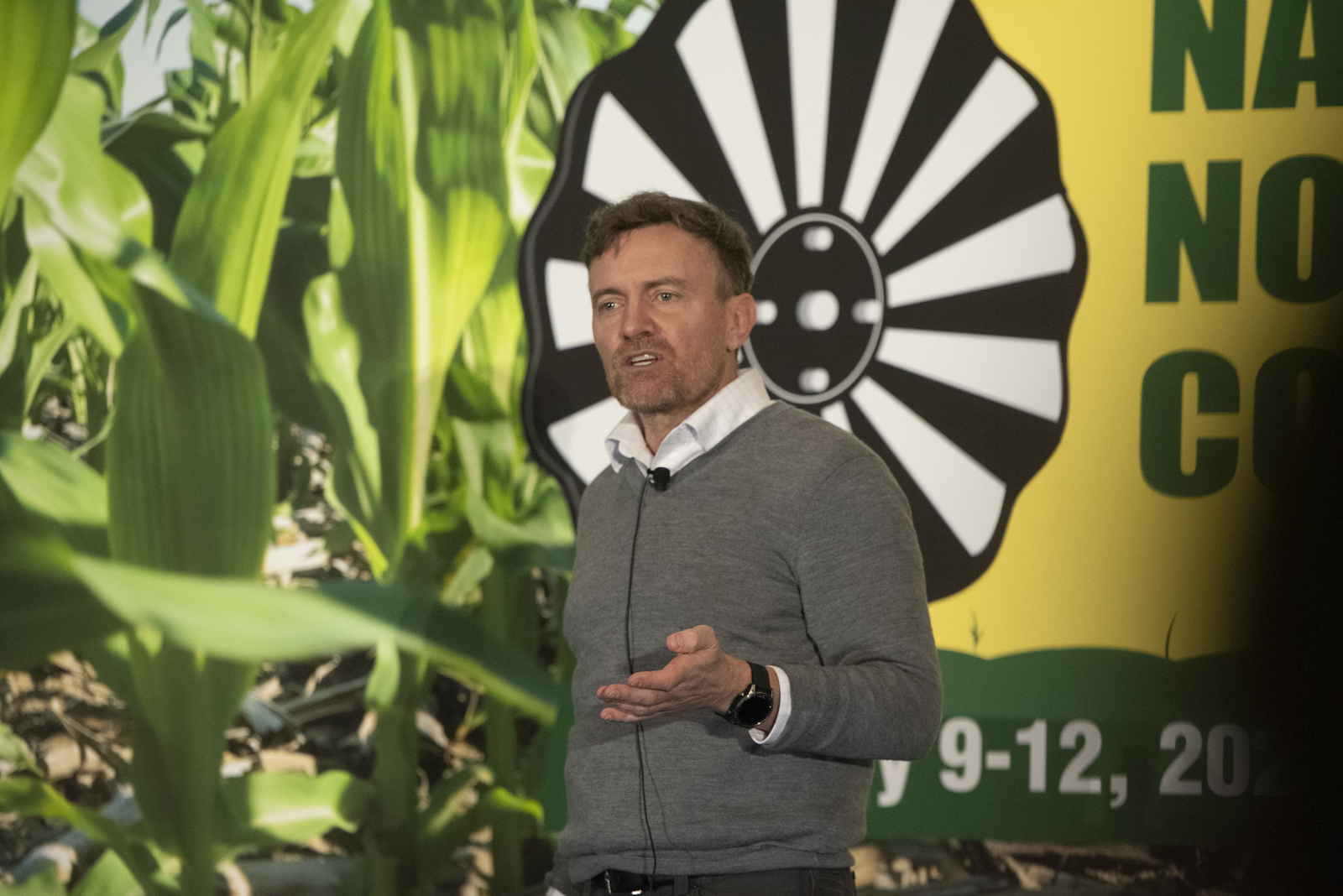
Use Analytics To Identify the Best Investments for Your No-Till Operation
Written by Noah Newman and published by No-Till Farmer, 30 January 2024
Clay Mitchell, no-tiller and co-founder of farmland venture capital firm Fall Line Capital, delivered a presentation at the 2024 National No-Tillage Conference on what no-tillers stand to gain from working with ag startups and new technologies.
During the presentation, Clay questioned how to identify the best investments for your no-till operation.
“It’s important for all of us making investments around the farm to consider the expectations of ROI,” says Clay. “For example, I put up a new storage building this year, poured some concrete and bought electronics. What’s my expectation for the return on each of these things?”
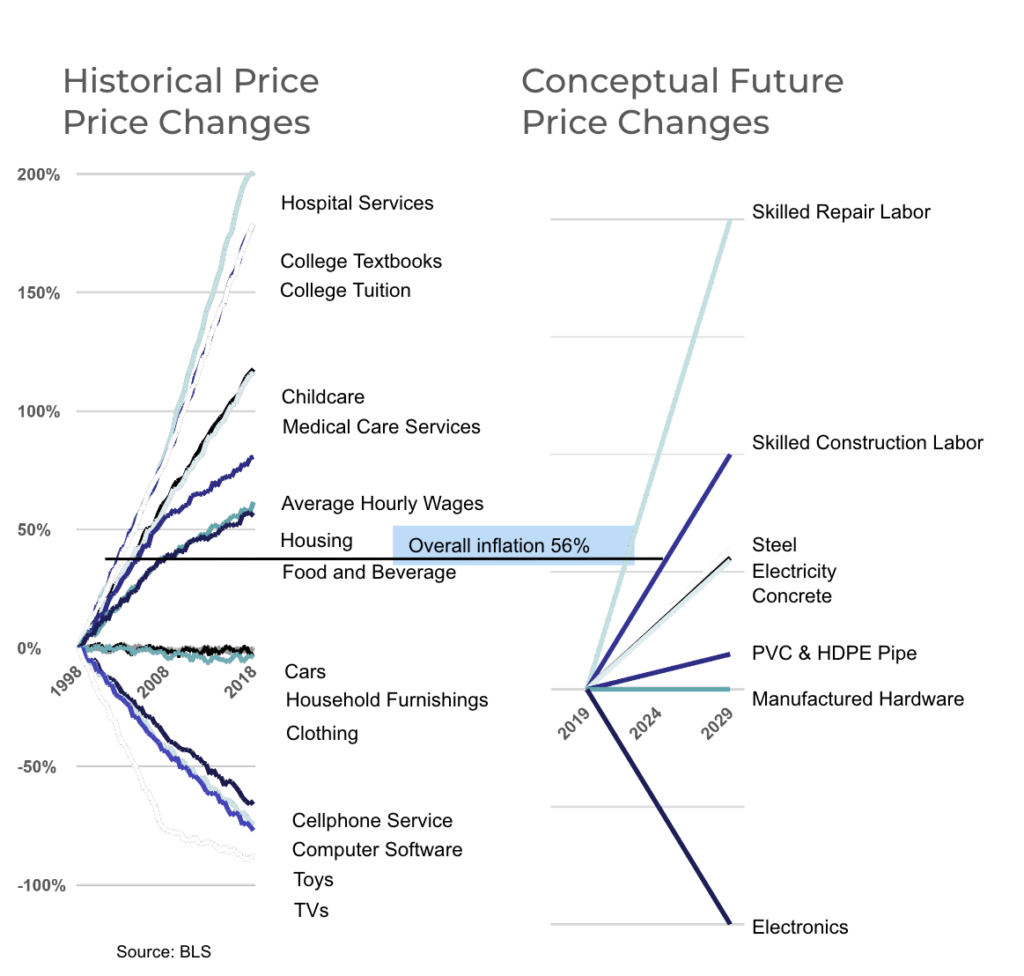
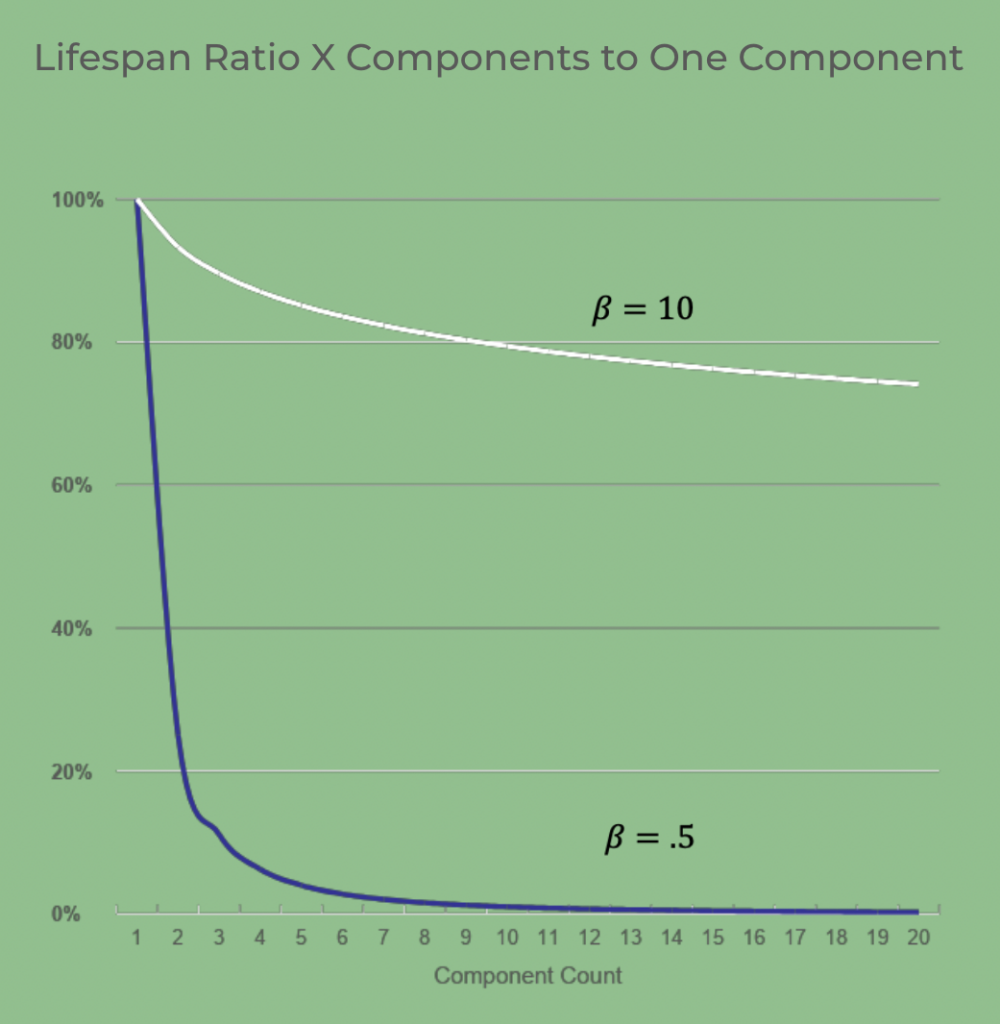
Clay takes an analytical approach to answering that question using the graphs below.
The graphs on top show the price changes of certain services and items from 1998-2018 (Historical Price Changes) and where Clay expects them to go over the next decade (Conceptual Future Price Changes). The graph in green (Lifespan Ratio X Components to One Component) compares the lifespan of systems with multiple components and systems with a single component. He describes the beta number in the green graph as follows:
“With a low beta (0.5) probability distribution, there are high failure rates initially, like the electronics that don’t work, but ultimately work if you fix the bad plug,” says Clay. “The high beta (10) represents things that wear out, like cultivator shanks and transition cones. When your machines are down, how often are you dealing with wear out failures, and how often are you dealing with things that are low beta?
“The overall message here is to think about it in an analytical way. Look at your system and identify places where you could build redundancy. Ask yourself which things are most likely to fail. And be aware, as you’re adding a lot of complexity to machines, there can be a cost to that.
“Unless I can operate without the extra feature, is there a limp home feature? Can I run without it? Or am I adding things that I must operate for the system to work? And if that’s the case, then you may need to simplify and back down, but it’s worth thinking through and trying to be analytical about it.”
Building redundancy in a system is key to maintaining its reliability and elongating its lifespan, but unfortunately, there isn’t a lot of redundancy with farm machinery right now, says Clay.
“I’m a pilot, and we have a lot of systems that are completely duplicated on an airplane,” he says. “There’s redundancy for the fuel system, navigation systems and radios. If one fails, there’s another one.
“I can’t think of anything on the combine that works that way. If the chopper bearing goes out, you don’t just hit the backup, you’ve got to fix it. As these machines get more complex, we’re just adding all these things that have to work. Airplanes are complex, too, but there are extreme efforts that are put into maintenance, repair and engineering that comes with a high cost to make sure everything is reliable.”
Looking at the graphs above, the inflation rate for hospital services, college textbooks and tuition have gone way up, whereas TVs, toys and computer software have plummeted. What does this information mean for your operation?
“I imagine that skilled labour is going to go way up in cost,” says Clay. “The complicated stuff that’s breaking down a lot is going to cost more and more to fix. Electronics are going to come down.
“For the things I expect to go up, there’s also more of a willingness to pay for them to make sure you’re building them in a reliable way that makes them last for a while. For example, the PVC and steel for our irrigation systems have doubled or tripled in price since we’ve installed them. It’s made for a better investment, and it was good that I put a lot of effort into making them reliable,” he concludes.


-

Soil Association Exchange – Building business resilience through measurement
Ben Makowiecki, Agricultural Sustainability Director at Lloyds Bank, sets out the Bank’s ambition and actions in supporting Agricultural businesses to reach net zero.
Building resilience is much talked about in UK agriculture. We all know the myriad pressures the industry is facing – from a changing climate, reduced government financial support, and a valid focus on the need to produce and eat more of our UK grown food.
Understanding how your farm is going to respond is crucial, so as part of our longer-term commitment to the sector, we provided initial funding and support to set up Soil Association Exchange. Exchange has been developed by a team of industry experts, scientists, and farmers and is designed to look at the entire farm – not just carbon – to help farmers measure their whole farm’s impact over six key areas, including soil health, water, and biodiversity. It provides a platform to input and store that information and offers access to a host of support and advice, including benchmarking tools that help compare an individual farm to industry averages and tools to help navigate funding.
How Soil Association Exchange works
There are two ways to access Exchange:
Exchange Explore is a free version of the online measurement tool where a farmer enters their own environmental data like soil samples, bird counts and so on. They can then benchmark against other farmers and seek advice and funding information
Exchange Excel is a bespoke paid-for consultancy version involving a farm visit to collect data, as well as remote data like satellite information. A local Exchange agricultural adviser then creates an improvement plan with the farmer, which they can choose to implement, and helps identify appropriate financial rewards, including reducing costs and extra income. Farmers can also choose to share their data with others, for example, higher up the supply chain, to prove the impact of their practices.
Measurement
Measuring environmental outcomes can be complicated, so to ensure the credibility and constant improvement of how to measure sustainability, Exchange always makes its measurement methodology open to critique and commissions a leading scientist to review methodology. It also works with farmers, scientists and industry to ensure metrics work for everyone involved, and the methodology is reviewed by an independent scientific advisory panel. So from soil structure and chemistry, to woodland connectivity, nutrient runoff and water quality, and greenhouse gas emissions, this means the measurement protocol and end-to-end process of generating an ecological farm score has therefore been thoroughly researched and planned.
Such measurement is very encouraging, especially to Beth Metson, head of farming advice at the Soil Association Exchange. “This is where we think we can really add value to every farm we visit. The data is fundamental – but it is the translation of the data into tangible actions that farmers think is truly valuable. Seeing where you might not have scored so well, and creating an action plan of what you can do to improve over time.” Exchange therefore pairs the advice a farmer receives with practical guidance on where they might access funding, helping to incentivise a busy business with many priorities “Without profitability we won’t have these businesses to look after the environment, so farmers need to be fairly rewarded for all the different solutions that they’re part of.”
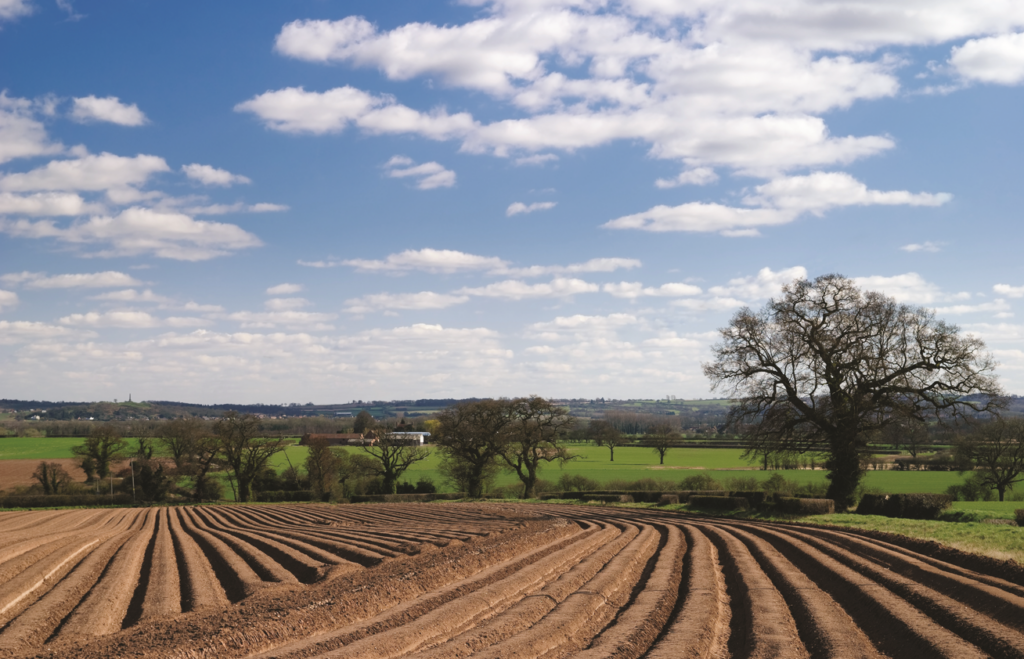
Finance
Exchange can assist farmers in navigating financial options, including grants to reduce water pollution, sequester carbon, improve biodiversity, and a host of other measures including government schemes.
Improving farm resilience is also of benefit when it comes to borrowing money. From a Lloyds Bank perspective, an environmentally sustainable farmer is a financially sustainable farmer. We want everyone to transition to a point where they can mitigate the risks and become more financially sustainable. There are providers now offering discounted rates for sustainable projects – but it’s the additional income stream from environmental credits that will drive real change. Farmers have a huge opportunity to reach net zero for the agricultural industry and to sequester carbon for other industries, and financially benefit from that, which is so important.
The future of farming
We’re now also seeing farmers buy into the broader rational and relevance of what Exchange is trying to achieve. A good example of this is Robert Fleming from Castle Sinniness Farm, who saw the benefits being more than just measurements. “We got involved very much to help our own business decision making, and that goes hand-in-hand with doing the right thing environmentally. We need to take responsibility for what we do, and for where we stand now – so we know the story from the very beginning.”
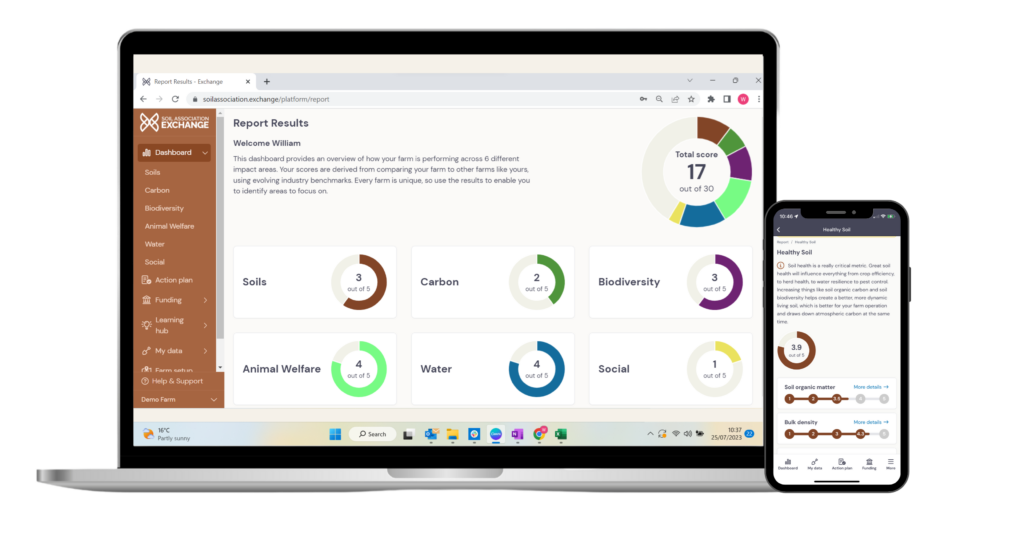
Knowing there are options to how a farmer decides to engage with Exchange is something Jerry Alford, farmer, and Soil Association advisor, suggests is where things get really exciting. “We can’t get on the ground and visit every single farm in the UK. But having an option for farmers to input their own data and start using the platform themselves, even if they are smaller farmers, is a great ambition. Farmers know their land inside out, but having one place that pulls it all together will be tremendously useful for them, and in the future, they will be able to see the impact of the changes they make now, which will be really powerful.”
Whichever way a farmer decides to work with Exchange, I can’t help but share in Jerry’s excitement as the potential behind what Soil Association Exchange and its partners can provide to UK farmers over time is definitely something worth investing in.
If you would like to find out more about Exchange, please visit www.soilassociationexchange.com
Lloyds Bank plc authorised by the Prudential Regulation Authority and regulated by the Financial Conduct Authority and the Prudential Regulation Authority under Registration Number 119278.



-

Feeding the world or seeding unknowns?
New legislation now allows the growing of certain gene-edited crops in England. Professor Jonathan Jones, group leader at The Sainsbury Laboratory, Norwich, calls for a fresh approach to rules preventing the cultivation of GM crops. But Roger Kerr, chief executive at Organic Farmers & Growers urges caution over moves into new genetic technologies.

I’ve been using the GM method to confer specific traits on plants for 40 years. It enables benign and useful crop modifications to reduce the environmental impact of agriculture, especially by using genetics to replace the pest and disease control methods currently provided by agrochemistry. I’m still regularly astonished at the way this nature-based solution to crop improvement has been so misrepresented and vilified.
It is now more than 13 years since my team at The Sainsbury Laboratory in Norwich first conducted field trials of potatoes modified using the GM method to resist late blight disease. Those early trials were not near market – they only carried one resistance gene – but we now have Maris Piper lines with three resistance genes that are likely to remain resistant for a long time. Farmers currently spray around 15 times per year to control late blight. This requirement could be removed (although some sprays might still be required to control early blight).
The Conservative government pledged post-Brexit to liberate Britain’s “extraordinary” biosciences sector from the EU’s anti-GM rules, and “to develop the blight-resistant crops that will feed the world.” Might this finally become possible?
Credit where credit is due, of course. Through the Genetic Technologies (Precision Breeding) Act, the UK government has moved to exempt gene-edited crops from those restrictive GMO rules where they contain no foreign DNA or could have been obtained through ‘conventional’ breeding methods. This is great progress and I congratulate the ministers who made the decision to move this legislation forward and the hard-working and professional civil servants who implemented it.
The European Parliament has now voted to approve amendments to legislation on New Genetic Technologies (NGTs). The new framework for NGTs sets Europe on course to regulate certain gene-edited plants in the same way as their conventionally bred counterparts.

The European Parliament has voted to approve amendments to legislation on New Genetic Technologies which sets Europe on course to relax regulations on certain gene-edited plants. For crops developed using the GM method, by contrast, the mood remains decidedly frosty among lawmakers on the Continent, and still cautious in the UK.
Many of the politicians who argued in favour of the Precision Breeding Act sought to emphasise the distinction between GM and gene editing, with the clear implication that GM crops are in some way less desirable, or perhaps even more risky, than gene-edited crops. This view has zero scientific validity and is exasperating for plant scientists like me who have devoted their entire careers to using the method for crop improvement.
It ignores the fact that GM techniques can deliver outcomes that other crop-breeding technologies cannot, for example in areas such as more durable pest and disease resistance, photosynthetic efficiency, nitrogen fixation and adaptation to climate change and abiotic stresses. It also ignores the emerging evidence from modern genomics of massive structural and other genetic variation within our crops before they even get near any Agrobacterium that might modify them. Compared to pre-existing variation, the variation we introduce using either GE or GM methods is tiny; we have lost all sense of proportion.
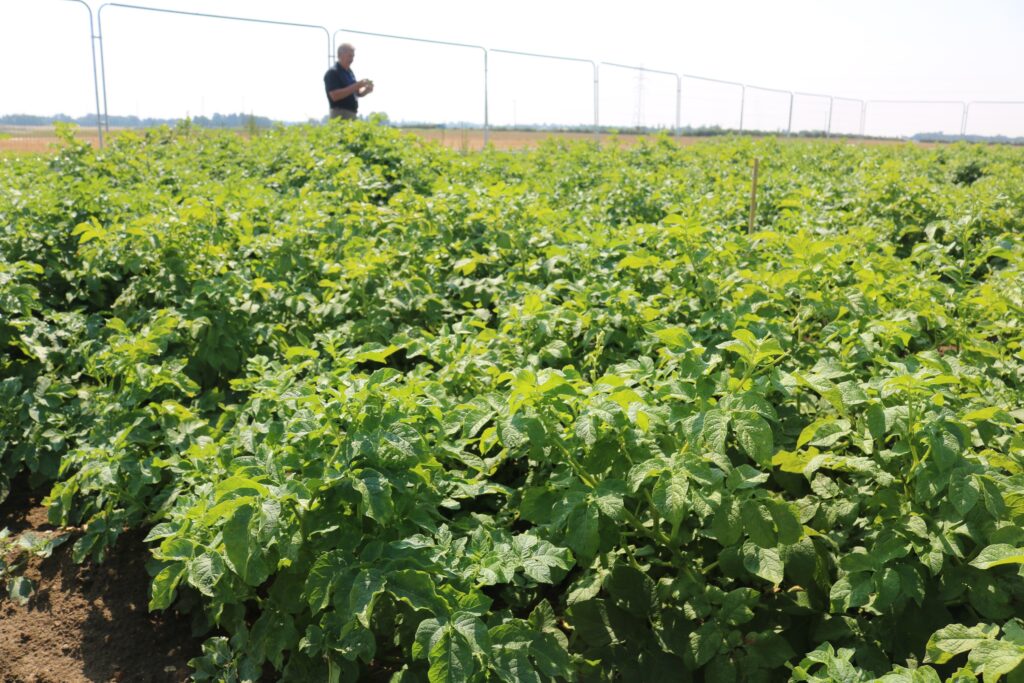
Maris Piper lines with three resistance genes to late blight almost remove the need for farmers to spray to control the disease, but are currently only available to growers in the US. When the GM method was first deployed, some thought there might be “unknown unknowns we didn’t even know we didn’t know about”. The “precautionary principle” was used to justify restrictive regulation of a crop improvement method that not only had never caused harm but had in fact resulted in benefits such as reduced insecticide applications. The precautionary principle understandably leads to regulation based on extreme risk aversion when knowledge is limited; such regulation should be reversible when decades of experience demonstrate that this risk aversion is no longer justified.
Scientific and regulatory agencies worldwide have repeatedly and consistently confirmed the safety of GM crops and foods. There has not been a single confirmed case of a negative health outcome for humans or animals from their consumption. Year after year, the technology has delivered significant economic and environmental benefits in those countries which have embraced its use. This scientific and empirical evidence has accumulated over almost 30 years from commercial cultivation and use of approved GM crops around the world, on a total area now exceeding 200 million ha.
In 2014, for example, a comprehensive meta-analysis of 147 studies found that growing GM crops helped reduced pesticide use by 37% while increasing crop yields (ie reducing the land required for crop production) by 22% and allowing more sustainable farming practices such as min- and no-till.
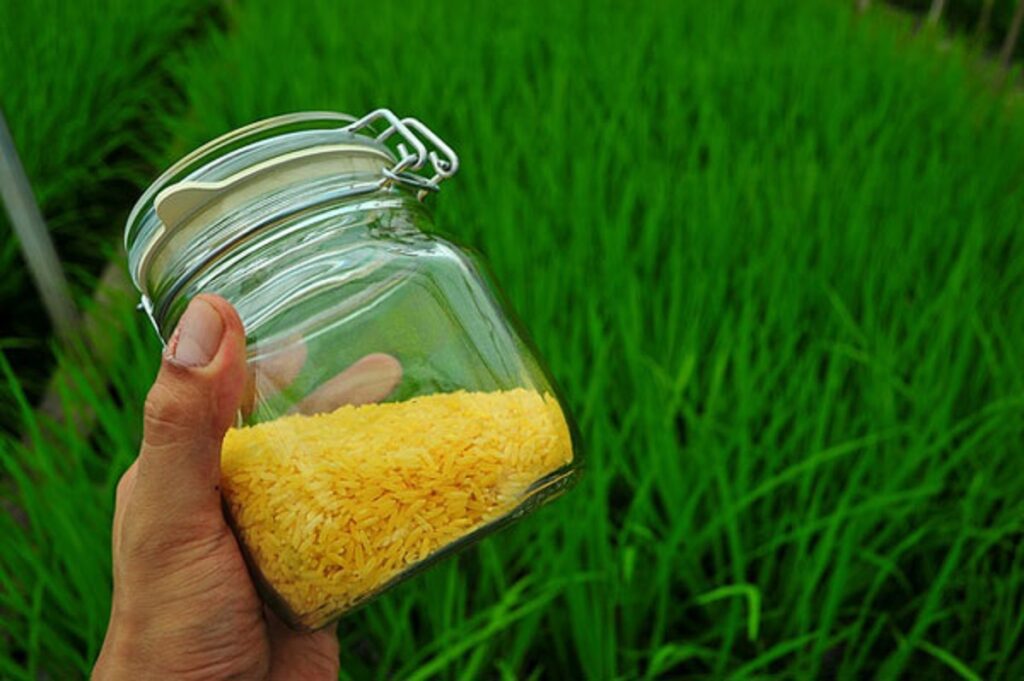
Greenpeace’s opposition to Vitamin A-enriched Golden Rice has been characterised as “a crime against humanity”. More recently, UK-based PG Economics concluded that GM crops have increased global food, feed and fibre production by nearly 1 billion tonnes (1996-2020), whilst helping farmers to reduce the environmental footprint associated with their crop protection practices by over 17%. The technology has also reduced carbon emissions, by an estimated 39.1 billion kilograms, arising from reduced fuel use of 14.7 billion litres and equivalent to removing 25.9 million cars from the roads.
These are hugely impressive results, but it turns out they represent only a fraction of the technology’s promise.
So while the adoption of GM crops has demonstrably contributed to increased crop yields, reduced pesticide use and lower carbon emissions, recent research published in the American Economic Review suggests that national bans or overly-restrictive rules on GM crop cultivation have also limited those global gains to just one-third of the technology’s potential. The study’s authors also note than poor countries would benefit most from lifting such restrictions.
That’s why the green NGOs campaigning against GM crops have so much to answer for. And why Nobel Laureate Sir Richard Roberts characterised Greenpeace’s opposition to Vitamin A-enriched Golden Rice as “a crime against humanity.”
It is also why the UK government should re-evaluate its implementation of current GM regulations and explore the potential for more proportionate risk assessment and data requirements, based on the specific properties conferred by each introduced trait, the intended use and the receiving agricultural environment.
Given the UK’s academic plant science and commercial plant-breeding expertise, the country has a great opportunity to use the GM method for the benefit of its citizens, to reduce the environmental and biodiversity impact of agriculture and to enhance international food security. It offers the potential to decrease the land required to meet our food needs and so free up more space for nature, decrease our dependence on food imports and our reliance on agrichemicals, and so decrease the economic and environmental costs of food production.
GM crop innovations developed in the UK are already being commercialised in other countries with more proportionate regulatory regimes. Outside the EU, the UK is no longer bound by an approach to regulation that is based on the scientifically unjustified idea that there are intrinsic risks in using the GM method. Instead, it can take advantage of the experience of almost 30 years of commercial use of GM crops to ensure its regulatory processes are proportionate to the potential for risks of specific traits in individual organisms, rather than the technology that delivers those traits.
Spurning the use of GM creates a substantial, and avoidable, opportunity cost, and that is why we urge the UK government to take a fresh look at the UK rulebook on using the GM method for crop improvement.
Organic advantage

With the government giving the green light to genetic modification (GM) in the Genetic Technology (Precision Breeding) Act 2023, it is now more critical than ever to ensure the implementation of this new legislation protects the integrity of crop and livestock genetics, the environment and human health.
As a consequence of the new legislation a robust regulatory framework surrounding this must be enforced to ensure the responsible roll out of this largely untested new technology.
The organic sector has successfully operated under such a regime for the last 30 years where assured food safety and supply chain integrity has taken precedence in ensuring consumer confidence.
Given genetic editing (GE) is a new, powerful and largely novel technology there is no arguable reason why genetic engineering should not have to comply with a stringent oversight regime to ensure the integrity of UK food and farming is protected.
While there is the possibility of genetic engineering advancing some genetic traits in crops and livestock, there is also the real potential for negative outcomes, a significant concern recognised by 88% of individuals and 64% of businesses who said they supported the continuing regulation of genetically modified organisms (GMOs).
The genetic composition of plants and animals has evolved to respond to the conditions they find themselves in and human intervention has sought to manipulate those traits that are advantageous through a natural process of selection.
Genetic engineering attempts to subvert this process through the introduction or silencing of genes through direct invasive manipulation of a plant or animal DNA. We are told this is natural, but that is far from being the case.
We simply cannot ignore the scientific evidence that genetic editing or modification has led to unintended consequences. This was the case of CRISPR-Cas being used to dehorn cattle in the US, which inadvertently introduced antimicrobial resistant genetic sequences.
The history of chemicals such as paraquat and DDT shows the dangers of releasing materials en masse into the environment when we do not fully understand their impact.
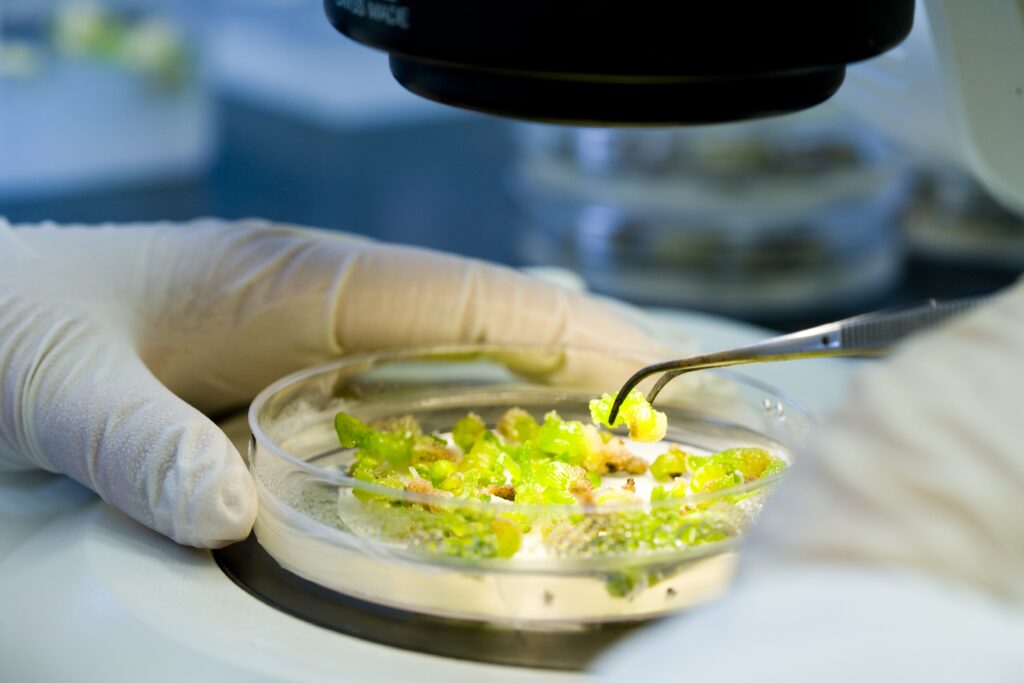
There are worries that genetic engineering attempts to subvert the process of natural selection through the introduction or silencing of genes. The problem with genetically engineered material is once it is released it cannot be withdrawn, as the material will have pervaded the environment and so the precautionary principle must be strongly adhered to.
Deliberate release of genetically edited materials must only be approved when a sufficient independent assessment has been made to ensure there are no risks of damage to human health or the natural environment.
Where a technology is unproven any use must be properly monitored to ensure an evaluation of their effects can be properly calculated over time.
Moreover, significant emphasis must be placed on whether any intended release is truly beneficial to the community and fulfils the necessary criteria for sustainable development.
OF&G is by no means anti-progress, but there is a lot more that can be done, indeed that is being done, before we reach for what some suggest is a ‘silver bullet’.
If we deal with the fundamental farming and societal issues first and get to 98% of where we need to be using nature-first approaches, and then GE takes us that last 2% over the line, that may be all for the better.
But starting with GE, thinking it is going to solve all our problems, is a back-to-front approach. Especially when there is a complete lack of any assessment (long- or short-term) into potential hazards to human health or the environment from its use.
Scientific research has shown the organic approach to food and farming helps by moving the damaging implications of over-production and over-consumption to within safe limits and planetary boundaries, balancing trade-offs in ways that are beneficial to the environment, while feeding the world.

Coexistence legislation to ensure effective separation of GE and non-GE derived foods would give citizens the ability to decide which they want to consume. The aim in organic food systems is to replace synthetic chemistry by working with and restoring natural ecosystems. The success of this approach is clear and evidenced by the successful work of organic farmers in the UK and around the world over many decades.
Natural plant-breeding methods have achieved much over many centuries and could achieve much more, especially when focused on less intensive and less extractive systems, where increased funding would provide further focus on the development of traits appropriate to restorative farming systems.
If 10% of English farmland was converted to organic as part of a wider multifunctional land use framework, it would deliver significant benefits. It is an area equivalent to a threefold increase from today’s 3.5% of land certified organic.
It is a relatively small percentage, but with enormous gains for the environment. It would result in a 3.64% decrease in English agriculture related greenhouse gas (GHG) emissions, which is equal to more than one million tonnes of CO₂e per year – the equivalent amount of carbon sequestered by a third of a million acres of broadleaved woodland while producing food.
Having no synthetic nitrogen applied across this 10% of English organic land would mean 9.4% reduction in total N consumption, which is equivalent to 179,000 tonnes less ammonium nitrate used per annum, while the removal of pesticides would mean taking out one million kg of insecticide, fungicide and herbicide active ingredients each year.

The aim in organic food systems is to replace synthetic chemistry by working with and restoring natural ecosystems. These are staggering figures that risk being overlooked by those blinkered by the GE promise.
This would also see farmland biodiversity restored in abundance – 78% more earthworm species, 35% more farmland birds, 23% more pollinators and 21% more field margin plant species, with soil biomass doubled.
The legally enforced organic regulation prohibits GE because it represents an unnatural and potentially environmentally destructive approach to food production.
Choosing organic represents an opportunity for shoppers to avoid consuming genetically altered food, assuming Government brings in coexistence legislation that ensures the effective separation of GE and non-GE derived foods. By doing so, this would give citizens the ability to decide whether they want to consume foods containing GE derived ingredients or not.
To that end, considered and progressive policies from government that support UK farming in delivering climate-friendly, people-positive food production and a real commitment to a consistent, thorough and well-resourced system-wide strategy is necessary.
This, alongside rigorous independent oversight and a clear definition of those technologies that represent a possible risk to the environment and human health.
Indeed, all these factors working together are going to be fundamental to this country’s ability to feed ourselves and protect our natural and farmed landscapes through what is predicted to be a very turbulent time for us all.




-
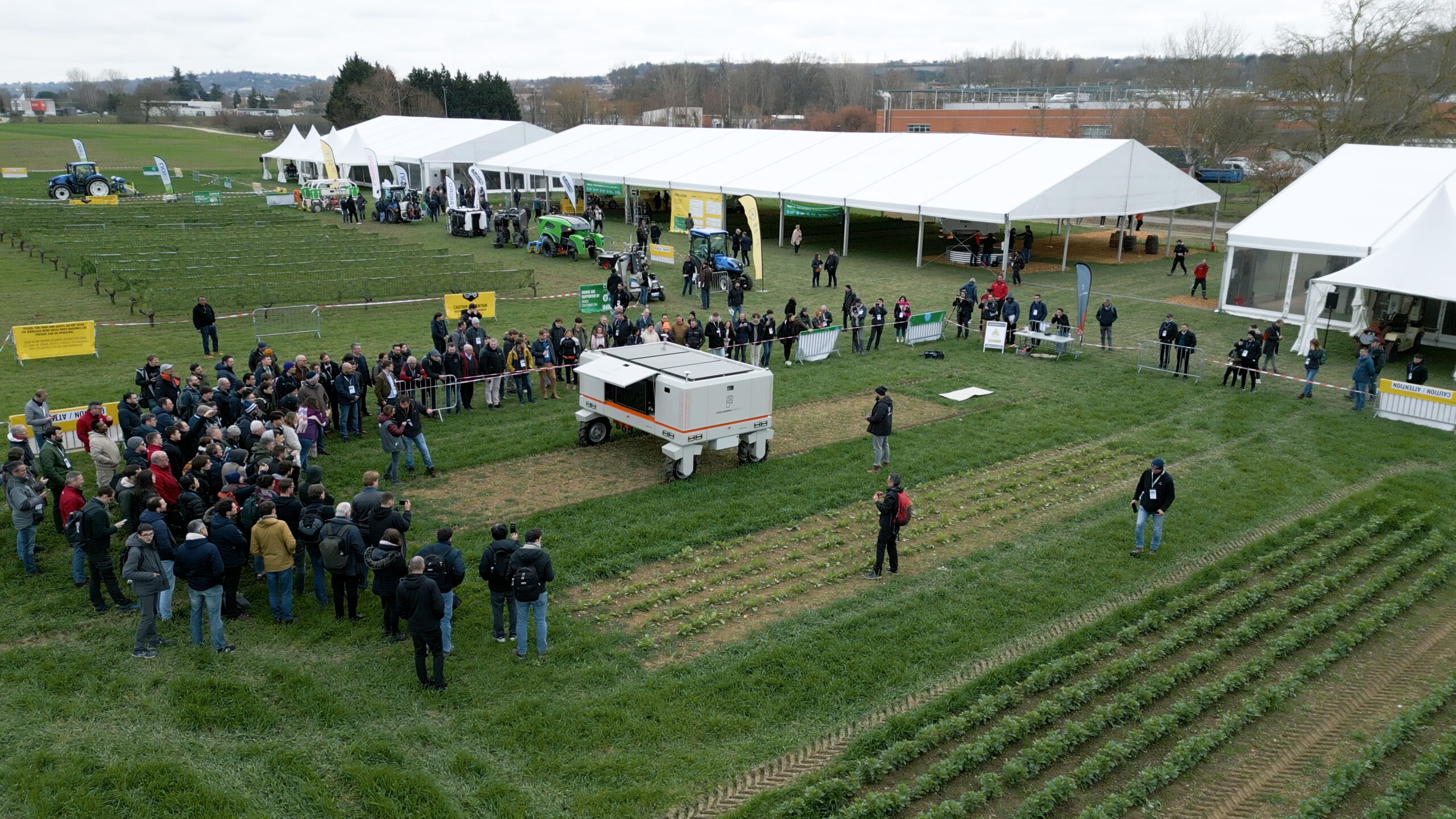
FIRA fires up enthusiasm for robot tech
The World FIRA event near Toulouse, France, brought together agricultural robotic enthusiasts from across the globe. Tech Farmer was there to spot the bots with promising potential.

With 35 autonomous solutions on display and demonstrated, more than 70 exhibitors and 2500 visitors, World FIRA (Forum for Agricultural Robotics) is gradually establishing its reputation as the world’s largest exhibition of agricultural robots.
The three-day event, that took place at the beginning of February was its eighth edition (the second from the field), bringing farmers, scientists, investors, journalists, and robotics enthusiasts from over 50 countries to the Agrobiopôle near Toulouse, France. Organised by the Global Organisation For Agricultural Robotics (GOFAR), it runs in conjunction with FIRA USA, with the next event taking place on October 22-24, 2024, in Sacramento, California.
The fifth FIRA Scientific Workshop explored four of the challenges facing robotics, and in particular how it helps farmers meet agroecological targets. FIRA’s first Hackathon tested the latest algorithms in a head-to-head problem-solving exercise to develop solutions for improving robotics safety. And start-ups got the opportunity to pitch to World FIRA investors.
At the heart of the show were demonstrations of autonomous robots, specifically designed for crops. There was a marked emphasis on kit for the European market, with plenty of innovations for vineyards, orchards and specialist crops. Row-crop growers had to search a little harder among the exhibits for credible autonomous successors to the tractor and implement. Nevertheless, a few solutions stood out in the triticale, garlic, bean and radish demonstration plots.
A star attraction was the Robotti by Danish manufacturer Agrointelli. It received the gold medal, voted by participants as Best World FIRA Robot. The new Robotti LR (Long Range) was on show, with the older 150D due to be phased out in 2024.
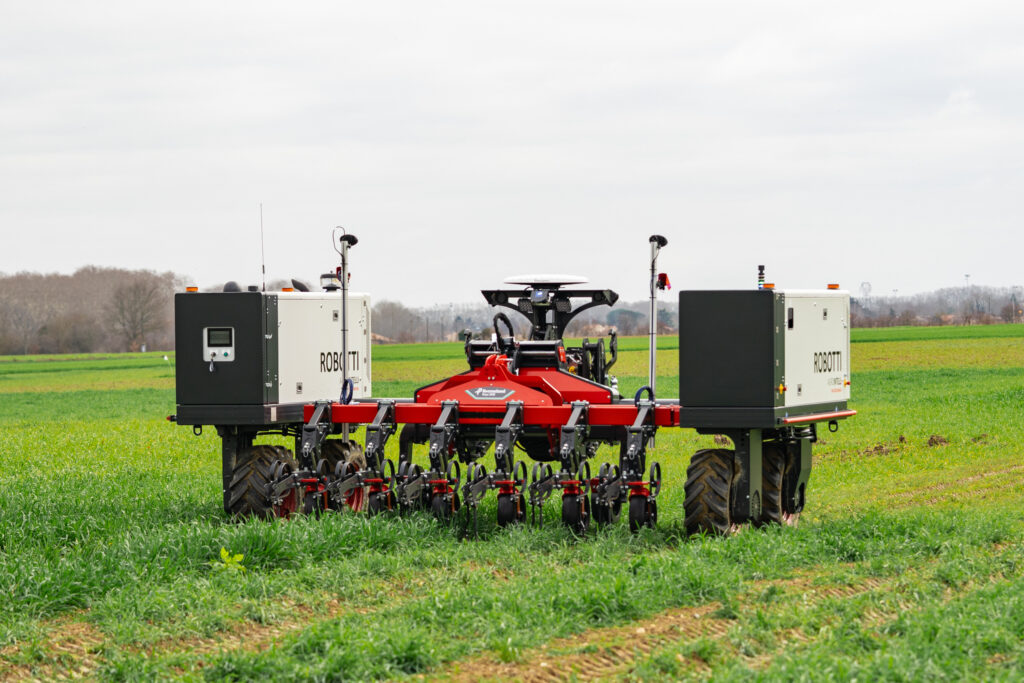
The key difference with the LR is that it has just one 72hp diesel engine, whereas the 150D has a gas-guggling pair. One engine has now been switched out for a larger 300-litre diesel tank, which means the LR can run non-stop for up to 60 hrs before refuelling.
The Robotti boasts a high on-wheel torque, improved hydraulics and a lifting capacity of 1.2t on its Cat 2 linkage. You can opt to have a PTO installed which gives you 540rpm at 14kW/18hp.
The 3t modular design allows you to vary working width from 1.5-3.3m. Typical tasks are seeding, weeding, ridging and spraying, with some of the K.U.L.T. kit ideal for the jobs, propelled autonomously at speeds up to 8km/h. The wider width and speed has come in as a result of the Bosch RexRooth-based hydraulic propulsion system, introduced with the LR in 2022.
At FIRA, Agrointelli was keen to show off its latest advance: Control Tower – software designed to provide farmers with greater control of the Robotti’s autonomous mechanism.
The Robotti has already been driving either in row-by-row scenario, grouped in several rows or in an optimised route-driving pattern. New patterns include “Coiled” as well as “Back and Forth”, claimed to add stability, reduce tilting and side slip while driving, especially when working in vegetables grown in raised beds.
When using this pattern, both sides of the Robotti drive in tracks in the same state, so either both sides are worked or left out. Load-dependent planning allows you to optimise operations based on the capacity of the implement. It means you can specify the maximum area or the number of rows to be worked out, aligning with the available resources.
Also new is Subfield Management, allowing you to sub-divide fields with unconventional shapes and designs. Each subfield is given its own AB line, which means the autonomous driving aligns with field terrain conditions.
“Robotti Control Tower makes constant upgrades and improvements automatically while the machine is online,” notes Ole Green, Agrointelli founder and CEO. “They’re also available for most of our older Robotti versions.”
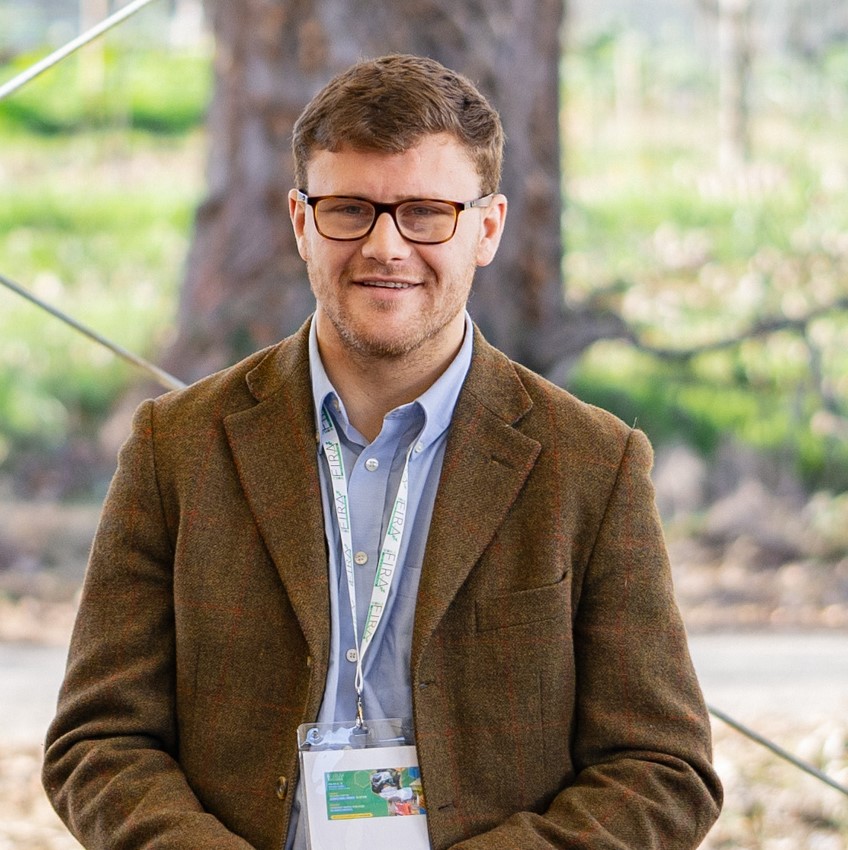
Tom Beach UK farmers can now take advantage of the new precision farming actions available through the Sustainable Farming Incentive (SFI) points out Tom Beach of Autonomous Agri Solutions, UK agents for Agrointelli. “It qualifies for the £150/ha payment for robotic mechanical weeding,” he says.
The cost of owning a Robotti has now been made easier through the Robot as a Service option, which gives you the use of a Robotti with logistics support and full software back-up for £35,000 per year. “The cost in a 2023 pilot in sugar beet worked out at £70/ha per pass over 150ha for drilling and all the weeding – three to four passes,” adds Tom. The robot’s suitable for sugar beet and field vegetables, but “not quite ready” for cereals.
From the Agrobiopôle you can just about see the headquarters of Naïo Technologies, which is where FIRA began. Naïo is the natural host of the event, and the full family of its robots were on display to greet participants.
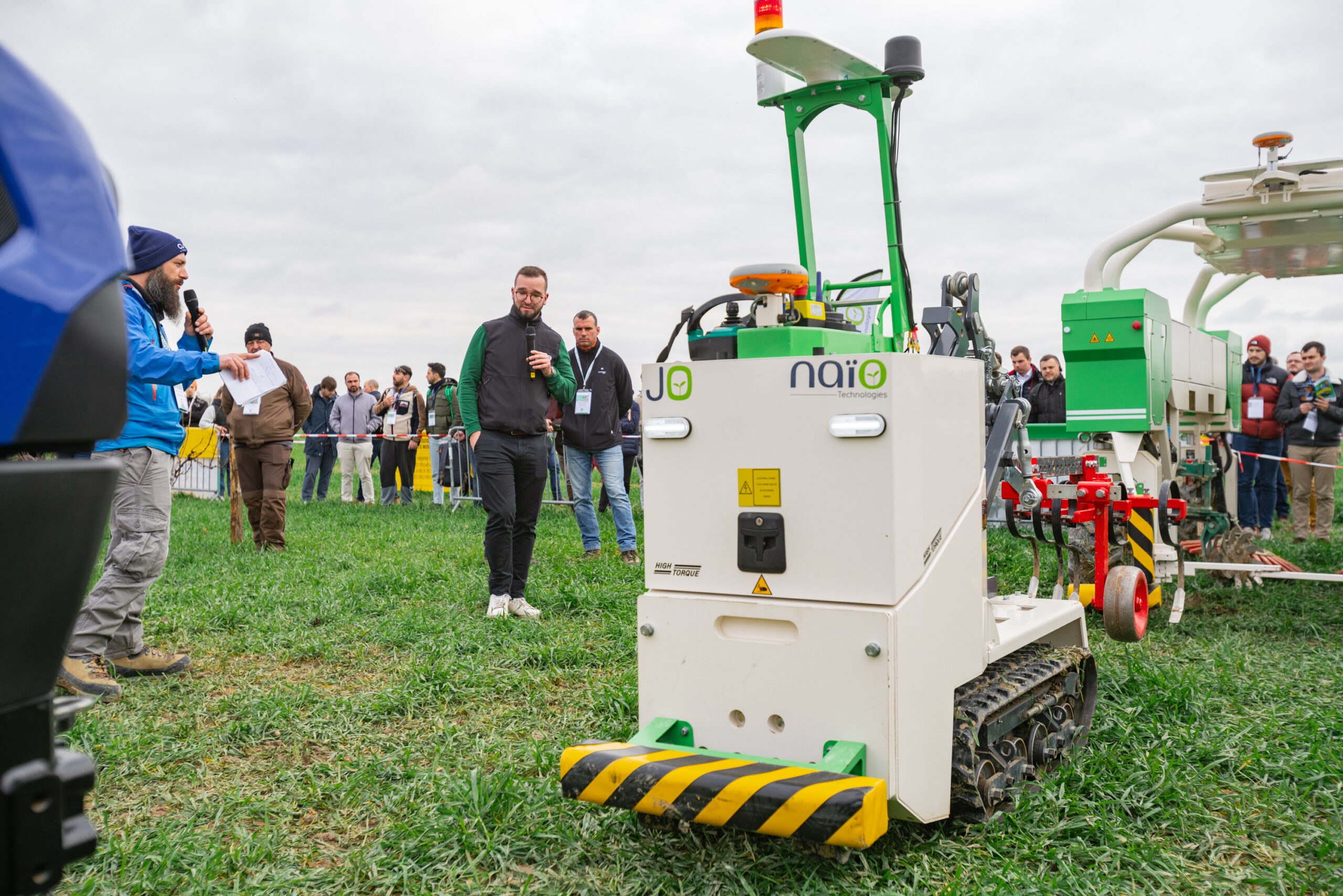
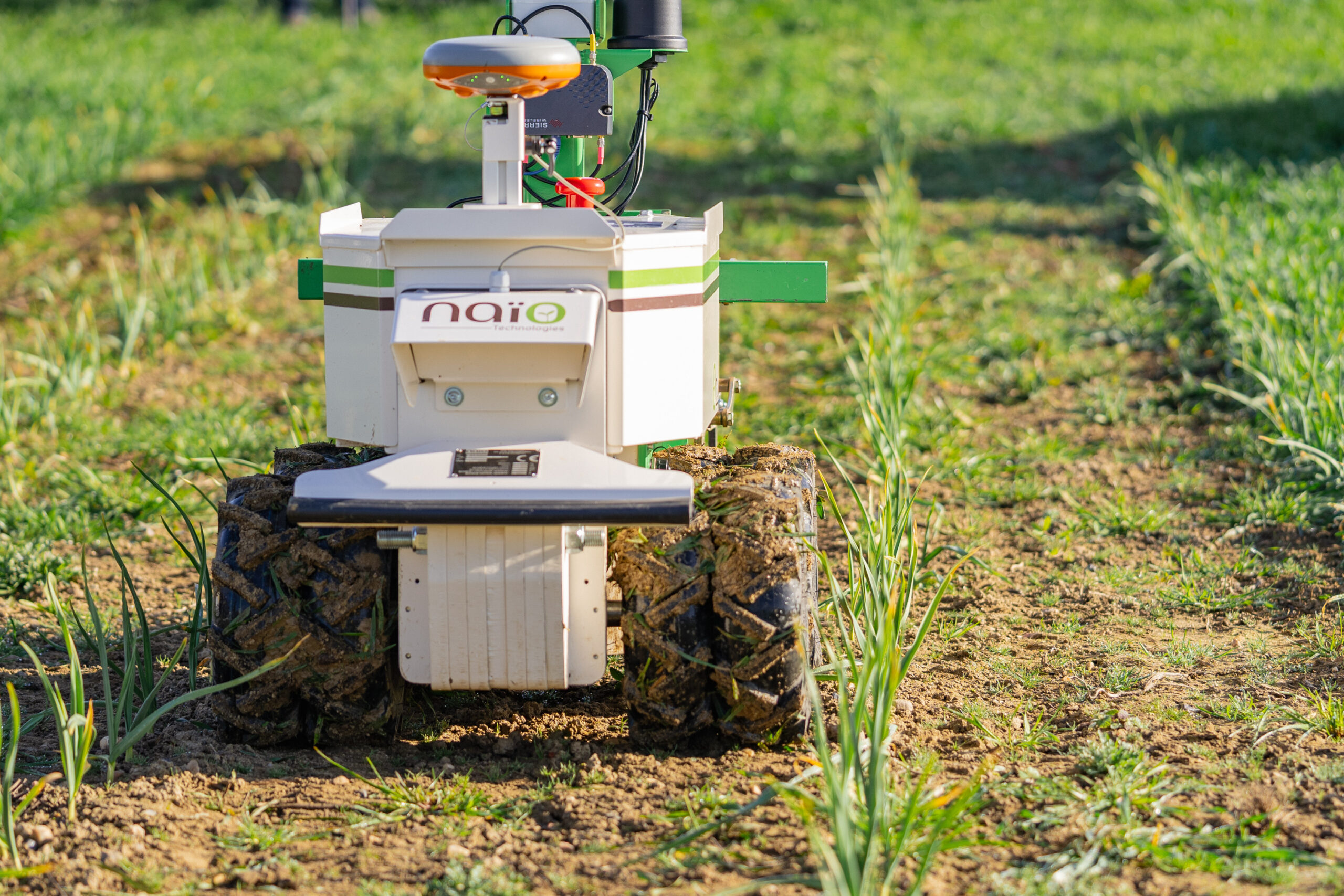

The one to watch is Naïo Orio. Launched in 2022, it’s a seeding, weeding autonomous tool carrier. Orio is 100% electric with a 12kW battery kicking out a 20kW peak from a 21kWh battery pack (32kWh from the HD versions). There are two widths, with the Narrow spanning up to 2.15m and the Large reaching out to 2.38m.
Orio puts the tool carrier on a three-point Cat 2 linkage arm with a 700kg lift in the middle of its chassis, which spans a total length of 4.28m. There’s a range of compatible weeding and seeding tools, including the K.U.L.T. precision hoe, with an optional camera-guided sideshift to add auto-guidance to inter-row weeding. Sugar beet is the furthest into arable row crops you can take the Orio, with field vegetables, tree nurseries and speciality crops, including raised beds, where it’s most at home.
Augmented Agronomy is how Naïo gives its customers the confidence to leave the robots on their own in the field to do the job at hand. Naïo technicians help you create the geofencing maps and teach you how to launch autonomous modes. This complies with CE certification with back-up LIDAR and bumpers in case an unexpected item turns up in Orio’s working area. It’ll then do its thing, on its own, traveling up to 5.5km/h for up to 10hrs on a full charge. Orio is priced at €200,000 (£171,000).
Joining Orio in the field was the Naïo Jo, a compact, tracked autonomous bot that can do mechanical weeding on the row and inter-row, seeding, mowing, furrow tracing and carrying. Just 1m wide, it’s ideal for narrow and hilly vineyards, and also has potential in speciality crops and orchards, running at a maximum speed of 2.2km/h for up to 12hrs on a full charge. “Jo was designed with the Comité Champagne as a machine to manage the narrow vines and really sharp U-turn bends in Champagne vines,” notes Naïo marketing manager Flavien Roussel. It’s priced at €100,000 (£86,000).
Also running in the field was the Naïo Ted, a specialist tool for vineyards that straddles the vine for mechanical weeding and cultivation. A 12kW drivetrain keeps it going for up to eight hours and will set you back €200,000 (£171,000). Then there’s Oz, where it all started for Naïo, with over 300 units now sold. Weighing just 180kg, Oz has a tool carrier that can lift 60kg. It can seed, plant and mechanical weed for up to eight hours on a full battery charge, autonomously working off waypoints with obstacles detected through a pressure-sensitive sensor on the front. It’s priced at €40,000 (£34,000).
“Oz came about from demand by asparagus growers to reduce the labour burden. It’s a tool for smallholders and nurseries with around 2.5ha. The first prototype attracted huge interest, and that’s what got us started,” recalls Flavien. Crowd-funding and a cash injection from the French BPI bank sped the start-up on its way, and it successfully raised a €32M round led by Mirova in November 2022.
The only notable Brit creation at FIRA was Crover. The grain-management tool has lost its curious rattle shape and no longer burrows into the heap. Now it’s a bot that sits on the top of the grain, crawling along on two Archimedes screws with a probe, currently 1.5m long, although a deeper one is in development.

“There were a number of challenges with the burrowing Crover,” explains the company’s Gianlorenzo de Santis. “Navigating accurately was one of them and there was a lot of friction and drag.”
The prototype is expected to be market-ready by the end of the year, and will be available to rent at £5000/yr or buy with its full web platform at £15,000.
The Robot One from Pixelfarming Robotics in the Netherlands drew a crowd. Fully electric, there’s a 13.5kWh battery on board while three large solar panels keep it powered up. Robot One is a weeding tool, working on the principle of “Scan & Act”. It uses 14 high-resolution depth-sensing cameras to create a 3D depth map of the field.
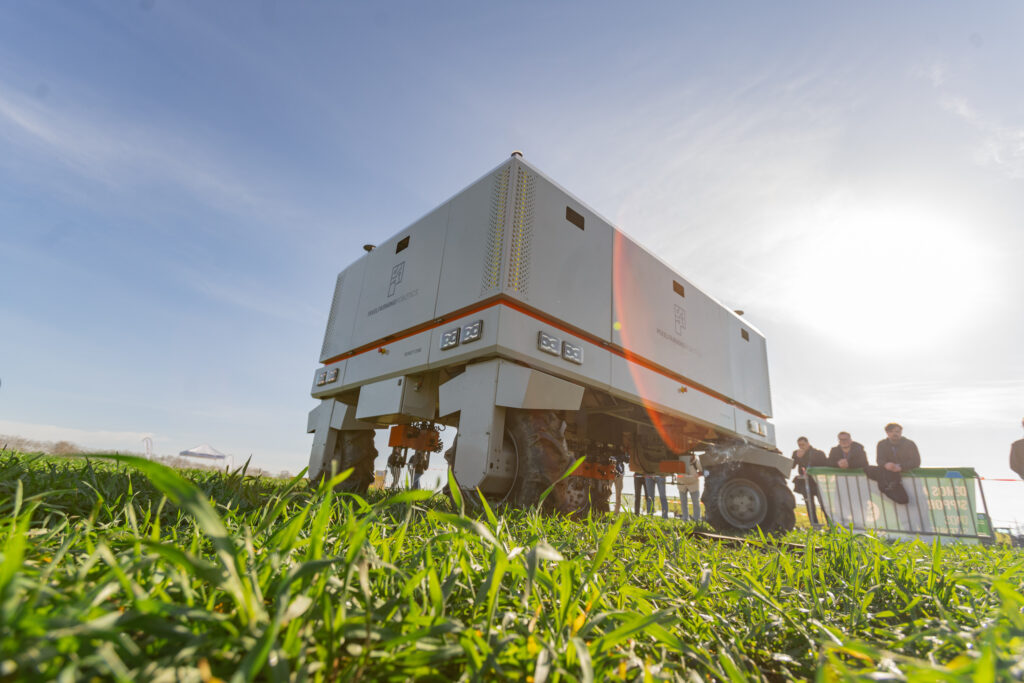
This is when it then gets interesting. The unit can be trained to detect specific weeds that are then targeted for treatment using tools mounted on up to 10 controllable arms that are independently adjustable in row. There are hoes that can be substituted for a streamer, rotor harrow or L-Bow, boasting 2mm accuracy along its 3.5m working width (5m for the Robot One L).
New to the Robot One is laser-weeding with up to 40 130W lasers capable of zapping up to 400,000 weeds per hour. Targeted at the organic and regen market and capable of working relatively large-scale, the Robot One is priced at €249,000 (£213,000).
Odd.Bot chose FIRA to unveil its new Weader that can be mounted onto any self-driving carrier. Twinned with weed-detection software, Weader can identify and precisely remove weeds within the crop rows, even in high-density plantings, without harming the intended crops. With a pull or a push, depending on the size and type of weed, each arm can remove up to two weeds per second.
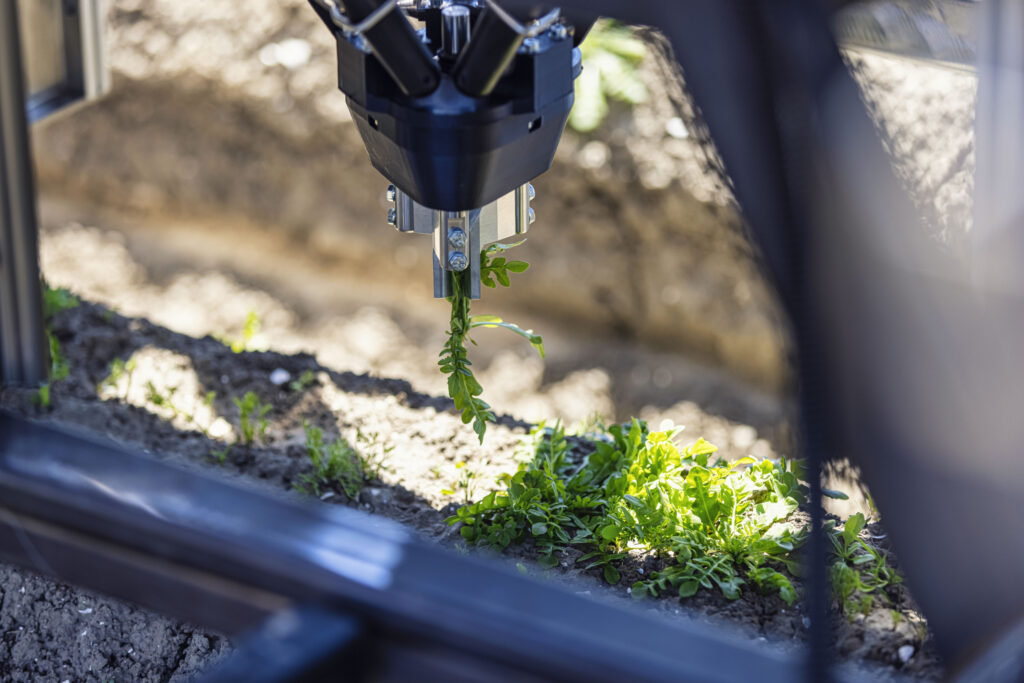
Weed Wacker, voor inflevoland Aimed at organic field vegetable growers, The Weader was developed in the Netherlands through a collaborative initiative with farmers participating in the Odd.Bot Trailblazer Program and Wageningen University.
German autonomous implement manufacturer K.U.L.T. Kress presented its new aiLaser at FIRA. The laser technology can control weeds in the immediate vicinity of the crop without affecting the soil structure from as early as the cotyledon stage. Optical sensors continuously capture images of the crop, with weeds identified through AI, which are denatured in a targeted way by the heat of the laser.
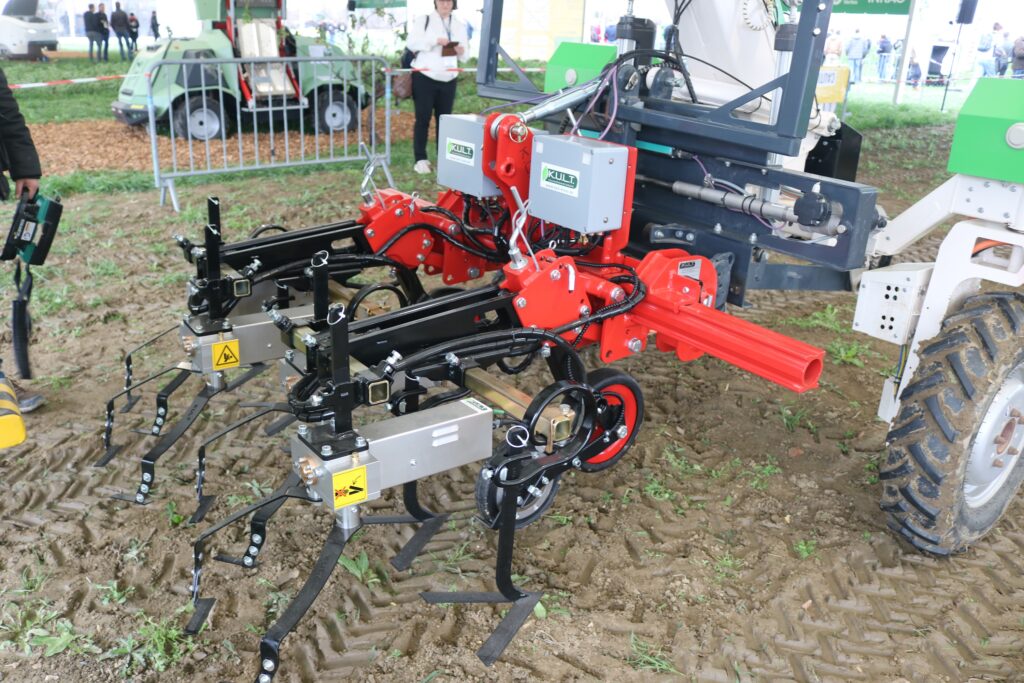
The K.U.L.T. iScan module can also be used to control in-row weeds mechanically. The plant-recognition system analyses images to detect the precise location of crop plants. The InRow eActuators then work in between plants within the row to hoe the soil as close to the crop as possible.





